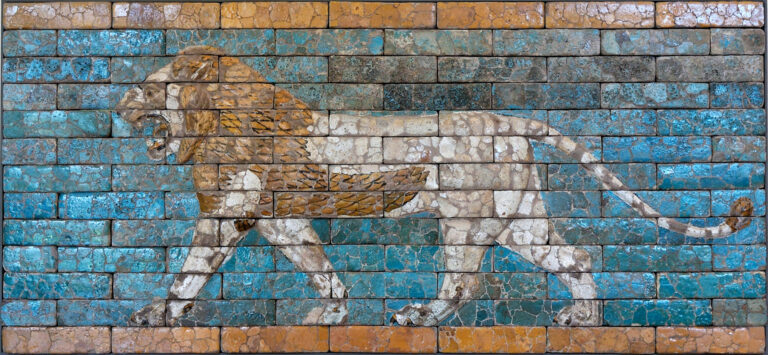Welcome To Iraq

Iraq is a former destination of the hippie trail, a country that has unfortunately disappeared from the tourist radar since the 1980s due to war, terrorism, attacks and violence. Since the war with Iran, the Gulf War, the American invasion of Iraq in 2003 and the battle with the terrorist movement IS, it is advised by governments to avoid the country, time and time again. Currently it’s mostly businessmen, aid workers, diplomats and journalists who sometimes travel to the country.
Traveling in Iraq is dangerous in some parts, although the country is not in ruins and there are millions of people who simply live, work and have fun there. The northern region of Kurdistan still has some kind of tourist infrastructure, where holidaymakers and adventurers still go every year to the cities of Erbil and Sulaymaniyah, the mountains, caves, forests and rivers. The rest of Iraq will need some time to rebuild before the masses can enjoy the many archaeological sites, beautiful cityscapes, fertile valleys and glittering oases.
The country is home to Babylon, once one of the most powerful cities in the world that “was the cradle of our civilization”. The southern port city of Basra was once ‘the Venice of the East’, with its elegant 19th century houses along the canals. And even the capital Baghdad, which has been the center of Islamic culture and scholarship for centuries, has tourism potential, with its national museum, bazaars and the Palace of Abbasid. It is possible to visit some of these magnificent sites with our tour agency.
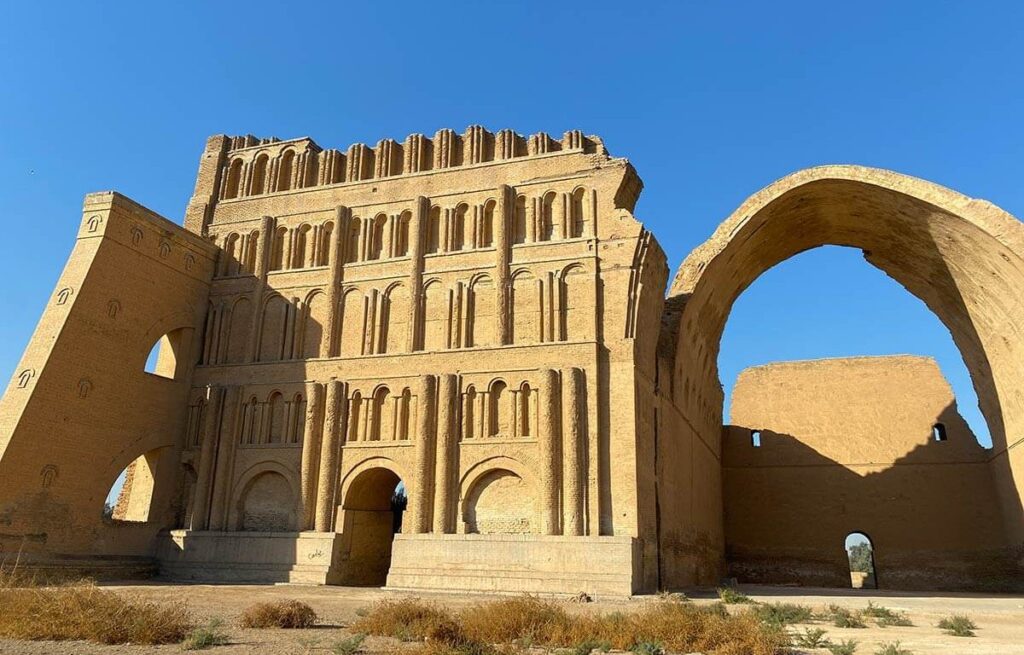
Iraq is a country rich in culture, history and natural beauty. It is home to some of the world’s oldest civilizations, including the Mesopotamian civilization which flourished in the region over 5000 years ago. Visitors can explore ancient archaeological sites such as the ruins of Babylon, Nineveh, and Ur.
Besides culture, Iraq also boasts stunning natural scenery, including the Mesopotamian Marshes, which are a unique wetland ecosystem and home to many rare and endangered species of plants and animals. The country is also home to beautiful mountain ranges, such as the Zagros Mountains, which provide opportunities for hiking, trekking and skiing.
Iraqi cuisine is known for its rich and diverse flavors, blending influences from Persian, Turkish, and Arab cuisines. Visitors can sample traditional dishes such as biryani, kebabs, and falafel, as well as delicious sweets like baklava and kunafa.
While Iraq has faced significant challenges in recent years, the country is slowly recovering and rebuilding. Visitors to Iraq can contribute to this process by supporting local businesses and communities, and by engaging with the country’s rich cultural heritage and history. While there are risks associated with travel to Iraq, with proper preparation and precautions, it can be a rewarding and unforgettable destination for those interested in history, culture, and adventure.

If you’re looking for a reliable and trustworthy tour operator in Iraq, look no further than us. Our company has been operating for years and has a proven track record of providing exceptional service and unforgettable experiences to our clients.
One of the main reasons why you can trust our agency is our commitment to safety. We take the safety and security of our clients very seriously, and we have rigorous safety protocols in place to ensure that our tours are safe and secure. Our guides are highly trained and experienced, and they are well-versed in the local customs and culture, which ensures that our clients have a smooth and enjoyable trip.
We also pride ourselves on providing personalized service. We understand that every traveler is unique, and we strive to tailor our tours to meet the specific needs and interests of our clients. Whether you’re interested in history, culture, or adventure, we have a tour that will suit your interests and preferences.
Another reason to work with us is our commitment to sustainability. We believe that responsible tourism is essential for the long-term health and well-being of the communities we visit, and we work closely with local communities to ensure that our tours have a positive impact on the environment and the local economy.
Traveling In Iraq
Traveling in Iraq can be a fascinating and rewarding experience for those who are interested in history, culture, and adventure. While the country has faced significant challenges in recent years, including political instability, sectarian violence, and terrorism, it is slowly recovering and rebuilding, and there is much to see and explore in this ancient land.

One of the most popular destinations for travelers in Iraq is the capital city of Baghdad. Baghdad has a rich and colorful history, dating back over 1,000 years, and it is home to some of the most important cultural and historical sites in the country. Visitors can explore the ancient city of Samarra, which was the capital of the Abbasid Caliphate during the 9th century, and the magnificent Al-Mustansiriya Madrasa, which was one of the most important centers of Islamic scholarship during the Middle Ages.
Another must-see destination in Iraq is the city of Babylon. Babylon was one of the most important cities of the ancient world, and it is home to some of the most impressive ruins from the Mesopotamian era. Explore the ruins of the famous Hanging Gardens of Babylon, which were one of the Seven Wonders of the Ancient World, as well as the remains of the Ishtar Gate, which was once the main entrance to the city.

For those who are interested in natural beauty, the Mesopotamian Marshes are a must-visit destination. These unique wetlands are home to a diverse range of flora and fauna, including many rare and endangered species. You can visit the marshes by boat or on foot, and they can learn about the traditional way of life of the Marsh Arabs, who have lived in the region for centuries.
In addition to these popular destinations, Iraq is also home to many other fascinating sites and attractions. The ancient city of Ur, which is believed to be the birthplace of the prophet Abraham, is a must-see destination for those interested in biblical history, while the mountain ranges of Kurdistan offer some of the most spectacular hiking and trekking opportunities in the Middle East.
Of course, traveling in Iraq can also present some challenges and risks, and it is important for travelers to take the necessary precautions to ensure their safety. It is recommended that travelers obtain comprehensive travel insurance and consult with a reputable tour operator before embarking on a trip to Iraq. It is also important to stay informed about the current political and security situation in the country, and to avoid traveling to areas that are deemed unsafe or off-limits.
In terms of culture, Iraq is home to a rich and diverse population, with Arab, Kurdish, and Assyrian communities making up the majority of the population. Experience the vibrant and colorful bazaars of Baghdad, where you can buy everything from spices and textiles to handcrafted pottery and jewelry. Sample the delicious and exotic cuisine of Iraq, which is influenced by the flavors and traditions of the Middle East and the Mediterranean.

For those who are interested in history, Iraq is home to some of the most important archaeological sites in the world. Visitors can explore the ruins of ancient cities like Babylon, Ur, and Nineveh, and they can learn about the fascinating civilizations that once thrived in this region, including the Sumerians, Babylonians, and Assyrians.
Traveling in Iraq is a unique and unforgettable experience, offering you the chance to explore a country that is steeped in history, culture, and natural beauty. While there are risks and challenges associated with traveling to Iraq, those who take the necessary precautions and work with a reputable tour operator can have a safe and rewarding journey. From the bustling streets of Baghdad to the ancient ruins of Babylon, Iraq offers a wealth of experiences. Come explore Iraq with Iraq Travel And Tours!
Is It Safe To Travel To Iraq?
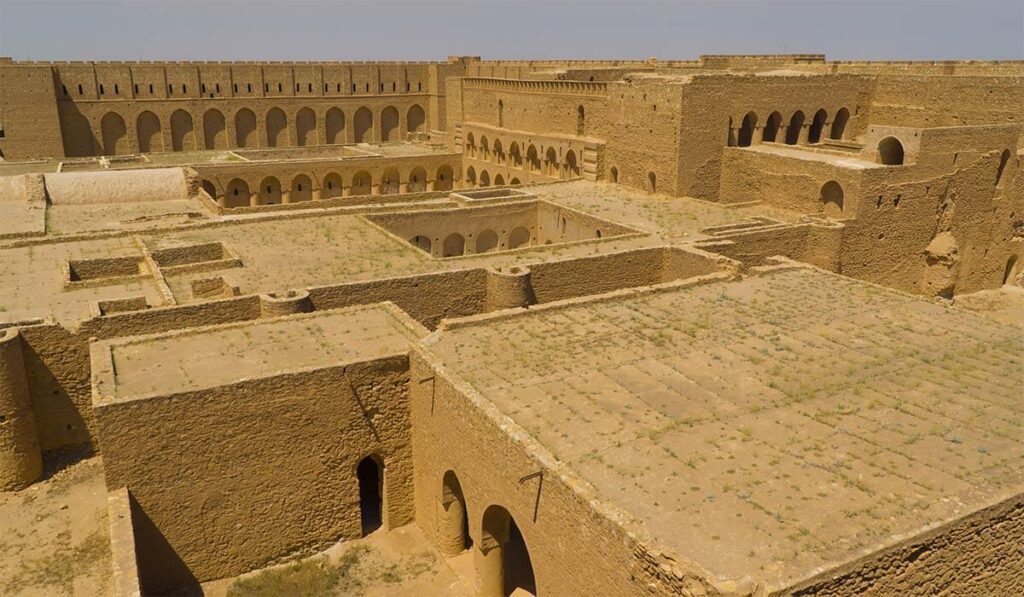
Iraq is a country that has undergone significant changes over the past few years, and as such, it is a destination that many travelers are eager to explore. While the country has experienced political instability and security concerns in the past, the situation has improved significantly in recent years, making it a more viable travel option for those seeking an adventure in the Middle East.
As of 2023, it is generally safe to travel to certain parts of Iraq, but it is still important to exercise caution and do your research before embarking on a journey to this fascinating country. The Kurdistan region in the north of the country is considered one of the safest areas for travelers, with a stable political situation and a low level of crime. The cities of Erbil and Sulaymaniyah, in particular, are popular destinations for tourists, with a range of attractions such as ancient bazaars, historic sites, and stunning natural landscapes.
On the other hand, some parts of Iraq are still considered unsafe for travel due to ongoing conflict and security concerns. The western and central parts of the country, including the cities of Mosul and Ramadi, are currently considered high-risk areas due to the presence of ISIS and other armed groups. In addition, the border areas with Syria and Iran are also considered to be unsafe due to the ongoing conflict in those regions.
Despite these challenges, there are several reasons why it is safe to travel to certain parts of Iraq in 2023. First and foremost, the security situation in the Kurdistan region has improved significantly over the past few years, with the Kurdish Regional Government (KRG) investing heavily in security measures and working to improve relations with neighboring countries. The KRG has also implemented several initiatives to promote tourism in the region, including the launch of a new e-visa system that makes it easier for visitors to obtain a visa on arrival.
In addition, the people of Iraq are known for their warm hospitality and welcoming nature, and travelers who do venture to the country are likely to be met with open arms. The local cuisine, which features a mix of Middle Eastern and Mediterranean flavors, is also a highlight for many visitors, with dishes such as kebabs, falafel, and hummus being popular staples.
Of course, it is still important to take certain precautions when traveling to Iraq. Visitors should stay up to date on the latest travel advisories and consult with a reputable travel agency or tour operator before booking a trip. It is also advisable to travel with a local guide who is familiar with the area and can provide valuable insights and assistance during your journey.
While Iraq is still facing security challenges in some areas, it is a country that is slowly but surely opening up to tourists from around the world. With its rich history, fascinating culture, and warm hospitality, Iraq offers a unique and rewarding travel experience for those who are willing to venture off the beaten path and explore this fascinating corner of the Middle East.
When traveling in Iraq, it is important to remain vigilant at all times and exercise caution in crowded areas or places with a high concentration of foreigners. It is also recommended to dress modestly, respect local customs and traditions, and avoid taking photographs of people or sensitive sites without permission. Make sure you contact your embassy before going to Iraq and to be updated about the latest safety information.
Nine Must Visit Destinations In Iraq
Iraq, once the land of Mesopotamia, is a country full of historical and cultural significance. The ancient civilizations that thrived in Iraq have left behind a wealth of ruins, relics, and monuments that attract tourists from all over the world. Iraq is also home to breathtaking natural scenery, including vast deserts, snow-capped mountains, and pristine waterfalls. Despite facing challenges in recent years, Iraq is emerging as a tourism destination that is both fascinating and unique. Here are the top nine travel destinations in Iraq if you want to focus on the main highlights.

Summary
Baghdad: Baghdad, the capital city of Iraq, is a melting pot of cultures and traditions. The city has a rich history, with numerous attractions like the National Museum of Iraq, the Baghdad Zoo, and the Al-Mutanabbi Street book market.
Erbil: Erbil, the capital of the Kurdish region, is one of the oldest continuously inhabited cities in the world. The city is known for its stunning citadel, which has been designated a UNESCO World Heritage Site.
Najaf: Najaf is a holy city for Shiite Muslims, and it is home to the Imam Ali Shrine, one of the most revered religious sites in the world.
Basra: Basra is a bustling port city that has been a trading hub for centuries. The city has a rich cultural heritage and is home to numerous historic sites, including the Basra Museum and the Great Mosque of Basra.
Samarra: Samarra is a UNESCO World Heritage Site that is famous for its Great Mosque and the Al-Askari Shrine. The city also has several ancient ruins and a unique spiral minaret that is worth visiting.
Babylon: Babylon is an ancient city that was once one of the most important cultural and political centers of the world. The city has numerous ruins and monuments, including the Ishtar Gate and the Hanging Gardens.
Karbala: Karbala is another holy city for Shiite Muslims, and it is home to the Imam Husayn Shrine, one of the most important religious sites in the world.
Kirkuk: Kirkuk is a city that has been inhabited for over 5,000 years. The city has a rich history and is home to numerous historic sites, including the Kirkuk Citadel and the Kirkuk Museum.
The Marshes: The Marshes are a unique natural wonder that is located in southern Iraq. The Marshes are home to numerous species of birds and animals, including the Marsh Arab people who have lived in the area for centuries.
1. Baghdad

Baghdad is the capital and largest city of Iraq, located on the Tigris River in the heart of Mesopotamia. The city has a rich history that dates back to the Abbasid Caliphate, which established Baghdad as its capital in the 8th century CE. Under the Abbasid dynasty, Baghdad flourished as a center of trade, culture, and learning. It was home to renowned scholars, philosophers, and scientists who made significant contributions to fields like mathematics, astronomy, medicine, and literature.
During the medieval period, Baghdad was known as the “City of Peace” and was one of the largest and most prosperous cities in the world. However, the city was invaded and destroyed several times by foreign powers like the Mongols and the Persians, leading to a decline in its fortunes. In the 20th century, Baghdad became the capital of modern Iraq after the country gained independence from British colonial rule.
Baghdad is a vibrant and dynamic city with a unique blend of old and new. It has a wealth of attractions that showcase the city’s rich history and cultural heritage. Some of the top tourism attractions in Baghdad include:
The National Museum of Iraq: The museum houses a vast collection of artifacts and exhibits that showcase the country’s rich cultural heritage. It includes items from ancient Mesopotamia, Islamic art, and contemporary Iraqi art.
The Baghdad Zoo: The zoo is one of the largest and oldest in the Middle East, with a wide range of exotic animals like lions, tigers, bears, and monkeys.
Al-Mutanabbi Street: This famous street is named after the famous Iraqi poet Abu al-Tayyib al-Mutanabbi and is home to many bookshops and literary cafes.
The Al-Shaheed Monument: This iconic landmark is a tribute to the Iraqi soldiers who died in the Iran-Iraq War and the Gulf War. It is a massive arch-shaped structure that is illuminated at night.
The Al-Mustansiriya School: This historic school is one of the oldest and most prestigious universities in the world. It was founded in the 13th century and was a center of learning for Islamic scholars.
The Baghdad Tower: The tower is a modern landmark that offers stunning panoramic views of the city. It is the tallest structure in Iraq, standing at 205 meters tall.
2. Erbil

Erbil, also known as Hawler, is the capital city of the Kurdistan Region in Iraq. The city has a rich history that dates back over 7,000 years, making it one of the oldest continuously inhabited cities in the world. Erbil was an important center of trade and commerce on the ancient Silk Road and was ruled by various empires, including the Akkadians, Assyrians, Babylonians, and Persians.
During the Islamic Golden Age, Erbil became a center of learning and scholarship, producing renowned scholars and intellectuals like the famous physician, Al-Razi. The city was also a hub of religious activity, with numerous mosques, madrasas, and Sufi shrines dotting the landscape.
Erbil is a bustling and modern city with a vibrant cultural scene and many attractions for tourists. The following destinations should be on your list while traveling to Erbil:
The Erbil Citadel: This historic citadel is the centerpiece of the city and is a UNESCO World Heritage Site. The citadel is over 6,000 years old and has been inhabited continuously throughout its history.
The Kurdish Textile Museum: This museum showcases the traditional clothing and textiles of the Kurdish people, with exhibits that include beautiful woven carpets, kilims, and other textiles.
The Qaysari Bazaar: This bustling market is one of the oldest in the city and offers a wide range of goods, from spices and textiles to jewelry and souvenirs.
The Jalil Khayat Mosque: This beautiful mosque is one of the largest and most ornate in Erbil, with intricate tilework, beautiful calligraphy, and a large central dome.
The Kurdish Textile Museum: This museum showcases the traditional clothing and textiles of the Kurdish people, with exhibits that include beautiful woven carpets, kilims, and other textiles.
The Sami Abdul Rahman Park: This large park is a popular destination for families and offers a range of activities, including a lake, boating, and children’s playgrounds.
3. Najaf
Najaf is a city in central Iraq, located approximately 160 km south of Baghdad. It is considered one of the holiest cities in the Shia Muslim world and has a rich history that dates back to ancient times. The city is famous for its religious significance, having been the burial site of Imam Ali, the fourth caliph of Islam and the cousin and son-in-law of the Prophet Muhammad.

Najaf has been a center of religious scholarship and learning for over a thousand years. The city has been home to many famous Shia scholars and religious figures, and it is the site of many important religious institutions and seminaries.
Today, Najaf is a popular destination for Shia pilgrims from all over the world, and it offers a range of tourism attractions for visitors. Some of the top attractions in Najaf include:
The Imam Ali Shrine: This is the most important religious site in Najaf and is the burial place of Imam Ali. The shrine is one of the largest in the world and is covered in beautiful tilework and calligraphy.
The Wadi Al-Salaam Cemetery: This is one of the largest and most historic cemeteries in the world, with over five million graves. Many Shia religious figures and scholars are buried here, including Imam Ali’s son, Imam Hussain.
The Al-Manzariyah School: This historic school is one of the oldest and most prestigious in the Shia world. It was founded in the 12th century and has been a center of Islamic scholarship and learning ever since.
The Al-Nu’man Mosque: This beautiful mosque was built in the 10th century and is known for its stunning architecture and intricate tilework.
The Najaf Museum: This museum houses a collection of artifacts and exhibits that showcase the history and culture of Najaf, including rare manuscripts and historic documents.
The Najaf Market: This bustling market is a popular destination for tourists and locals alike. It offers a wide range of goods, including spices, textiles, jewelry, and souvenirs.
4. Basra
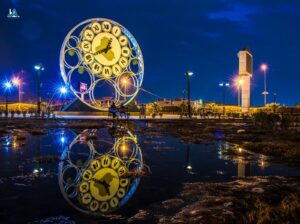
Basra is a city in southern Iraq, situated on the Shatt al-Arab river. It is considered one of the oldest continuously inhabited cities in the world and has a rich and fascinating history. Basra has been an important center of trade and commerce since ancient times and has been ruled by a variety of empires, including the
Akkadians, Babylonians, Persians, and Arabs.
During the Islamic Golden Age, Basra was a center of learning and scholarship, producing famous scholars and intellectuals like the philosopher Al-Kindi and the historian Al-Masudi. The city was also a hub of trade and commerce, with a thriving port that was a major gateway for goods from India and China.
Today, Basra is a modern city with a rich cultural heritage and many attractions for travelers. Some of the must-visit destinations in Basra are:
The Basra Museum: This museum houses a collection of artifacts and exhibits that showcase the history and culture of the city and the wider region. It includes a range of objects from ancient times to the present day, including pottery, coins, and weapons.
The Basra Sports City: This state-of-the-art sports complex is a popular destination for sports fans, with facilities for football, basketball, volleyball, and more.
The Basra Waterfront: This recently developed area is a popular spot for tourists, with a range of restaurants, cafes, and shops overlooking the river. It also includes a large Ferris wheel and other attractions.
The Shatt al-Arab River: This important waterway is a popular destination for boat tours and offers a fascinating glimpse into the city’s history and culture.
The Shaheed al-Mihrab Mosque: This beautiful mosque is one of the most important religious sites in Basra and is known for its stunning architecture and intricate tilework.
The Safwan Border Crossing: This border crossing is located on the southern edge of the city and offers a gateway to neighboring Kuwait and Saudi Arabia.
5. Samarra

Samarra is a city located in central Iraq, approximately 125 km north of Baghdad. It is an ancient city with a rich history that dates back over a thousand years. The city was founded during the Abbasid period and was the capital of the Abbasid Caliphate from 836 to 892 AD. During this time, Samarra was a center of Islamic scholarship and culture, producing many famous scholars, artists, and architects.
The city is known for its unique architecture, including the famous Malwiya Tower, a spiraling minaret that is one of the most recognizable landmarks in Iraq. Samarra also has many other important historical sites, including the Great Mosque of Samarra, which was one of the largest mosques in the world when it was built.
Today, Samarra is a great destination for those who are interested in history and architecture. Some of the top tourism destinations in Samarra include:
The Great Mosque of Samarra: This mosque is one of the most important and impressive Islamic architectural sites in the world. It was built in the 9th century and is famous for its large minaret and ornate stucco decorations.
The Malwiya Tower: This iconic tower is a symbol of Samarra and is one of the most recognizable landmarks in Iraq. It is a unique example of Islamic architecture and is known for its spiral shape and intricate brickwork.
The Al-Askari Shrine: This important Shia shrine is located in the nearby city of Samarra and is the burial place of two of the twelve Shia Imams. The shrine is known for its beautiful golden dome and is a popular destination for Shia pilgrims from around the world.
The Samarra Archaeological Museum: This museum houses a collection of artifacts and exhibits that showcase the history and culture of Samarra and the surrounding region. It includes a range of objects from ancient times to the present day, including pottery, coins, and weapons.
The Abbasid Palace Complex: This palace complex was built in the 9th century and was the residence of the Abbasid caliphs. It includes a range of buildings and structures, including the famous Throne Hall.
The Al-Mutawakkil Mosque: This beautiful mosque was built in the 9th century and is known for its ornate decorations and intricate tilework.
6. Babylon

Babylon is an ancient city located in central Iraq, approximately 85 km south of Baghdad. It was one of the most important cities of the ancient world and is known for its rich history and cultural heritage. The city was founded in the 18th century BC and was the capital of the Babylonian Empire, which was one of the most powerful empires of the ancient world.
During its heyday, Babylon was a center of learning, trade, and culture. The city was known for its impressive architecture, including the famous Hanging Gardens of Babylon, which were one of the Seven Wonders of the Ancient World. The city was also home to many important historical figures, including the famous king Hammurabi, who is known for his famous law code.
Babylon is a great destination for those who are interested in history and archaeology. Some ideas of what to see in Babylon:
The Ishtar Gate: This impressive gate is one of the most important historical sites in Babylon. It was built in the 6th century BC and is known for its ornate decorations and intricate tilework.
The Hanging Gardens of Babylon: Although the Hanging Gardens no longer exist, they are still an important part of Babylon’s cultural heritage. The gardens were built in the 6th century BC and were known for their impressive irrigation system and beautiful greenery.
The Babylon Archaeological Site: This site includes a range of important historical structures and ruins, including the Temple of Marduk, the Palace of Nebuchadnezzar II, and the famous Lion of Babylon statue.
The Babylon Museum: This museum houses a collection of artifacts and exhibits that showcase the history and culture of Babylon and the wider region. It includes a range of objects from ancient times to the present day, including pottery, coins, and weapons.
The Babylon Fortress: This impressive fortress was built in the 6th century BC and was an important part of the city’s defense system.
The Babil Governorate: This region includes a range of important historical and cultural sites, including the famous Ziggurat of Borsippa and the ancient city of Nippur.
7. Karbala

Karbala is an important city located in central Iraq, approximately 100 km southwest of Baghdad. The city is known for its rich history and cultural significance in the Islamic world. It is particularly important for Shia Muslims, who believe that it was the site of the martyrdom of Hussein ibn Ali, the grandson of the Prophet Muhammad.
The history of Karbala is closely tied to the history of Islam. In the 7th century, the city was the site of a major battle between the forces of Hussein ibn Ali and the Umayyad Caliphate. Hussein and his followers were ultimately defeated, and Hussein was martyred, along with many of his family members and followers. This event is commemorated every year during the Islamic month of Muharram, when millions of Shia Muslims make pilgrimages to Karbala to pay their respects.
The following attractions should be on your list when you travel to Karbala:
The Imam Hussein Shrine: This shrine is one of the most important religious sites in the world for Shia Muslims. It contains the tomb of Hussein ibn Ali and is considered to be one of the holiest places in Islam.
The Abbasid Palace: This historic palace was built in the 8th century and was once the residence of the Abbasid Caliphs.
The Al-Qibla Mosque: This mosque is known for its beautiful architecture and is an important place of worship for Muslims.
The Al-Hurr Museum: This museum houses a collection of artifacts and exhibits related to the history of Karbala and the wider region. It includes a range of objects from ancient times to the present day, including pottery, coins, and weapons.
8. Kirkuk
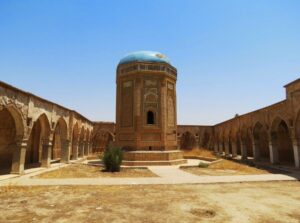
Kirkuk is a city located in northern Iraq, approximately 250 km north of Baghdad. The city is known for its rich history and cultural significance, particularly for its role in the oil industry. The city has been inhabited since ancient times and has been ruled by a number of different empires and civilizations over the years.
The history of Kirkuk is closely tied to the history of the oil industry in Iraq. In the early 20th century, oil was discovered in the region, and Kirkuk became an important center for the production and export of oil. This led to a period of rapid growth and development, with many new buildings and infrastructure projects being built in the city.
A few of the most important places to visit in Kirkuk:
The Kirkuk Citadel: This historic citadel is one of the most important landmarks in Kirkuk. It was built in the 12th century and was used as a military fortification for many years.
The Kirkuk Museum: This museum houses a collection of artifacts and exhibits related to the history and culture of Kirkuk and the wider region. It includes a range of objects from ancient times to the present day, including pottery, coins, and weapons.
The Oil Museum: This museum is dedicated to the history and importance of the oil industry in Kirkuk and Iraq as a whole. It includes exhibits on the history of oil production in the region and the impact of the oil industry on the local economy.
The Qaysari Bazaar: This historic bazaar is one of the oldest and most important markets in Kirkuk. It is known for its traditional architecture and its wide range of goods and products, including textiles, spices, and jewelry.
9. The Marshes
The marshes of Iraq are a unique and fascinating destination that offer visitors a glimpse into a way of life that has existed for thousands of years. These wetlands, located in the southern part of the country, are home to a rich and diverse ecosystem, as well as a vibrant culture that has developed in and around the marshes over centuries.
For many travelers, a visit to the marshes of Iraq is a must-do experience. Not only does it offer a chance to witness the natural beauty of this unique ecosystem, but it also provides an opportunity to learn about the history and culture of the people who live in and around the marshes.

One of the most popular activities is a boat tour on which you go on a journey through the canals and waterways of the marshes, providing a unique perspective on the local flora and fauna. Explore the traditional villages that dot the marshes, meeting locals and learning about their way of life.
For those interested in history, the marshes of Iraq also offer a chance to explore some of the ancient ruins and archaeological sites that are found throughout the region. This includes the remains of ancient cities, temples, and other structures that have been uncovered in recent years.
A visit to the marshes of Iraq is a must-do experience for anyone interested in nature, culture, and history. With its unique ecosystem and rich cultural heritage, this destination offers a one-of-a-kind travel experience that is sure to leave a lasting impression on all who visit.
The Sixteen Most Beautiful Destinations To Visit In Iraq
Iraq is a country located in the Middle East, with a rich cultural heritage and history dating back to ancient civilizations. Despite facing challenges and conflicts in recent decades, Iraq has remained a fascinating and unique destination for travelers seeking to discover the natural beauty and cultural treasures of the region. Iraq is a land of contrasts, with vast deserts, fertile valleys, majestic mountains, and bustling cities that offer visitors an unforgettable travel experience.
One of the most compelling reasons to visit Iraq is its rich history and cultural heritage. The country is home to many ancient sites and monuments that testify to the contributions of its people to the development of human civilization. For instance, the Mesopotamian civilization, which emerged in the region between the Tigris and Euphrates rivers, is regarded as one of the earliest civilizations in the world. You’ll explore the ruins of ancient cities like Babylon, Ur, and Nineveh, which offer insights into the achievements of the people who once inhabited these areas.
Moreover, Iraq is a country of unparalleled natural beauty. The country boasts vast deserts like the Anbar desert, which offers a stunning and otherworldly landscape of sand dunes and rock formations. Make sure to visit the marshlands of southern Iraq, a unique ecosystem that is home to many rare species of birds and other wildlife. In the Kurdish region of Iraq, you’ll enjoy the breathtaking views of the Zagros Mountains and explore the many natural springs and valleys that are scattered throughout the region.
Finally, Iraq is a country of warm and hospitable people who are known for their generosity and kindness towards visitors. Despite the challenges they have faced, Iraqis are eager to share their culture and history with visitors and to showcase the beauty of their country.
Here’s a brief overview of some of the best activities and places to visit during your travel to Iraq.
Ctesiphon – Located near Baghdad, Ctesiphon is an ancient city that served as the capital of the Parthian and Sasanian empires. Explore the remains of the city’s grand palace and the world’s largest brick-built arch, the Taq Kasra.
Gomi Felaw – Gomi Felaw is a picturesque village located in the mountains of Kurdistan. Enjoy the stunning views of the surrounding landscape and discover the traditional Kurdish architecture and lifestyle of the villagers.
Rabban Hormizd Monastery – Founded in the 7th century, Rabban Hormizd Monastery is one of the oldest and most important Christian monasteries in Iraq. Admire the intricate carvings and frescoes that adorn the monastery’s walls and learn about its rich history.
Old Najaf – Najaf is one of the holiest cities in Shia Islam and located in Southern Iraq. Visit the city’s old quarter and visit the Imam Ali Shrine, the burial place of Ali, the cousin and son-in-law of the Prophet Muhammad.
Shanidar Cave – Located in the Zagros Mountains, Shanidar Cave is an important archaeological site that has yielded significant discoveries about the Neanderthals who once inhabited the area. Explore the cave and learn about the ancient human history of the region.
The Mesa of Amedi – Amedi is a historic town in Kurdistan that is famous for its dramatic mesa, which towers over the surrounding landscape. Wonder in the town’s narrow streets and traditional architecture and enjoy the stunning views from the top of the mesa.
The Mosul Ruins – Once a thriving city, Mosul was heavily damaged during the recent conflict in Iraq. Despite this, you can still see some of the city’s ancient sites and monuments, including the 13th-century mosque of Ibn Tulun and the ruins of the ancient city of Nineveh.
Al-Mutanabbi Street in Baghdad – Al-Mutanabbi Street is the cultural heart of Baghdad, lined with bookstores, cafes, and markets that offer a glimpse into the vibrant intellectual and artistic life of the city. Browse the many shops and soak up the lively atmosphere of this iconic street.
The Al-Ukhaidir Fortress – Near Karbala, the Al-Ukhaidir Fortress is an impressive 8th-century structure that once served as a military outpost. Get to see the fortress’s thick walls and towers and learn about its important role in Iraq’s history.
The Akre Landscape – Akre is a town in Kurdistan that is famous for its beautiful landscape of hills, valleys, and streams. Admire the town’s historic citadel and enjoy the stunning views from its lofty heights.
Explore the Iraqi Marshes – The Iraqi Marshes are a unique ecosystem that has been inhabited by the Marsh Arabs for thousands of years. Go on an adventure on the region’s waterways and see the traditional houses and lifestyles of the Marsh Arabs.
The City of Lalish – Lalish is the holiest site of the Yazidi religion, an ancient faith that is unique to Iraq. Get to know the city’s sacred shrines and learn about the Yazidi people and their culture.
Imam Hussein’s Shrine in Karbala – Karbala is one of the most important cities in Shia Islam and is home to the shrine of Imam Hussein, the grandson of the Prophet Muhammad. Explore the shrine and learn about the tragic events that led to his martyrdom.
Babylon – Located near Baghdad, Babylon is an ancient city that was once one of the greatest centers of civilization in the world. See the ruins of the city’s grand palaces and temples and learn
The Great Ziggurat of Ur – Located in southern Iraq, the Great Ziggurat of Ur is an ancient temple that dates back to the Sumerian civilization. You can explore the massive stepped pyramid and learn about the religious practices and beliefs of the ancient Sumerians.
The spiraling minaret of Samarra – The Great Mosque of Samarra is home to one of the most unique and iconic structures in Iraq, a spiraling minaret that rises over 50 meters in height. Visit the mosque and marvel at the intricate design and decoration of this impressive structure.
1. Ctesiphon
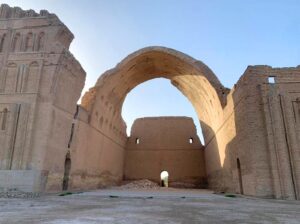
Ctesiphon is an ancient city located on the banks of the Tigris River in modern-day Iraq. The city has a rich history that dates back to the Parthian Empire, which ruled from 247 BCE to 224 CE. During this period, Ctesiphon served as the capital of the Parthian Empire and later as the capital of the Sassanian Empire.
The city’s most prominent landmark is the Taq Kasra, which is the largest single-span brick arch in the world. The Taq Kasra was built during the Sassanian period, and it served as the throne room for the Persian kings. The arch is about 36 meters high, 25 meters wide, and spans a distance of 37 meters. The Taq Kasra is a remarkable feat of engineering and is a testament to the skills of the ancient Persian architects.
Ctesiphon was an important center of trade, culture, and religion during the Sassanian period. The city was known for its grand palaces, gardens, and public buildings. You can see the ruins of the city and see the remains of the palace of Khosrow I, the grand hall of the palace, and the Anahita temple. The city’s walls, which were once over 40 meters high and reinforced with towers and gates, can still be seen today.
In addition to its rich history and architectural wonders, Ctesiphon is also an important destination for those interested in learning about ancient Persian culture and traditions. You can attend cultural events and festivals that showcase the music, dance, and art of the Persian people. The city also boasts a vibrant food scene, with restaurants serving traditional Persian cuisine such as kebabs, stews, and rice dishes.
Ctesiphon is a must-visit destination for history buffs, architecture enthusiasts, and anyone interested in learning about ancient Persian culture. The city’s rich history and remarkable architectural feats are sure to leave a lasting impression on visitors. Whether you’re interested in exploring the ruins of the city, attending cultural events, or trying traditional Persian cuisine, Ctesiphon is a destination that should not be missed.
2. Gomi Felaw
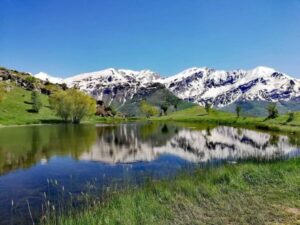
Gomi Felaw is an ancient site located in the Diyala Province of Iraq. The site is known for its impressive ruins, which date back to the ancient Sumerian civilization. Gomi Felaw was once a thriving city that served as a cultural and economic center of the Sumerian civilization.
The ruins of Gomi Felaw consist of a large ziggurat, a temple, and several other smaller buildings. The ziggurat is the most impressive structure on the site and was once the largest ziggurat in the world. The ziggurat was built during the reign of King Ur-Nammu in the 21st century BCE and served as a temple dedicated to the Sumerian god Nanna.
The ziggurat at Gomi Felaw is a remarkable feat of engineering and is a testament to the skills of the ancient Sumerian architects. The ziggurat is made up of layers of mud bricks, each layer smaller than the one below it. The ziggurat originally stood at around 70 meters high, but today only the lower levels remain.
The temple at Gomi Felaw was dedicated to the goddess Inanna and was one of the most important religious centers in the Sumerian civilization. The temple was adorned with precious metals and jewels, and the walls were covered in intricate carvings and artwork. Visitors to the site can still see some of the carvings and artwork on the walls of the temple, which have miraculously survived for over 4,000 years.
Gomi Felaw is a must-visit destination for anyone interested in ancient history and architecture. The site is one of the best-preserved examples of Sumerian architecture and provides a fascinating glimpse into the religious beliefs and cultural practices of one of the world’s earliest civilizations. You can visit the ruins of the ziggurat and temple, marvel at the intricate carvings and artwork, and learn about the history and significance of the site through guided tours and exhibits.
Gomi Felaw is also a beautiful and peaceful place to visit. The site is surrounded by lush greenery and is located near the Diyala River, providing a serene and tranquil setting for visitors to relax and reflect on the wonders of the ancient world.
3. Rabban Hormizd Monastery
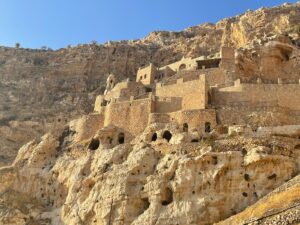
The Rabban Hormizd Monastery is an ancient Syriac Orthodox monastery located in the Alqosh Mountains of northern Iraq. The monastery is one of the oldest Christian monasteries in the world and is renowned for its stunning architecture, historical significance, and beautiful natural surroundings.
The monastery was founded in the 7th century by the monk Rabban Hormizd, who established a small community of monks in the remote mountains of northern Iraq. Over the centuries, the monastery grew in size and importance, becoming a major center of learning and worship in the region. The monastery’s buildings were expanded and rebuilt several times, with each generation of monks adding their own unique architectural and artistic touches to the complex.
Today, the Rabban Hormizd Monastery is one of the most impressive historical sites in Iraq. The monastery’s buildings are constructed of stone and feature beautiful carvings, frescoes, and other artistic embellishments. The monastery’s main church is particularly impressive, with its soaring arches, intricate mosaics, and colorful stained glass windows.
You can visit the various buildings and structures that make up the complex, including the church, the bell tower, the library, and the monastic cells. You can also hike through the surrounding mountains and enjoy the beautiful views of the surrounding landscape.
The Rabban Hormizd Monastery is an important pilgrimage site for Christians in Iraq and around the world. The monastery’s annual Feast of the Cross celebration draws thousands of visitors, who come to participate in the ancient rituals and celebrations that have been observed at the monastery for centuries. The monastery is also home to a small community of monks, who continue to live and work at the site, preserving the rich history and traditions of this remarkable place.
In addition to its historical and religious significance, the Rabban Hormizd Monastery is also a beautiful and tranquil place to visit. The monastery’s remote location and natural surroundings make it a perfect destination for those seeking peace, solitude, and spiritual renewal.
4. Old Najaf
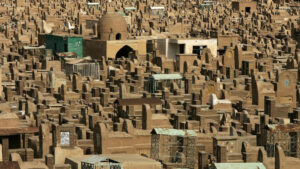
Najaf is an ancient city located in central Iraq, about 160 kilometers south of Baghdad. The city has a rich history that spans more than 1,500 years, and it is one of the holiest sites in Shia Islam. Najaf is the burial place of Ali ibn Abi Talib, the Prophet Muhammad’s cousin and son-in-law, and the fourth caliph of Islam. The city has been an important center of religious and cultural activity for Muslims since the early days of Islam.
Old Najaf is the historic center of the city, and it is home to many of Najaf’s most important religious and cultural sites. The old city is a maze of narrow streets, alleys, and squares, and it is filled with ancient buildings, mosques, and shrines. Many of the buildings in old Najaf date back to the 16th and 17th centuries, and they feature beautiful Islamic architecture, intricate mosaics, and stunning tilework.
One of the most important sites in old Najaf is the Imam Ali Mosque, which is located at the heart of the old city. The mosque is one of the largest in the world, and it is a masterpiece of Islamic architecture. The mosque’s dome is covered in pure gold, and its walls are adorned with beautiful calligraphy and tilework. The mosque is a pilgrimage site for Shia Muslims from around the world, who come to pay their respects to Ali ibn Abi Talib and to pray at the mosque.
Another important site in old Najaf is the Wadi Al-Salaam Cemetery, which is one of the largest and oldest cemeteries in the world. The cemetery is believed to contain the graves of many prophets and holy men, and it is a sacred site for Shia Muslims. Visitors to the cemetery can explore the various tombs, mausoleums, and shrines that make up the vast complex.
The old city of Najaf is also home to many traditional markets, or souks, where visitors can shop for handmade crafts, jewelry, and other goods. The souks are a vibrant and bustling part of the city, and they offer a glimpse into the daily life and culture of Najaf.
5. Shanidar Cave

Shanidar Cave is a famous archaeological site located in the Zagros Mountains in northern Iraq. The cave was first excavated in the 1950s and 60s by a team of archaeologists led by Ralph Solecki. It is most well-known for the discovery of Neanderthal remains and associated artifacts.
In 1957, Solecki discovered the remains of several adult and child Neanderthals in Shanidar Cave’s “flower burial” area. The most famous of these individuals, Shanidar 1, was a middle-aged male who had suffered multiple injuries, including the loss of his right arm, which had been amputated above the elbow. Analysis of his remains suggested that he had survived for some time after this injury, indicating that he may have received care and support from other members of his community.
The discovery of Shanidar 1 and the other Neanderthal remains at the site provided important insights into the behavior and social organization of these early humans. The cave also contained evidence of other human activity, including the remains of animals that had been hunted and butchered by Neanderthals, as well as tools and other artifacts.
Today, Shanidar Cave remains an important site for archaeologists and is open to visitors who can explore its many chambers and learn about the fascinating history of human evolution.
6. The Mesa Of Amedi

Amedi is a small city in northern Iraq that is known for its rich history and stunning natural beauty. The city is located in the mountainous region of Iraqi Kurdistan and is situated on a plateau that overlooks the surrounding landscape. Amedi has been inhabited for thousands of years and has been home to many different civilizations and cultures over the centuries.
One of the most notable features of Amedi is its architecture. The city is known for its traditional mud-brick houses and narrow, winding streets that are reminiscent of a bygone era. Many of these buildings date back hundreds of years and have been well-preserved, giving visitors a glimpse into the city’s rich history.
In addition to its historic architecture, Amedi is also known for its beautiful natural surroundings. The city is surrounded by mountains and is home to several natural springs and waterfalls, making it a popular destination for hikers and outdoor enthusiasts.
One of the most impressive natural features of Amedi is the Mesa of Amedi. This is a large, flat-topped mountain that rises up out of the surrounding landscape and provides breathtaking views of the surrounding countryside. The mesa is believed to have been formed millions of years ago and has been an important landmark in the region for centuries.
In addition to its natural beauty, the Mesa of Amedi is also of great cultural and historical significance. The mountain is home to several ancient caves and rock-cut tombs that date back to the Assyrian period, as well as several churches and shrines that are still in use today. The mesa is also home to the ruins of several ancient fortresses and defensive structures, which are a testament to the city’s long and turbulent history.
7. Mosul Ruins

Mosul is a historic city located in northern Iraq, on the banks of the Tigris River. The city has a rich and diverse history, dating back thousands of years, and has been home to many different civilizations and cultures over the centuries. Unfortunately, Mosul has also been the site of significant destruction in recent years, due to the conflict and instability that has plagued the region.
In 2014, Mosul was taken over by the Islamic State of Iraq and Syria (ISIS), which held the city for several years until it was liberated by Iraqi forces in 2017. The conflict took a heavy toll on the city and its people, with many buildings and landmarks destroyed or damaged in the fighting.
Despite the destruction, Mosul is still a fascinating destination for those interested in history and culture. The city is home to many important historical and religious sites, including the ancient city of Nineveh, which was once the capital of the Assyrian Empire. The ruins of Nineveh are located just outside of Mosul and contain some of the most impressive archaeological remains in the region, including the famous Ishtar Gate.
Visiting the Mosul ruins can be a powerful and moving experience, as they serve as a reminder of the city’s rich history and the human cost of conflict and violence. While some areas of the ruins are off-limits due to safety concerns, there are still many sections that are accessible to visitors, including the remains of ancient palaces, temples, and fortifications.
In addition to the ruins, there are many other attractions to explore in Mosul, including the historic Al-Nouri Mosque, which was destroyed by ISIS but is currently being rebuilt, and the vibrant markets and bazaars that are a hub of local commerce and culture.
Despite the challenges faced by Mosul in recent years, the city and its people are resilient and determined to rebuild and restore what has been lost. A visit to the Mosul ruins can provide a unique and eye-opening perspective on the region’s history and culture, as well as a powerful reminder of the importance of peace and reconciliation.
8. Al-Mutanabbi Street
Al-Mutanabbi Street is a famous and historic street located in the heart of Baghdad, Iraq. The street is named after the renowned Arab poet Abu al-Tayyib al-Mutanabbi, who lived during the 10th century and is considered one of the greatest poets in the Arabic language.
The street has been a cultural and intellectual hub of Baghdad for centuries, lined with bookstores, cafes, and cultural institutions that have been frequented by artists, writers, and scholars. Al-Mutanabbi Street has long been a symbol of Baghdad’s rich cultural heritage and its position as a center of intellectual and artistic excellence in the Arab world.
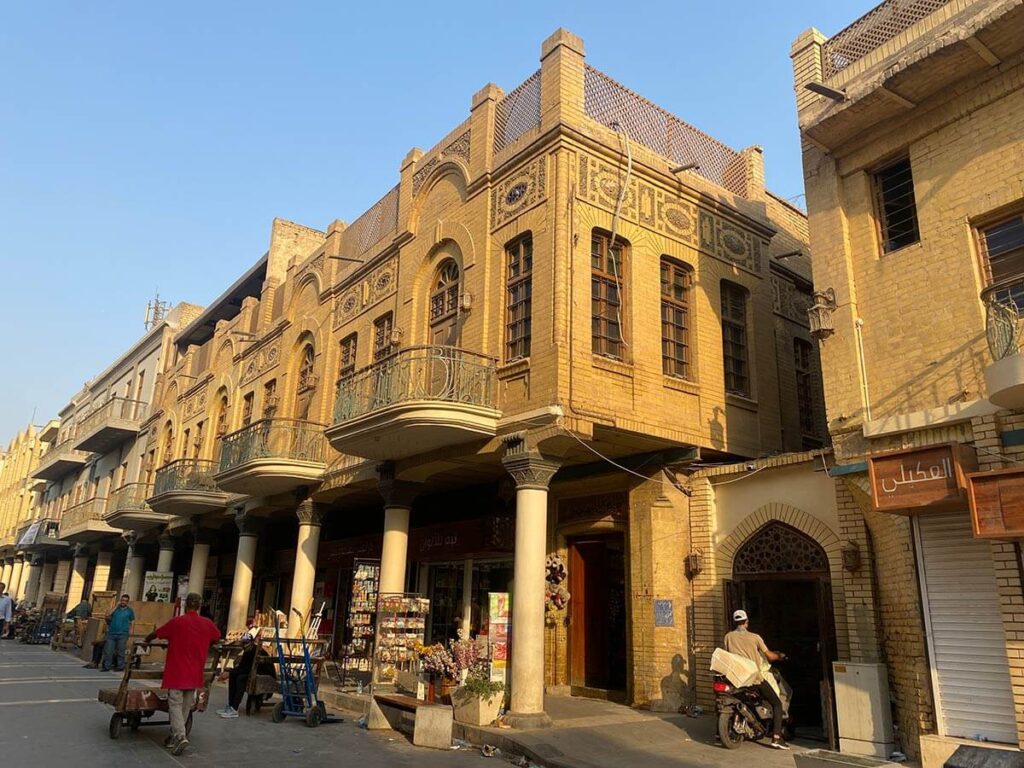
Unfortunately, the street has also been the site of significant violence and destruction in recent years. In 2007, a car bomb exploded on the street, killing dozens of people and destroying many of the bookstores and cultural institutions that had made the street famous. The attack was widely condemned and sparked a global effort to rebuild and restore the street to its former glory.
Today, Al-Mutanabbi Street is once again a vibrant and bustling center of cultural activity in Baghdad, with many of the bookstores and cultural institutions that were destroyed in the attack having been rebuilt and restored. The street remains an important symbol of Baghdad’s cultural heritage and a testament to the resilience and determination of its people.
In the Al-Mutanabbi Street you can explore its many bookstores, cafes, and cultural institutions, and experience the vibrant and dynamic cultural scene that has made the street famous. The street is also home to several monuments and memorials dedicated to the victims of the 2007 attack, serving as a reminder of the important role that culture and the arts play in promoting peace and understanding.
9. Al-Ukhaidir Fortress
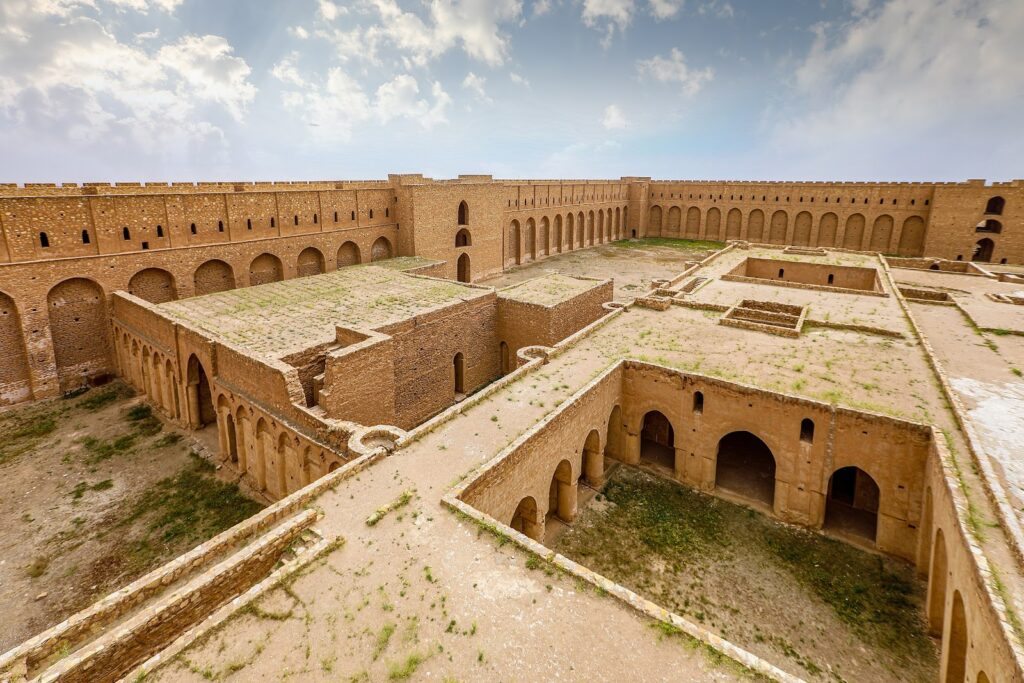
The Al-Ukhaidir Fortress is an ancient structure located in present-day Iraq, about 50 kilometers south-west of Baghdad. It was built in the 8th century during the Abbasid era, and served as a palace complex for Caliph Al-Mu’tasim.
The fortress was constructed using mud bricks, which were then covered with plaster and decorated with geometric patterns and calligraphic inscriptions. The complex is surrounded by a large rectangular wall with towers at each corner and a central gate on the eastern side.
Inside the fortress, there are several buildings, including a palace, a mosque, a bathhouse, and a library. The palace was the main residence of the caliph, and it was decorated with colorful mosaics and frescoes. The mosque is one of the earliest surviving examples of Islamic architecture, and it features a large prayer hall with a mihrab (a niche indicating the direction of Mecca) and a minbar (a pulpit from which the Imam leads the prayer).
The bathhouse, or hammam, was an important part of the palace complex, and it was used for hygiene and relaxation. It consisted of a series of rooms with hot and cold water, as well as massage and steam rooms. The library was also an important part of the palace, and it contained thousands of books and manuscripts on a wide range of topics, including science, medicine, literature, and religion.
Today, the Al-Ukhaidir Fortress is a popular tourist attraction and an important historical site in Iraq. Although it has suffered damage over the years due to neglect and natural disasters, efforts are underway to preserve and restore the complex for future generations to enjoy.
10. The Akre Landscape
Akre is a small town located in the Kurdistan Region of Iraq, nestled in the foothills of the Zagros Mountains. It is a place of great historical and cultural significance, with a rich and diverse heritage that spans thousands of years.
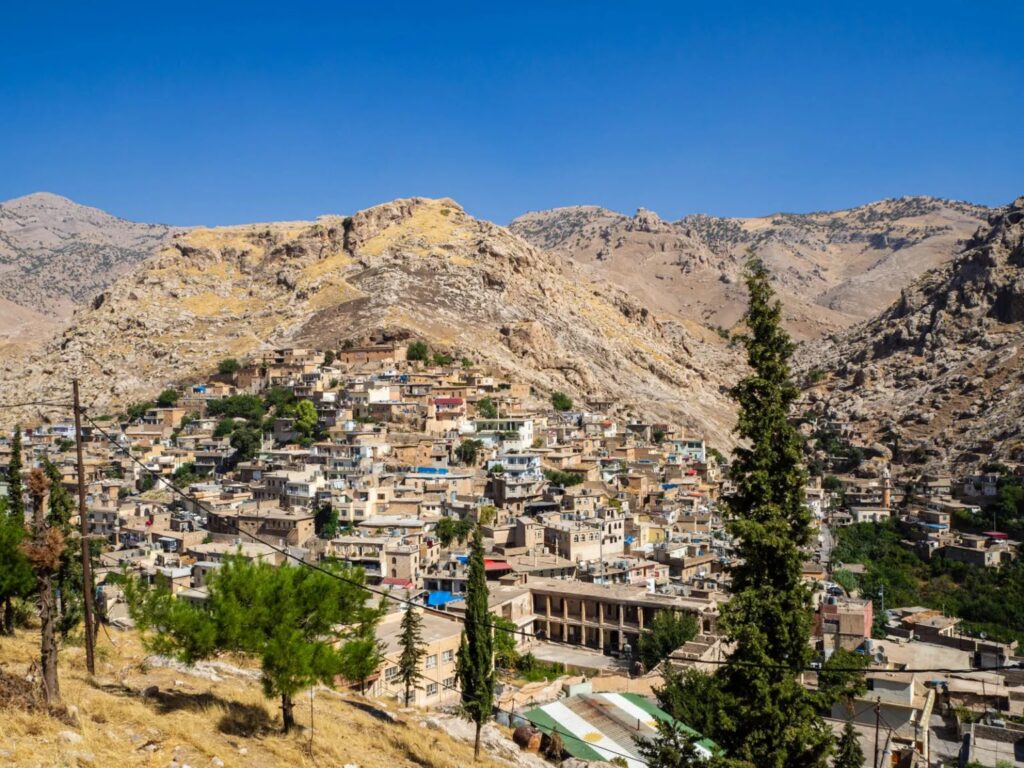
One of the most striking features of Akre is its stunning natural beauty, which is distinguished by the rugged mountains, lush forests, and rolling hills that surround the town. The Akre landscape is a testament to the incredible natural diversity of the region, and it offers visitors a truly unique and unforgettable experience.
One of the most impressive sights in the Akre Region is the stunning Mount Abdulaziz, which towers over the surrounding countryside and offers breathtaking panoramic views of the surrounding area. The Akre Region is also home to a number of natural and man-made landmarks, including the famous Geli Ali Beg Waterfall, which cascades down a series of rocky cliffs and is surrounded by lush vegetation and towering trees. Other landmarks in the area include ancient fortresses, castles, and monuments, which are testament to the rich history of the region and the many civilizations that have called it home over the centuries.
Akre is a truly unique and breathtakingly beautiful destination that offers visitors a chance to explore the natural wonders and rich cultural heritage of this incredible region. Whether you’re a nature lover, history lover, or simply looking for an unforgettable adventure, Akre and its stunning landscape are sure to leave a lasting impression.
11. Iraqi Marshes
The Iraqi Marshes, also known as the Mesopotamian Marshes, are a wetland area located in southern Iraq, near the Persian Gulf. They are considered to be one of the largest and most biodiverse wetlands in the world, covering an area of over 20,000 square kilometers.
The Iraqi Marshes have a long and rich history, and they have been inhabited by various civilizations for thousands of years. The Marsh Arabs, also known as the Ma’dan, are a group of people who have lived in the marshes for centuries, and they have developed a unique culture and way of life that is closely tied to the wetland ecosystem.
During the 20th century, the Iraqi Marshes suffered extensive damage due to a variety of factors, including dam construction, oil exploration, and military operations. By the 1990s, much of the wetland had been drained, and the Marsh Arabs had been forced to leave their homes and traditional way of life.

In recent years, however, efforts have been made to restore the Iraqi Marshes and to revive the traditional lifestyle of the Marsh Arabs. A massive restoration project, led by the Iraqi government and supported by international organizations, has involved rebuilding levees and dams, restoring water flow to the marshes, and reintroducing native plant and animal species.
Today, the Iraqi Marshes are thriving once again, and they are home to a rich and diverse array of plant and animal life, including numerous endangered species. They also provide important ecosystem services, such as water filtration, flood control, and carbon sequestration.
In addition to their ecological significance, the Iraqi Marshes are also a major cultural and historical landmark, and they attract visitors from all over the world who come to experience their unique beauty and learn about the fascinating history and culture of the Marsh Arabs.
12. The City Of Lalish

Lalish is a small town located in northern Iraq, in the province of Nineveh. It is considered to be one of the holiest sites for the Yazidi people, who are an ethno-religious group that has been persecuted throughout history.
The Yazidi religion is an ancient faith that predates Islam and Christianity, and it is unique in its beliefs and practices. Yazidis believe in one god, who has seven angels that govern the universe. They also believe in reincarnation and the importance of purity and cleanliness.
Lalish is the holiest site for the Yazidi people, and it is home to the tomb of Sheikh Adi ibn Musafir, who is considered to be the founder of the Yazidi religion. The town is also home to the Lalish Temple, which is the main religious center for the Yazidi people and is considered to be one of the most sacred sites in the world.
The Lalish Temple is a complex of buildings that includes a central shrine, several smaller shrines, and a number of administrative and residential buildings. The central shrine is a domed structure that houses the tomb of Sheikh Adi ibn Musafir, and it is considered to be the most sacred site in the temple.
Visitors to Lalish are required to remove their shoes and cover their heads before entering the temple, as a sign of respect for the Yazidi faith. They are also not allowed to take photographs inside the temple.
Lalish is an important cultural and religious landmark in Iraq, and it attracts visitors from all over the world who come to learn about the unique beliefs and practices of the Yazidi people. Despite being a small and remote town, Lalish is a symbol of hope and resilience for the Yazidi community, who have faced centuries of persecution and discrimination but continue to maintain their faith and traditions.
13. The Shrine of Imam Hussein
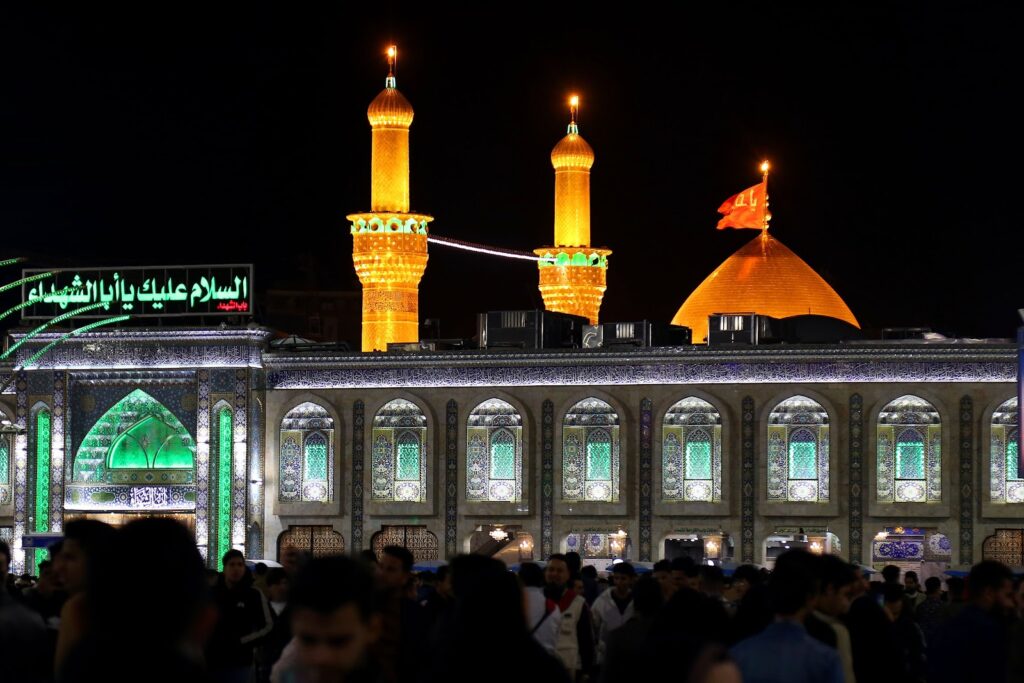
Karbala is a city located in central Iraq, about 100 kilometers southwest of Baghdad. It is an important religious site for Shia Muslims, and it is known for the tragic events that took place there in 680 AD, during the Battle of Karbala.
The Battle of Karbala was a defining moment in Shia Muslim history, and it is commemorated every year during the Islamic month of Muharram. The battle was fought between the forces of Yazid I, the Umayyad caliph, and a small group of supporters of Imam Hussein, the grandson of Prophet Muhammad.
Imam Hussein and his followers were vastly outnumbered and outmatched, but they chose to stand and fight for their beliefs. The battle ended in a massacre, with Imam Hussein and his companions being killed and their bodies mutilated. This event is considered to be a symbol of resistance against tyranny and injustice, and it has inspired generations of Shia Muslims to stand up for their rights and beliefs.
The city of Karbala is home to the Shrine of Imam Hussein, which is one of the most important religious sites for Shia Muslims. The shrine is located on the site where Imam Hussein and his companions were killed, and it is visited by millions of pilgrims every year.
The shrine complex is an impressive structure that includes several buildings and courtyards, as well as the tomb of Imam Hussein and several other Shia Muslim figures. The main building of the shrine is the golden-domed mausoleum of Imam Hussein, which is surrounded by a large courtyard and several smaller buildings.
Visitors to the shrine are required to follow strict rules of dress and behavior, and they are not allowed to take photographs inside the shrine. The atmosphere inside the shrine is one of reverence and devotion, with pilgrims praying, reciting Quranic verses, and performing various religious rituals.
The Shrine of Imam Hussein is not only an important religious site but also a symbol of the resilience and endurance of the Shia Muslim community. Despite centuries of persecution and oppression, the Shia Muslims have maintained their faith and traditions, and the shrine of Imam Hussein in Karbala is a testament to their devotion and commitment to their beliefs.
14. Babylon
Babylon is an ancient city located in modern-day Iraq, about 80 kilometers south of Baghdad. It is one of the most important and well-known cities in human history, with a rich and storied past that dates back more than 4,000 years.
The city of Babylon was founded in the 3rd millennium BC, and it rose to prominence under the rule of King Hammurabi in the 18th century BC. The city became one of the greatest centers of culture, learning, and trade in the ancient world, and it was home to the famous Hanging Gardens, one of the Seven Wonders of the Ancient World.
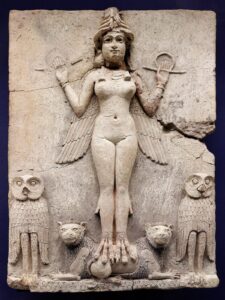
A visit to Babylon offers a glimpse into the past and a chance to witness the architectural wonders and cultural achievements of one of the world’s greatest civilizations.
One of the most impressive structures in Babylon is the Ishtar Gate, which was built by King Nebuchadnezzar II in the 6th century BC. The gate is made of blue glazed bricks with intricate reliefs of lions, dragons, and bulls, and it served as the main entrance to the city.
Another must-see attraction in Babylon is the ruins of the ancient city, which include the remains of the Hanging Gardens, the Palace of Nebuchadnezzar II, and the Temple of Marduk, one of the most important gods in the Babylonian pantheon. Visitors can wander through the ruins and imagine what life was like in the ancient city, with its bustling markets, towering ziggurats, and majestic palaces.
In addition to exploring the ruins, visitors to Babylon can also learn about the city’s rich cultural heritage at the Babylon Archaeological Museum, which houses a vast collection of artifacts from the ancient city. The museum features exhibits on Babylonian art, architecture, religion, and daily life, and it provides a fascinating insight into the world of the ancient Babylonians.
A visit to Babylon is a unique and unforgettable experience, offering a glimpse into the rich history and culture of one of the world’s greatest civilizations. Babylon is a destination that should not be missed.
15. The Great Ziggurat of Ur
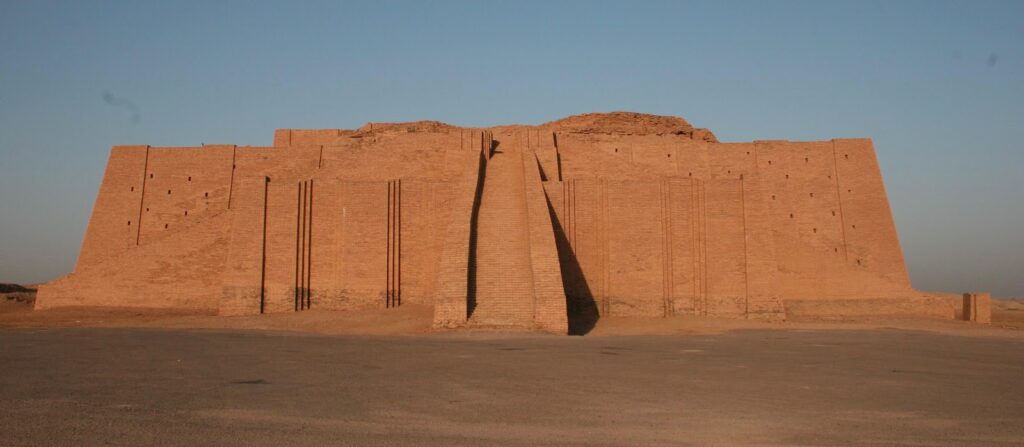
The Great Ziggurat of Ur is an ancient structure located in the southern Iraqi city of Nasiriyah, near the ruins of the ancient city of Ur. It was built over 4,000 years ago by the Sumerians, one of the earliest civilizations in human history.
A ziggurat is a type of stepped pyramid, with a flat top where a temple or shrine was usually located. The Great Ziggurat of Ur was originally built as a religious temple dedicated to the moon god Nanna, who was worshiped by the Sumerians as a powerful and benevolent deity.
The ziggurat was constructed using sun-dried bricks and bitumen, a tar-like substance used as a binding agent. The structure was originally about 21 meters high, with a base measuring 64 meters by 46 meters. It was later restored and expanded by the Babylonian king Nebuchadnezzar II in the 6th century BC.
The Great Ziggurat of Ur was one of the most important religious and cultural centers in the ancient world, attracting pilgrims from all over Mesopotamia and beyond. The ziggurat was a symbol of the power and influence of the Sumerian civilization, and it played a key role in the development of the region’s art, architecture, and religion.
Today, the Great Ziggurat of Ure has been partially restored, with some of the original bricks and bitumen used in the construction of the ziggurat being replaced.
You can climb to the top of the ziggurat and explore the ruins of the ancient temple, which offer a fascinating glimpse into the religious and cultural practices of the Sumerian civilization. The surrounding area is also home to a number of other ancient ruins and historical sites, including the Royal Cemetery of Ur, which contains the tomb of Queen Puabi, one of the most important figures in Sumerian history.
The Great Ziggurat of Ur is not only a remarkable feat of ancient engineering but also a testament to the enduring legacy of the Sumerian civilization. It is a reminder of the remarkable achievements of one of the earliest and most influential cultures in human history, and a source of inspiration for generations to come.
16. The spiraling minaret of Samarra
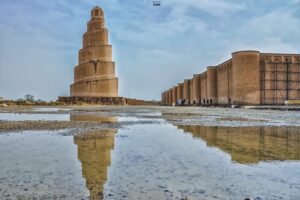
The spiraling minaret of Samarra, also known as the Malwiya Minaret, is an ancient architectural marvel located in the city of Samarra in Iraq. Built in the 9th century AD, the minaret stands at an impressive height of 52 meters, with a spiral ramp that winds around the exterior of the tower, leading to the top.
The minaret was constructed during the reign of the Abbasid caliph Al-Mutawakkil, and it served as a symbol of the power and influence of the Abbasid dynasty. The tower was originally part of the Great Mosque of Samarra, which was one of the largest and most important mosques in the Islamic world at the time.
The Malwiya Minaret is known for its unique spiral design, which was intended to help worshipers climb to the top of the tower to perform the call to prayer. The spiral ramp is wide enough to accommodate several people at once, and it winds around the exterior of the tower in a counterclockwise direction.
The minaret is made of bricks and is adorned with intricate carvings and decorative features, including ornate friezes and panels depicting scenes from Islamic history and mythology. The tower is a remarkable example of the architectural achievements of the Abbasid dynasty, and it is considered one of the most impressive and distinctive Islamic structures in the world.
The Malwiya Minaret is a good destination for those who are interested in Islamic history and architecture. The tower has been partially restored and preserved, and visitors can climb to the top of the spiral ramp to enjoy panoramic views of the surrounding city.
The Malwiya Minaret is not only a stunning example of Islamic architecture but also a testament to the rich cultural heritage of Iraq and the Middle East. It is a symbol of the enduring legacy of the Abbasid dynasty and a source of inspiration for generations to come.
Ten Reasons Why You Should Travel To Iraq
Iraq is a country rich in history, culture, and natural beauty, making it an enticing destination for travelers seeking unique and authentic experiences. Situated in the heart of the Middle East, Iraq is a land of contrasts, where ancient traditions and modernity coexist harmoniously. Despite its turbulent past, most Iraq is now a safe and welcoming country that is open to visitors from all around the world. From the breathtaking landscapes of the Kurdish mountains to the mesmerizing ruins of Babylon, Iraq offers a range of attractions that are sure to captivate even the most discerning traveler. With its warm hospitality, delicious cuisine, and diverse cultural offerings, Iraq promises an unforgettable journey for those who are willing to venture off the beaten path. So why not pack your bags and embark on an adventure to this fascinating country? You won’t be disappointed.
1. Ancient history
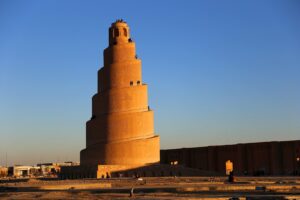
Iraq is home to some of the world’s oldest and most important archaeological sites, including Babylon, Ur, and Nineveh. These ancient ruins are testaments to the rich cultural heritage of Iraq and the birthplace of some of the earliest civilizations in human history. Exploring these sites can be an awe-inspiring experience, as you walk in the footsteps of ancient kings and queens and marvel at the engineering feats of the past.
2. Cultural diversity
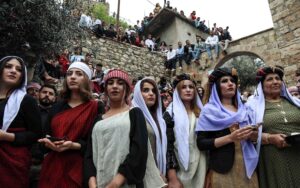
Iraq is a melting pot of different ethnic groups, each with its own unique traditions and customs. This diversity is reflected in the country’s cuisine, music, and architecture, making it a fascinating destination for cultural exploration. Whether you’re visiting the Kurdish north or the Arab south, you’ll find that each region has its own distinct identity and charm.
3. Warm hospitality
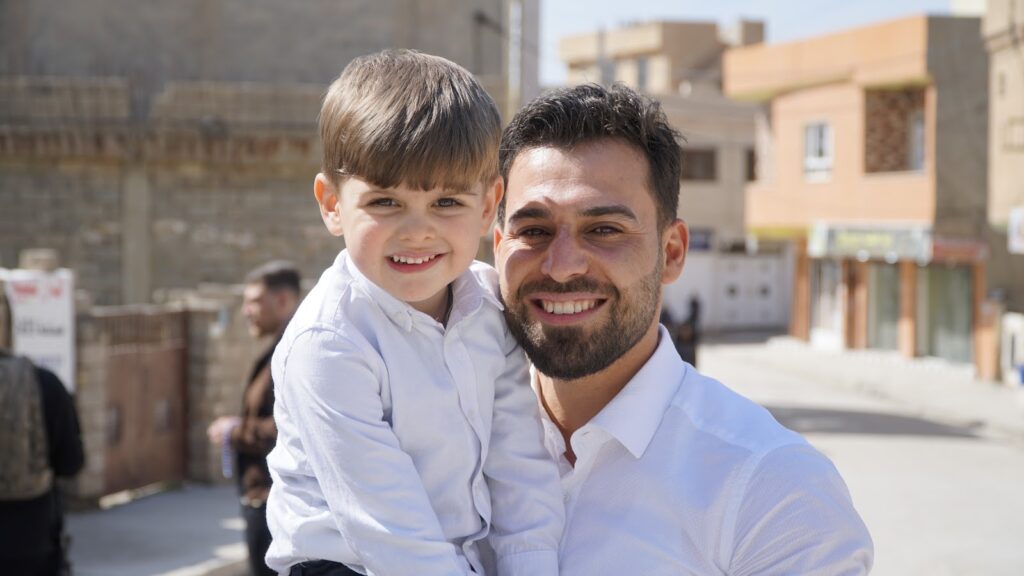
Iraqis are known for their warm and welcoming hospitality, and you are sure to feel at home while traveling in the country. From sharing meals with locals to learning about their customs and traditions, you can expect to make lifelong friends while in Iraq. The locals are happy to show visitors their country and take pride in their culture and traditions.
4. Natural beauty
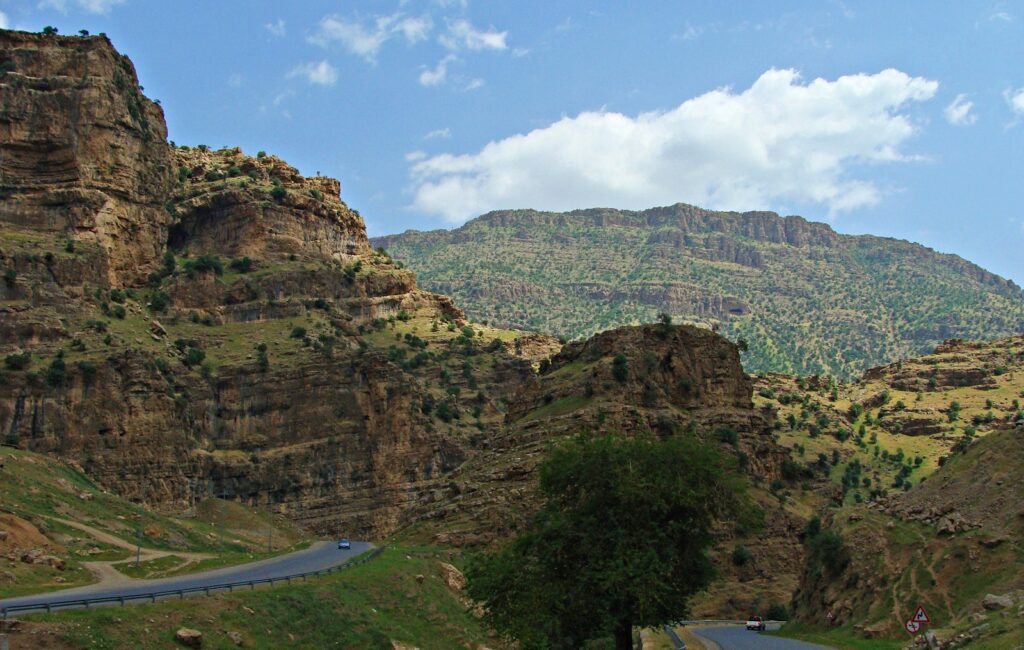
Iraq is home to stunning natural landscapes, from the marshes of the south to the mountains of the north. The Mesopotamian Marshes, which were once home to the ancient Sumerian civilization, are a unique and beautiful wetland ecosystem that provides a habitat for numerous bird species. The Zagros Mountains, which run through the northern part of the country, are a hiker’s paradise, with breathtaking views and challenging trails. The beauty of Iraq’s natural environment is a hidden gem waiting to be explored.
5. Delicious cuisine

Iraqi cuisine is a blend of Middle Eastern and Mediterranean flavors, with dishes like kebabs, dolma, and kubba. Iraqi food is known for being hearty and flavorful, with plenty of spices and herbs. Exploring the local cuisine can be a highlight of your trip, and you might even be inspired to bring some recipes home with you.
6. Shopping
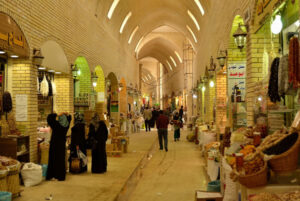
Iraq is known for its bustling markets, where you can find everything from spices and textiles to gold and jewelry. Shopping in these markets can be a fun and rewarding experience, and you might even find some unique souvenirs to bring home with you. The markets are colorful, vibrant, and full of life, and the prices are often negotiable.
7. Religious significance

Iraq is home to some of the holiest sites in the world for Shia Muslims, including the Imam Hussein Shrine in Karbala and the Imam Ali Mosque in Najaf. Visiting these sacred sites can be a deeply spiritual experience, even for non-Muslims. The shrines are beautiful and ornate, and the history and significance behind them are awe-inspiring.
8. Adventure

From hiking in the mountains to exploring the desert, there are plenty of opportunities for adventure in Iraq. You can go on a camel ride, visit a natural hot spring, or even try your hand at sandboarding. The Tigris and Euphrates rivers offer water sports, and the mountainous areas are perfect for trekking and camping.
9. Affordable travel
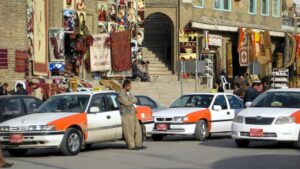
Compared to other destinations in the region, travel in Iraq can be surprisingly affordable. Accommodations, food, and transportation are generally very reasonably priced, making it an accessible destination for budget-conscious travelers. The local currency, Iraqi dinar, has a favorable exchange rate for international visitors, making your travel budget stretch further.
10. Unique experiences
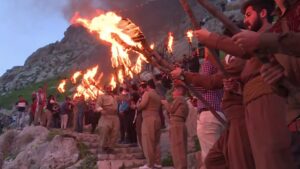
Traveling to Iraq is not just about ticking off tourist attractions; it’s about experiencing a unique culture and way of life. Whether it’s attending a local festival or spending
Ten Most Beautiful Destinations In Kurdistan
Kurdistan is a semi-autonomous region in the northern part of Iraq, with a population of approximately six million people. It is a land of incredible natural beauty, rich cultural heritage, and a complex history that dates back thousands of years. Kurdistan is home to a diverse mix of ethnic and religious communities, including Kurds, Arabs, Assyrians, Turkmen, and Yazidis, among others, who coexist in a spirit of mutual respect and cooperation.
The history of Kurdistan is a complex one, shaped by centuries of conquest, conflict, and colonization. The region was first mentioned in historical records dating back to the third millennium BCE, when it was inhabited by the ancient Gutians, who were later conquered by the Akkadian Empire. Over the centuries, the region was ruled by various empires and dynasties, including the Persians, Greeks, Arabs, and Ottomans, among others.
Despite its tumultuous history, Kurdistan has always been known for its rich cultural heritage and its vibrant arts and literature. The region is home to a diverse range of cultural and linguistic traditions, including Kurdish, Arabic, Syriac, Turkmen, and Armenian, among others. Its literature, music, and poetry have had a profound impact on the wider Middle Eastern cultural scene, influencing generations of artists and thinkers across the region.
In recent years, Kurdistan has emerged as a popular tourist destination, thanks to its stunning natural landscapes, rich cultural heritage, and warm hospitality. The region is home to a range of attractions, including ancient historical sites, bustling bazaars, and stunning natural parks and reserves.
One of the most popular destinations in Kurdistan is Erbil, the region’s capital city and one of the oldest continuously inhabited cities in the world. Erbil is home to a range of historical sites, including the ancient Citadel of Erbil, which dates back to the 6th millennium BCE and has been recognized as a UNESCO World Heritage Site. The city is also known for its bustling markets, colorful bazaars, and vibrant nightlife, making it a popular destination for tourists from around the world.
Another popular destination in Kurdistan is Sulaymaniyah, a vibrant and cosmopolitan city located in the eastern part of the region. Sulaymaniyah is known for its stunning natural landscapes, including the nearby Zagros Mountains, which offer breathtaking views of the surrounding countryside. The city is also home to a range of cultural and historical attractions, including the Sulaymaniyah Museum, which showcases the region’s rich history and cultural heritage.
Beyond its cities, Kurdistan is home to a range of stunning natural parks and reserves, which offer visitors the chance to explore the region’s incredible natural beauty up close. One of the most popular parks in the region is the Dukan Lake, a scenic and tranquil lake located in the heart of the Zagros Mountains. Visitors can hike through the surrounding hills and forests, take a boat tour of the lake, or simply relax and soak up the natural beauty of the area.
Kurdistan is a land of incredible beauty, rich cultural heritage, and a complex history that spans thousands of years. Its cities, historical sites, and natural reserves offer visitors a unique and rewarding travel experience, with the opportunity to explore the region’s rich cultural traditions and experience the warmth and hospitality of its people. Whether you are interested in history, culture, or natural beauty, Kurdistan is a destination that is sure to captivate and inspire.
Here are ten of the most beautiful destinations to visit in Kurdistan, Iraq:
Summary
1. Erbil Citadel – a UNESCO World Heritage site and one of the oldest continuously inhabited cities in the world, the Erbil Citadel is a must-visit destination in Iraqi Kurdistan.
2. Rawanduz Canyon – a breathtaking natural wonder with towering cliffs, cascading waterfalls, and crystal clear streams, Rawanduz Canyon is a popular destination for outdoor enthusiasts.
3. Amna Suraka Museum – a former prison and torture center used by Saddam Hussein’s regime, the Amna Suraka Museum is a haunting reminder of Iraq’s recent history.
4. Lalish – a sacred site for the Yazidi religion, Lalish is a tranquil and spiritual destination with beautiful gardens, temples, and shrines.
5. Dukan Lake – a serene and picturesque lake surrounded by verdant hills and mountains, Dukan Lake is a popular destination for swimming, boating, and relaxation.
6. Shanidar Cave – an archaeologically important site with evidence of Neanderthal and early human habitation, Shanidar Cave offers a fascinating glimpse into the prehistory of Iraq.
7. Gali Ali Beg Waterfall – a stunning waterfall with a 40-meter drop, Gali Ali Beg is a popular destination for hiking and picnicking.
8. Halabja Memorial Monument – a somber and moving tribute to the victims of the 1988 Halabja chemical attack, the Halabja Memorial Monument is a powerful reminder of the human cost of war and conflict.
9. Ahmed Awa – a beautiful mountainous region with scenic valleys, picturesque waterfalls, and colorful flora and fauna, Ahmed Awa is a paradise for nature lovers.
10. Slemani City – a vibrant and cosmopolitan city with a rich cultural heritage, Slemani is a hub of arts, music, and cuisine, and offers a wealth of shopping, dining, and entertainment options.
1. Erbil Citadel

Erbil is the capital of the Kurdistan Region in northern Iraq. It is one of the oldest continuously inhabited cities in the world, with a history that spans over 8,000 years. The city has been a center of trade and commerce since ancient times, thanks to its strategic location at the crossroads of several important trade routes.
Erbil is home to a number of historical and cultural sites, including the Erbil Citadel, which is located in the heart of the city. The Citadel is a UNESCO World Heritage Site and is considered to be one of the most important historical landmarks in the region. The Citadel has been continuously inhabited for thousands of years and is a testament to the city’s rich cultural heritage and its position as a center of trade and commerce.
The Erbil Citadel is located on a hill in the center of the city and is surrounded by a defensive wall that dates back to the Ottoman period. The Citadel has been inhabited by several different civilizations throughout its history, including the Sumerians, Akkadians, Assyrians, Babylonians, Persians, and Ottomans, among others. Today, it is home to a number of residential and commercial buildings, as well as a range of cultural and historical attractions.
One of the most impressive features of the Citadel is its stunning architecture, which reflects the influence of the various civilizations that have inhabited the area over the centuries. The Citadel is home to a number of mosques, churches, and other religious sites, as well as a range of residential and commercial buildings. Here you can explore the narrow alleyways and winding streets of the Citadel, which are lined with shops, cafes, and other businesses.
In addition to its historical and cultural significance, the Erbil Citadel is also renowned for its beauty. The Citadel is surrounded by a lush green park, which is a popular spot for picnics and leisurely strolls. The park is home to a number of trees, including palm trees, which provide shade and a sense of tranquility in the midst of the bustling city.
Erbil and its Citadel are must-see destinations for anyone interested in history, culture, and architecture. The Citadel is a testament to the rich cultural heritage of the region and the city of Erbil, and is a symbol of the city’s enduring spirit and resilience. Visitors to Erbil can explore the Citadel and its surrounding areas, soak up the history and culture of the region, and enjoy the beauty and tranquility of this incredible destination.
2. Rawanduz Canyon

Rawanduz Canyon is a natural wonder located in the Kurdistan Region of Iraq. The canyon is situated in the northeast of Erbil city, near the town of Rawanduz, and it is carved by the fast-flowing Sirwan River.
The canyon is a popular tourist destination due to its breathtaking scenery, including steep cliffs and colorful rock formations. Visitors can explore the canyon by foot or take a boat ride on the river to experience the stunning views from a different perspective.
Rawanduz Canyon is also known for its historical significance, as it was a strategic location during various periods of Iraqi history. The area has been inhabited since ancient times, and there are several archaeological sites in the vicinity that date back to the Neolithic and Bronze ages.
Rawanduz Canyon is a unique and stunning natural wonder that offers visitors a mix of outdoor adventure, historical exploration, and breathtaking scenery.
3. The Amna Suraka Museum
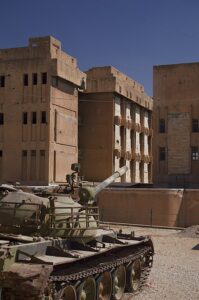
The Amna Suraka Museum, also known as the Red Security Museum, is a museum located in the city of Sulaymaniyah in the Kurdistan Region of Iraq. The museum is housed in a former headquarters of the Iraqi Intelligence Service, which was notorious for its brutal treatment of Kurdish people during Saddam Hussein’s regime.
The museum is dedicated to preserving the memory of the atrocities committed against the Kurdish people during the Baathist regime and educating visitors about the struggle for Kurdish independence. The exhibits include photographs, documents, and artifacts that document the history of the Kurdish people and their struggle for freedom.
One of the highlights of the museum is a former torture chamber, which has been preserved to give visitors an idea of the horrors that took place in the building. The walls of the chamber are covered in graffiti left by former prisoners, and there are various instruments of torture on display.
While the museum can be a harrowing experience, it is an important reminder of the human cost of oppression and the resilience of those who fight for freedom. The Amna Suraka Museum is a must-visit destination for anyone interested in the history and culture of the Kurdish people.
4. Lalish
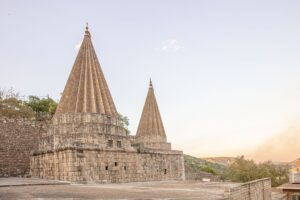
Lalish is a sacred site for the Yazidi religion, located in the northern part of Iraq, near the town of Shekhan in the Nineveh Governorate. The Yazidi people are an ethno-religious minority who follow a syncretic faith that combines elements of Zoroastrianism, Islam, Christianity, and ancient Mesopotamian religions.
Lalish is considered the holiest site in the Yazidi religion, and it is home to the tomb of Sheikh Adi ibn Musafir, who is revered as the founder of the faith. The complex includes several shrines, temples, and living quarters for the priests and caretakers of the site.
Visitors to Lalish are required to remove their shoes and cover their heads before entering the holy site. Non-Yazidis are not allowed to enter the inner sanctum of the temple, but they can explore the outer courtyards and observe the religious practices of the Yazidi people.
Lalish is an important pilgrimage site for the Yazidi people, and it attracts thousands of visitors every year, especially during the annual festival of Pir Shalyar, which is celebrated in early September. The festival includes music, dancing, and other cultural activities, and it is an opportunity for Yazidis from all over the world to come together and celebrate their faith.
5. Dukan Lake

Dukan Lake is a large freshwater lake located in the Sulaymaniyah Governorate of the Kurdistan Region of Iraq. The lake was created in the 1950s as part of a hydroelectric dam project, and it has since become a popular tourist destination for its stunning natural beauty and recreational activities.
The lake is surrounded by rugged mountains and scenic valleys, and it offers a range of activities such as swimming, fishing, boating, and camping. Visitors can rent boats or kayaks to explore the lake, or they can go hiking in the nearby mountains and enjoy the stunning views.
Dukan Lake is also home to several resorts and restaurants that offer a range of amenities, including swimming pools, water sports equipment, and traditional Kurdish cuisine. Visitors can enjoy a relaxing day at the lake, take a boat tour of the area, or simply soak up the scenery from the comfort of a lakeside cafe.
Dukan Lake is a beautiful and tranquil destination that offers visitors a unique opportunity to experience the natural beauty and cultural heritage of the Kurdistan Region of Iraq. Whether you’re looking for adventure or relaxation, Dukan Lake has something to offer everyone.
6. Shanidar Cave

Shanidar Cave is an archaeological site located in the Zagros Mountains in northern Iraq, near the town of Shanidar. The cave is famous for the discovery of a group of Neanderthal skeletons in the 1950s, which provided significant insights into the behavior and culture of early humans.
The excavation of the cave revealed a total of nine Neanderthal skeletons, dating back to the Middle Paleolithic period, approximately 60,000-80,000 years ago. The skeletons showed evidence of significant injuries, including a man with a partially amputated arm and a woman with a crushed skull, which suggests that Neanderthals may have cared for their injured and disabled members.
In addition to the Neanderthal remains, the cave also contained a range of artifacts, including stone tools, animal bones, and evidence of fire use. These findings provided important clues about the daily lives and culture of early humans.
Today, visitors can explore the cave and learn about the history of human evolution through the exhibits and interpretive materials. The site also offers stunning views of the surrounding mountains and valleys, making it a unique and memorable destination for history enthusiasts and nature lovers alike.
7. Gali Ali Beg Waterfall
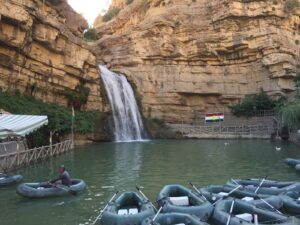
Gali Ali Beg Waterfall is a picturesque waterfall located in the Sulaymaniyah Governorate of the Kurdistan Region of Iraq. The waterfall is situated in the stunning Gali Ali Beg canyon, which is surrounded by high cliffs and lush greenery.
The waterfall is approximately 40 meters high, and its cascading waters create a misty and serene atmosphere that is perfect for a relaxing day out. While visiting you can enjoy a swim in the cool waters of the natural pool at the base of the waterfall, or take a scenic hike through the canyon and enjoy the stunning views.
The surrounding area is home to several small cafes and picnic spots, where visitors can enjoy traditional Kurdish cuisine and relax in the shade of the trees. The site is especially popular during the summer months, when the waterfall and the surrounding area are at their most beautiful.
Gali Ali Beg Waterfall is a unique and beautiful destination that offers visitors a chance to relax and enjoy the natural beauty of the Kurdistan Region of Iraq. It’s a perfect spot for a day trip or a weekend getaway, and it’s a must-visit destination for anyone who loves nature and the outdoors.
8. Halabja Memorial Monument
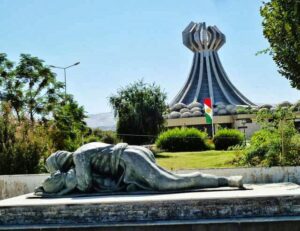
The Halabja Memorial Monument is located in the city of Halabja in the Kurdistan Region of Iraq. It serves as a memorial to the victims of the Halabja chemical attack, which was carried out by the regime of Saddam Hussein on March 16, 1988. The attack resulted in the deaths of an estimated 5,000 civilians, many of whom were women and children.
The monument features a large statue of a Kurdish woman holding a dead child, symbolizing the tragic loss of innocent lives in the attack. The base of the monument is inscribed with the names of the victims, and it serves as a powerful reminder of the atrocities committed against the Kurdish people during the Saddam Hussein regime.
The memorial also includes a museum that tells the story of the attack and its aftermath. The museum displays photographs, personal items, and other artifacts that document the experiences of the survivors and their families. It also features audio and video recordings of survivor testimonies, providing a powerful and emotional glimpse into the human impact of the attack.
Visitors to the Halabja Memorial Monument can pay their respects to the victims of the chemical attack and learn about the history and culture of the Kurdish people. The monument serves as a powerful reminder of the atrocities committed against the Kurdish people and the importance of remembrance and healing in the face of tragedy.
9. Ahmed Awa
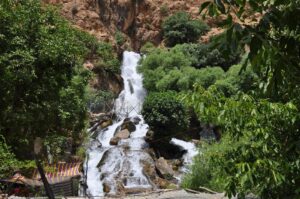
Ahmed Awa is a small village located in the Zagros Mountains of the Kurdistan Region of Iraq. The village is known for its stunning natural beauty and its unique culture and traditions, making it a popular destination.
One of the main attractions of Ahmed Awa is its beautiful waterfall, which is located just a short hike from the village. The waterfall is approximately 25 meters high, and its cascading waters create a cool and refreshing atmosphere that is perfect for a day out in nature. Visitors can swim in the natural pool at the base of the waterfall, or they can enjoy a picnic in the nearby park.
The village of Ahmed Awa is also home to several traditional Kurdish houses, which are made of mud and straw and have been preserved as cultural landmarks. Visitors can explore these houses and learn about the history and culture of the Kurdish people.
In addition to its natural and cultural attractions, Ahmed Awa is also known for its delicious food and hospitality. Try traditional Kurdish dishes such as kebabs, pacha, and dolma, as well as local specialties like honey and Kurdish tea.
Ahmed Awa is a unique and beautiful destination that offers visitors a chance to experience the natural beauty and cultural heritage of the Kurdistan Region of Iraq. It’s a perfect spot for a day trip or a weekend getaway, and it’s a must-visit destination for anyone who loves nature, culture, and delicious food.
10. Slemani City
Slemani City, also known as Sulaymaniyah, is the capital of the Sulaymaniyah Governorate in the Kurdistan Region of Iraq. It is the second-largest city in the Kurdistan Region, after Erbil, and it is known for its rich history, vibrant culture, and stunning natural beauty.

One of the main attractions of Slemani City is its lively bazaars, where visitors can explore the local markets and shop for traditional Kurdish goods such as textiles, spices, and handicrafts. The city is also home to several museums, including the Slemani Museum, which houses a collection of artifacts and exhibits that tell the story of the city’s history and culture.
Slemani City is also known for its beautiful parks and gardens, which provide a welcome respite from the hustle and bustle of the city. The Azadi Park, for example, is a popular destination for families and visitors, with its landscaped gardens, playgrounds, and picnic areas.
The city is also surrounded by stunning natural beauty, including the nearby Goyija and Azmar Mountains, which offer breathtaking views and hiking opportunities. The area is also home to several waterfalls, including the Gali Ali Beg Waterfall and the Bekhal Waterfall, which are popular destinations for nature lovers and adventure seekers.
Baghdad: A City Full Of Wonders
The city of Baghdad has a long and fascinating history that spans over 1,200 years. Located in the heart of the Middle East, it has been a hub of culture, trade, and political power throughout its existence. Today, it is a thriving modern metropolis that offers visitors a unique blend of history, culture, and modernity.
The city of Baghdad was founded in 762 AD by the Abbasid Caliph al-Mansur. It was designed to be the new capital of the Islamic empire, and it quickly became one of the most important cities in the world. Baghdad was known for its wealth, culture, and learning, and it was home to many famous scholars, poets, and philosophers.

During the Islamic Golden Age, Baghdad was a center of knowledge and learning, with famous institutions such as the House of Wisdom, where scholars from different parts of the world gathered to study and share knowledge. The city was also home to many beautiful mosques, palaces, and gardens, which were built by the caliphs to showcase their wealth and power.
In the centuries that followed, Baghdad remained an important center of culture and trade, but it also faced many challenges. The city was invaded and occupied by various empires, including the Mongols, Persians, and Ottoman Turks. It was also affected by natural disasters, such as floods and earthquakes, which caused significant damage to the city’s infrastructure.
Today, Baghdad is a busy and modern city that is home to over 8 million people. It is the capital of Iraq and the largest city in the country. Despite the challenges it has faced, Baghdad has managed to rebuild and modernize, while still preserving its rich cultural heritage. Baghdad has a thriving economy, with many industries such as oil, gas, and construction contributing to its growth. The city is also home to many universities, research centers, and cultural institutions, which provide a rich and diverse intellectual environment.
While Baghdad may not be the first destination that comes to mind when thinking of tourism, the city has a lot to offer visitors. From ancient historical sites to modern cultural experiences, there is something for everyone in Baghdad.
One of the must-visit destinations in Baghdad is the Al-Mustansiriya School, one of the oldest universities in the world. Founded in 1227, the school is a testament to the city’s long history of learning and scholarship. Another must-visit site is the famous Al-Mutanabbi Street, a bustling market that has been a center of commerce and culture for centuries. Visitors can explore the many bookstores, cafes, and shops, and get a taste of the vibrant energy of Baghdad’s street life.
The city is also home to many beautiful mosques and shrines, including the Al-Kadhimiya Shrine, which is one of the most important Shiite shrines in the world. Visitors can learn about the history and culture of the city by exploring these important religious sites. Finally, visitors to Baghdad can also enjoy modern cultural experiences, such as visiting art galleries, attending concerts and festivals, and exploring the city’s thriving culinary scene.
Baghdad has a rich and fascinating history that has shaped its identity and culture over the centuries. Today, the city is a thriving modern metropolis that offers visitors a unique blend of history, culture, and modernity. From ancient historical sites to modern cultural experiences, there is something for everyone in Baghdad. Despite the challenges it has faced, the city continues to grow and prosper, and it is a must-visit destination for anyone interested in exploring the rich history and culture of the Middle East.
As a tourist in Baghdad, there are many experiences that you can have to make your visit memorable and enjoyable. Here are five of the best experiences that you should consider when visiting the city:
Visit the National Museum of Iraq
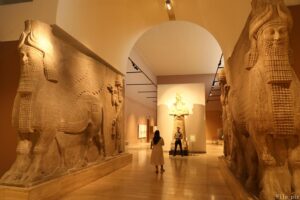
The National Museum of Iraq is one of the most important museums in the world, with a vast collection of artifacts and treasures that span thousands of years of history. Go see the museum’s many exhibits, which include ancient Mesopotamian artifacts, Islamic art, and much more.
Explore the Al-Mutanabbi Street
Al-Mutanabbi Street is one of the oldest and most famous streets in Baghdad, known for its many bookstores, cafes, and shops. In here you can spend hours exploring the street, browsing books and handicrafts, and enjoying the vibrant energy of Baghdad’s street life.
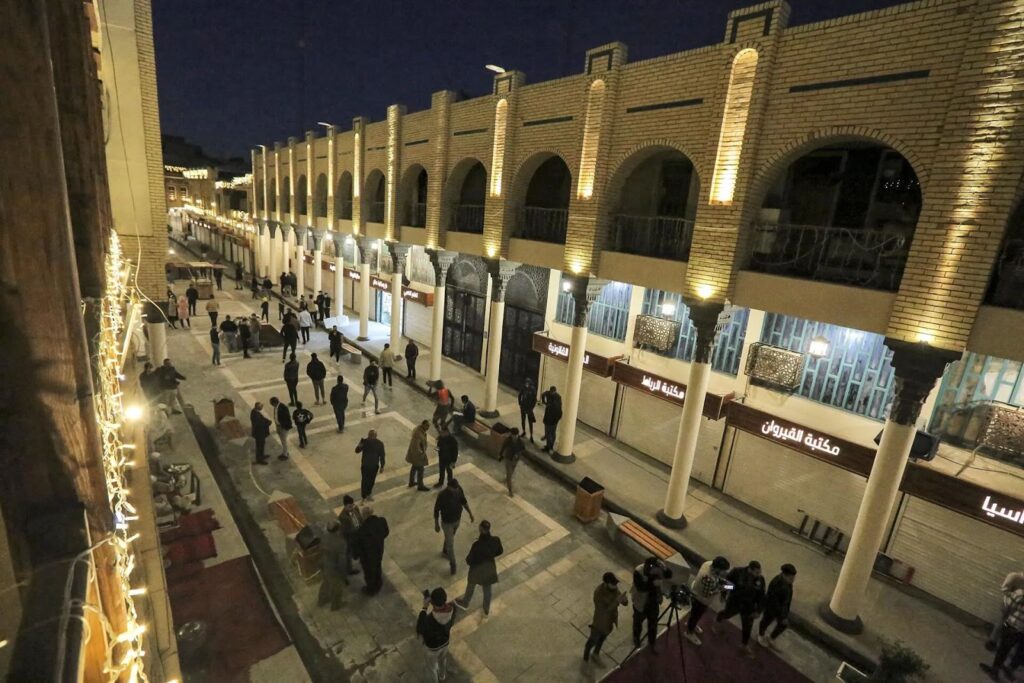
Visit the Al-Kadhimiya Shrine

The Al-Kadhimiya Shrine is one of the most important Shiite shrines in the world, located in the heart of Baghdad. You can learn about the history and culture of the city by exploring the shrine, which is home to many beautiful mosques and shrines.
Take a stroll in Zawra Park

Zawra Park is one of the largest and most beautiful parks in Baghdad, with a large lake, many gardens, and plenty of space to relax and enjoy the outdoors. Take a stroll around the park, enjoy a picnic, or rent a boat to explore the lake.
Enjoy the local cuisine
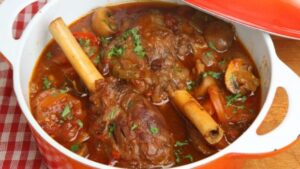
Baghdad is known for its delicious and diverse cuisine, which includes dishes such as biryani, kebabs, and falafel. Visitors can explore the city’s many restaurants and cafes, sample local dishes, and enjoy the unique flavors of Baghdad’s culinary scene.
You’ve noticed .. Baghdad has many experiences to offer visitors, from exploring its rich history and culture to enjoying its colorful street life and delicious cuisine. By visiting the National Museum of Iraq, exploring Al-Mutanabbi Street, visiting the Al-Kadhimiya Shrine, taking a stroll in Zawra Park, and enjoying the local cuisine, you can have an unforgettable trip to this fascinating city.
The Best Places To Visit In Baghdad
Baghdad, the capital city of Iraq, has a long and fascinating history that dates back over a thousand years. The city was founded in the 8th century by the Abbasid Caliphate and quickly grew to become one of the most important centers of trade, culture, and scholarship in the Islamic world. Baghdad played a crucial role in the development of Islamic civilization and was a hub for scholars, artists, and thinkers from across the Islamic world.
Throughout its history, Baghdad has experienced many significant events, including wars, invasions, and revolutions. Despite the many challenges the city has faced, it has remained a vital center of culture, education, and trade, attracting travelers and traders from all over the world. Baghdad’s location on the Tigris River and its strategic position between East and West has made it a significant center for commerce and cultural exchange.
Today, Baghdad is a city of contrasts, with a rich history and a complex present. The city has a population of over eight million people and is a critical center of government, commerce, and industry in Iraq. Despite the many challenges it faces, Baghdad is a city that is full of life and energy, with a unique culture and a warm hospitality that welcomes visitors from around the world.
As a tourist destination, Baghdad offers a wealth of experiences for travelers who are interested in exploring the city’s rich history and culture. Discover the city’s many museums, including the National Museum of Iraq, which contains a vast collection of ancient artifacts and treasures that span thousands of years of history. The city’s many parks and gardens, including Zawra Park, offer a peaceful respite from the hustle and bustle of the city and a chance to enjoy the natural beauty of the region.
Baghdad is also home to many important religious sites, including the Al-Kadhimiya Shrine, one of the most significant Shiite shrines in the world. You can learn about the history and culture of the city by exploring its many mosques and shrines, which offer a glimpse into the rich spiritual traditions of the region.
Baghdad is a city of great historical and cultural significance that offers a wealth of experiences for travelers who are interested in exploring the region’s rich history and culture. With its many museums, parks, gardens, and religious sites, Baghdad is a city that is full of surprises and a must-visit destination for anyone interested in the Middle East.
1. Al-Mutanabbi Street: Named after the famous 10th-century Iraqi poet, this street is a lively market for books, stationery, and art supplies.
2. National Museum of Iraq: This museum houses a collection of artifacts and treasures that date back to thousands of years, including ancient Mesopotamian art and artifacts from the Babylonian and Assyrian empires.
3. Al-Mustansiriya School: One of the oldest universities in the world, this school dates back to the 13th century and offers a glimpse into the rich history of Islamic education.
4. Al-Shaheed Monument: This monument is a tribute to the Iraqi soldiers who died in the Iran-Iraq War and the Gulf War. It offers a stunning view of the city and a chance to reflect on the sacrifices made by the Iraqi people.
5. Zawra Park: This park is one of the largest in Baghdad and offers a peaceful respite from the hustle and bustle of the city. It features gardens, a lake, and a zoo.
6. Baghdadi Museum: This museum houses a collection of artifacts that showcase the history and culture of Baghdad, including pottery, textiles, and manuscripts.
7. Al-Kadhimiya Mosque: This mosque is one of the most significant Shiite shrines in the world and is a pilgrimage site for millions of Muslims every year.
8. Al-Zawra’a Gallery of Fine Arts: This gallery features works of art by Iraqi artists, showcasing the rich artistic traditions of the region.
9. Al-Mahalla al-Mubarakia: This market is one of the oldest in Baghdad and offers a chance to experience the traditional shopping experience of the city.
10. Al-Mutanabi Statue: This statue is a tribute to the famous Iraqi poet, Al-Mutanabbi, and is a popular destination for visitors to the city who want to learn more about the rich literary traditions of Iraq.
1. Al-Mutanabbi Street

Al-Mutanabbi Street is a historic street in the heart of Baghdad, Iraq. It has been the center of Baghdad’s bookselling and publishing community for centuries, and is named after the famous Arab poet, Al-Mutanabbi.
The street has been a hub of literary and cultural activity for generations, with numerous bookstores, cafes, and other cultural institutions lining its sidewalks. It has been a popular destination for Iraqi intellectuals, writers, and artists.
In 2007, the street was the site of a devastating bombing that killed dozens of people and destroyed many of the bookstores and cultural institutions that made the street famous. The attack was widely seen as an attempt to silence Iraq’s literary and cultural community.
Despite the damage, the booksellers and cultural institutions on Al-Mutanabbi Street have worked tirelessly to rebuild and restore the street to its former glory. The street has become a symbol of resilience and perseverance, and a testament to the power of literature and culture to bring people together.
2. National Museum of Iraq
The National Museum of Iraq is located in Baghdad and is one of the most important museums in the Middle East. The museum’s collection includes artifacts from ancient Mesopotamia, which is often referred to as the cradle of civilization, as well as from other periods of Iraqi history.
The museum was established in 1926 and over the years, it has amassed a vast collection of artifacts, including pottery, sculpture, jewelry, and other objects from the Sumerian, Babylonian, and Assyrian periods. The museum also features exhibits from the Islamic period, as well as from Iraq’s more recent history.
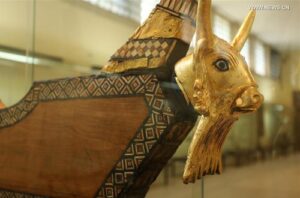
During the Iraq War in 2003, the museum was looted and many of its artifacts were stolen. While some of the items have since been recovered, many are still missing. The looting of the museum is widely regarded as one of the greatest cultural tragedies of the war.
Despite the loss of many of its treasures, the National Museum of Iraq remains an important institution for the preservation and promotion of Iraq’s cultural heritage. The museum continues to display artifacts that survived the looting, and efforts are underway to recover the stolen items and restore the museum to its former glory.
3. Al-Mustansiriya School
The Al-Mustansiriya School is a historic Islamic institution of higher learning that was founded in 1227 in Baghdad, Iraq by the Abbasid caliph Al-Mustansir. It was one of the oldest universities in the world and became a center of learning and intellectual discourse in the Islamic Golden Age.
The school offered courses in a wide range of subjects, including Islamic law, theology, Arabic grammar, literature, mathematics, astronomy, medicine, and philosophy. Many prominent scholars, including Ibn Taymiyyah, Ibn Arabi, and Ibn Khaldun, studied or taught at Al-Mustansiriya.
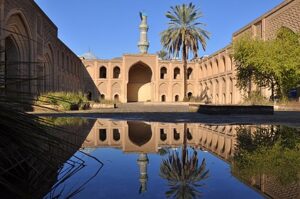
The school was heavily damaged during the Mongol invasion of Baghdad in 1258 and was subsequently rebuilt and expanded under the rule of the Ilkhanid dynasty. It continued to operate as a major center of learning until the 20th century, when it was absorbed into the modern Iraqi education system.
Today, the Al-Mustansiriya School remains an important cultural and historical site in Baghdad, and efforts are underway to preserve and restore its buildings and artifacts.
4. Al-Shaheed Monument
The Al-Shaheed Monument, also known as the Martyr’s Memorial, is a monument located in Baghdad, Iraq that was built in 1983 to commemorate Iraqi soldiers who died in the Iran-Iraq War. The monument is shaped like a giant arch and stands at a height of 40 meters (130 feet), with an internal space of 900 square meters (9,700 square feet).
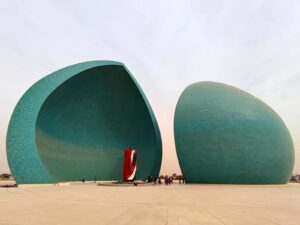
The arch is made of concrete and is adorned with reliefs and carvings that depict scenes from the war, including soldiers, weapons, and the Iraqi flag. At the center of the monument is a flame-shaped structure that is illuminated at night.
The Al-Shaheed Monument is one of the most iconic landmarks in Baghdad and has become a symbol of Iraq’s struggle and sacrifice during the Iran-Iraq War. It is also a popular tourist attraction, with visitors from around the world coming to see the monument and learn more about Iraq’s history and culture.
Despite its cultural and historical significance, the monument has been subject to damage and neglect over the years due to wars and conflict in the region. However, efforts are underway to restore and preserve the monument for future generations to appreciate and admire.
5. Zawra Park
Zawra Park, also known as Al Zawraa Park, is a public park located in the heart of Baghdad, Iraq. It was established in the early 20th century and covers an area of approximately 31 hectares (77 acres), making it one of the largest parks in the city.
The park features a variety of amenities and attractions, including playgrounds, fountains, walking paths, and picnic areas. It also houses several important cultural and historical landmarks, such as the Baghdad Zoo, the Al Zawraa Stadium, and the Iraqi National Museum.
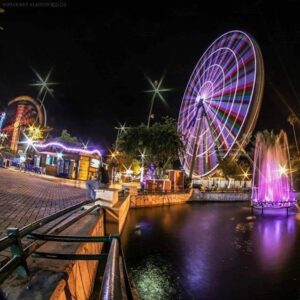
The Baghdad Zoo, located within Zawra Park, is one of the oldest and largest zoos in the Middle East. It was established in the 1970s and houses a diverse collection of animals, including lions, tigers, bears, monkeys, and exotic birds.
The Al Zawraa Stadium, located adjacent to the park, is a multi-purpose sports venue that can accommodate up to 12,000 spectators. It has been used for various sporting events over the years, including football matches, athletics competitions, and cultural festivals.
The Iraqi National Museum, also located within the park, is one of the most important cultural institutions in Iraq. It houses a vast collection of artifacts and exhibits that showcase the rich history and cultural heritage of the region, from ancient Mesopotamia to the present day.
Zawra Park is a popular destination for locals and tourists alike, offering a peaceful oasis in the midst of the bustling city. It is a great place to relax, enjoy the outdoors, and learn more about Iraq’s rich cultural and historical heritage.
6. Baghdadi Museum
The Baghdadi Museum, also known as the Baghdadi Jewish Museum, is a museum located in the Al-Allawi district of Baghdad, Iraq. It was established in 2018 and is dedicated to showcasing the history and cultural heritage of the Jewish community in Baghdad.
The museum is housed in a restored 1920s-era villa that once belonged to a prominent Baghdadi Jewish family. It features exhibits that highlight the contributions of the Jewish community to Iraqi culture, including their role in the arts, literature, music, and cuisine.
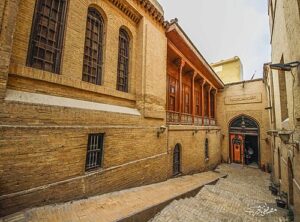
The museum’s collection includes a wide range of artifacts and memorabilia, such as photographs, documents, books, and religious objects. One of the museum’s most prized possessions is a rare copy of the Babylonian Talmud, a central text of Jewish law and tradition.
In addition to its permanent collection, the museum also hosts temporary exhibitions, lectures, and cultural events that promote interfaith dialogue and understanding. It serves as a bridge between Iraq’s diverse communities, promoting tolerance and respect for all faiths and cultures.
The Baghdadi Museum is an important cultural institution in Baghdad and a symbol of Iraq’s rich multicultural heritage. It is a must-visit destination for anyone interested in learning more about the history and culture of the Jewish community in Baghdad and their contributions to the broader Iraqi society.
7. Al-Kadhimiya Mosque
The Al-Kadhimiya Mosque is a Shia Muslim shrine located in the Kadhimiya district of Baghdad, Iraq. It is one of the holiest sites in Shia Islam and is dedicated to the seventh Shia Imam, Musa al-Kadhim, and his grandson, Muhammad al-Jawad.
The mosque was first built in the 8th century during the Abbasid Caliphate and has been renovated and expanded many times over the centuries. It features a large central dome and several smaller domes, as well as minarets, courtyards, and prayer halls.

The Al-Kadhimiya Mosque is a popular destination for Shia Muslims from around the world who come to pay their respects and offer prayers at the shrine of Imam Musa al-Kadhim and Imam Muhammad al-Jawad. The mosque is particularly crowded during the annual commemoration of their martyrdom, known as Arba’een, which draws millions of pilgrims to Kadhimiya.
In addition to its religious significance, the Al-Kadhimiya Mosque is also an important cultural landmark in Baghdad. It has been the site of many important historical events and has played a key role in shaping the social and political landscape of Iraq.
Despite its significance, the mosque has been subject to damage and destruction over the years due to wars and conflict in the region. However, efforts are underway to restore and preserve the mosque for future generations to appreciate and admire.
8. Al-Zawra’a Gallery of Fine Arts
The Al-Zawra’a Gallery of Fine Arts is a prominent art museum located in the Al-Mansour district of Baghdad, Iraq. It was founded in 1964 and is considered one of the most important cultural institutions in the country.
The gallery’s collection features a wide range of artworks, including paintings, sculptures, ceramics, and textiles, that showcase the rich artistic heritage of Iraq and the broader Middle East. The collection includes works by many famous Iraqi artists, as well as pieces from other countries in the region.
The Al-Zawra’a Gallery of Fine Arts is known for its commitment to promoting contemporary art and supporting emerging artists. It hosts regular exhibitions, workshops, and cultural events that bring together artists, art enthusiasts, and the broader public.The gallery is housed in a modernist building designed by the renowned Iraqi architect Rifat Chadirji. The building features several galleries and exhibition spaces, as well as a library, lecture hall, and artist studios.
Despite facing challenges due to the ongoing conflicts in the region, the Al-Zawra’a Gallery of Fine Arts continues to be a vital and lively center for art and culture in Iraq. It serves as an important platform for artistic expression, creativity, and dialogue, and is a testament to the resilience and spirit of the Iraqi people
9. Al-Mahalla al-Mubarakia:
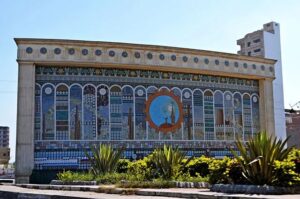
The Al-Mahalla al-Mubarakia market is a famous traditional bazaar located in the heart of Baghdad, Iraq. It is a historic market that dates back to the Ottoman era and is considered one of the oldest and most popular markets in the city.
The market is known for its lively atmosphere, bustling crowds, and colorful displays of goods. It features a wide range of shops and stalls selling everything from spices, herbs, and teas to textiles, clothes, and souvenirs.
Visitors to the market can also find traditional food vendors selling a variety of local specialties, including falafel, shawarma, and kebabs. The market is also a great place to experience the rich cultural heritage of Iraq, with live music, street performers, and traditional handicrafts on display.
Despite facing challenges due to the ongoing conflicts in the region, the Al-Mahalla al-Mubarakia market continues to be a lively center of commerce and culture in Baghdad. It is a must-visit destination for anyone interested in experiencing the sights, sounds, and flavors of the city’s rich history and heritage.
10. Al-Mutanabi Statue
The Al-Mutanabi Statue is a prominent landmark located in Al-Mutanabi Street, a cultural district in central Baghdad. It is a bronze statue that was erected in honor of the famous 10th-century Iraqi poet, Al-Mutanabi, who is widely regarded as one of the greatest poets in the Arabic language.
The statue was designed by the Iraqi sculptor, Mohammed Ghani Hikmat, and was unveiled in 1971. It is a popular destination for locals who come to pay their respects to the poet and to enjoy the cultural atmosphere of the area.
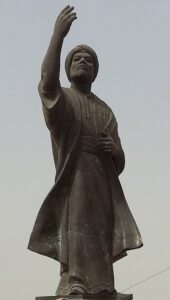
The Al-Mutanabi Statue has great historical and cultural significance in Iraq, as Al-Mutanabi is considered a national hero and an icon of Iraqi literature. The statue serves as a reminder of Iraq’s rich cultural heritage and the important role that literature and poetry have played in the country’s history.
Despite facing challenges in recent years due to the ongoing conflicts in the region, the Al-Mutanabi Statue remains a symbol of Iraq’s resilience and its commitment to preserving its cultural identity. It is a must-see destination for anyone interested in the history and culture of Baghdad and the broader Middle East.
Erbil: The Capital Of Kurdistan: Why You Should Add Erbil On Your Bucket List
Erbil, also known as Hawler in Kurdish, is one of the oldest continuously inhabited cities in the world, with a history dating back over 6,000 years. Located in the northern region of Iraq, Erbil has been a hub of trade and cultural exchange for millennia, serving as a crossroads between the East and the West.
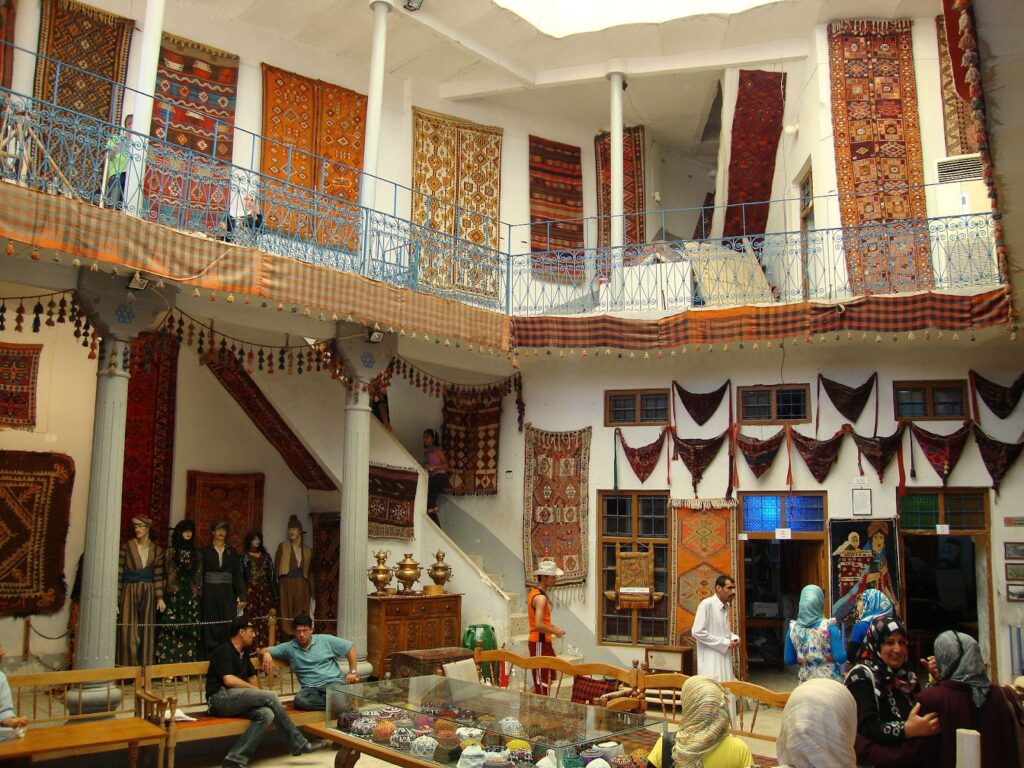
Throughout its long and storied history, Erbil has been ruled by various empires and civilizations, including the Sumerians, Assyrians, Babylonians, Persians, Greeks, Romans, and Arabs. Each of these groups left their mark on the city, contributing to its unique cultural and architectural heritage. Today, Erbil is a dynamic city that combines its rich history with modern amenities and infrastructure. As the capital of the autonomous Kurdistan Region of Iraq, Erbil is a major center of commerce, education, and tourism in the region.
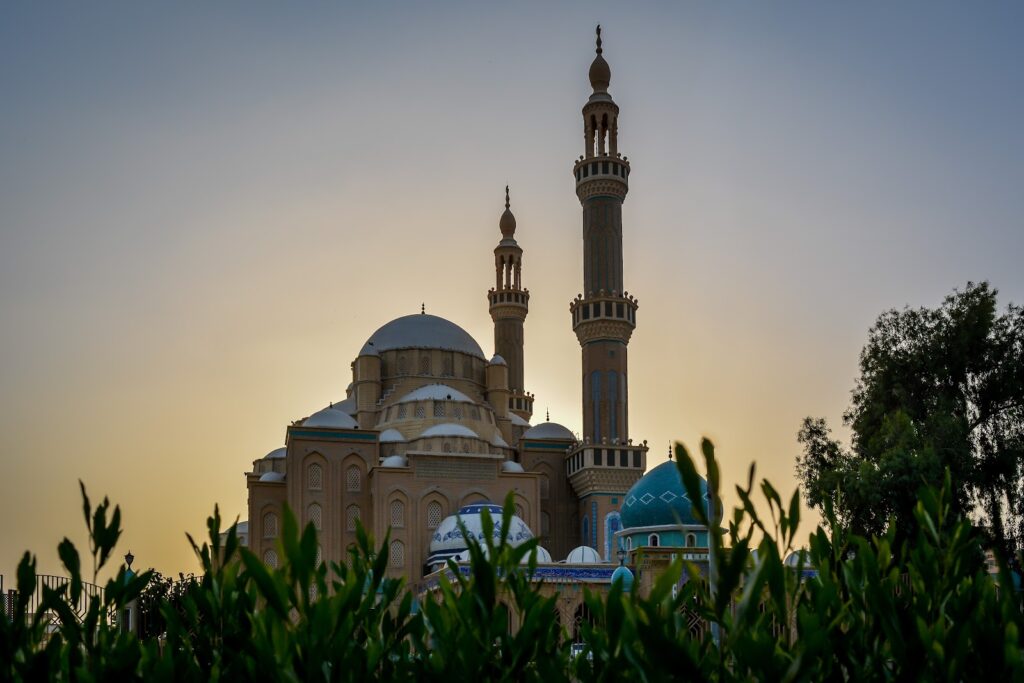
Despite the ongoing challenges faced by Iraq in recent years, Erbil has remained a relatively safe and stable destination for visitors. The city is known for its friendly people, welcoming atmosphere, and stunning natural beauty. Erbil has a wealth of cultural and historical attractions, including ancient ruins, museums, and traditional bazaars. One of the most popular attractions is the historic Citadel of Erbil, a UNESCO World Heritage site that dates back to the 6th millennium BC. The citadel is an impressive example of ancient architecture and has been inhabited continuously for thousands of years.
In addition to its historical and cultural attractions, Erbil also offers a range of modern amenities, including luxury hotels, shopping malls, and international restaurants. The city is known for its nightlife, with a wide range of bars and clubs catering to both locals and visitors.
For those interested in outdoor activities, Erbil offers a wealth of opportunities for adventure and exploration. The surrounding countryside is dotted with scenic hiking trails, picturesque villages, and natural hot springs. The nearby Gali Ali Beg waterfall is a particularly popular destination for visitors, offering stunning views of the surrounding landscape.

There are many reasons to visit Erbil, but here are the most compelling:
Historical and cultural attractions: Erbil has a rich and diverse cultural heritage, with a wealth of ancient ruins, museums, and traditional bazaars to explore.
Friendly people and welcoming atmosphere: Visitors to Erbil are often struck by the warmth and hospitality of the locals, who are known for their friendliness and welcoming nature.
Stunning natural beauty: Erbil is surrounded by rugged mountains, picturesque valleys, and crystal-clear lakes, offering a wealth of opportunities for outdoor adventure and exploration.
Modern amenities and infrastructure: Despite its long history, Erbil has a range of modern amenities and infrastructure, including luxury hotels, shopping malls, and international restaurants.
Safety and stability: Despite the challenges faced by Iraq in recent years, Erbil has remained a relatively safe and stable destination for visitors, offering a unique and rewarding travel experience.
Erbil City Guide: The Best Places To Visit In The Capital Of Kurdistan
Erbil, is the capital city of the Kurdistan Region of Iraq. With a history spanning over 6,000 years, Erbil is one of the oldest continuously inhabited cities in the world. The city has played a significant role in the history of the region, serving as a cultural and economic hub for centuries. The city’s strategic location has also made it a battleground for many conflicts throughout history.
Despite its turbulent past, Erbil has emerged as a vibrant and modern city in recent years, offering a unique blend of ancient and modern culture. With its rich history, diverse culture, and beautiful surroundings, Erbil is a must-visit destination for anyone interested in history, architecture, and cultural experiences.
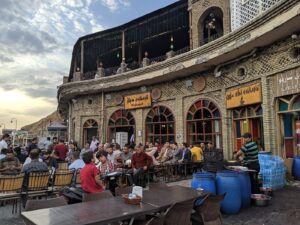
One of the main reasons why Erbil is such a beautiful city is its unique mix of architectural styles. The city boasts an array of historical landmarks, including the ancient Citadel of Erbil, which is a UNESCO World Heritage site. The citadel, which dates back to the 6th millennium BCE, is one of the most impressive examples of ancient architecture in the region.
Apart from the Citadel, Erbil is home to many other historical and cultural sites, such as the Erbil Bazaar, the Kurdish Textile Museum, and the Qaysari Bazaar. The city also offers an abundance of natural beauty, with its surrounding mountains and valleys providing the perfect backdrop for outdoor activities such as hiking and camping.
If you are planning a trip to Erbil, here are the ten best destinations that you should not miss:
The Citadel of Erbil: This ancient fortress is the most iconic landmark in Erbil, and a must-visit for anyone interested in history and architecture. The citadel, which dates back to the 6th millennium BCE, is home to several museums and historical sites.
The Erbil Bazaar: This marketplace is the perfect place to experience the lively culture of Erbil. The bazaar, which dates back to the 14th century, offers an array of goods, including traditional handicrafts, spices, and clothing.
The Kurdish Textile Museum: This unique museum showcases the rich history of Kurdish textile art. You’ll find a wide range of textiles, including traditional carpets, kilims, and embroidery.
The Qaysari Bazaar: This colorful market is located within the Citadel of Erbil and offers an authentic shopping experience. Here you can browse a variety of goods, including spices, clothing, and souvenirs.
The Sami Abdulrahman Park: This beautiful park is the perfect place to relax and enjoy nature in the heart of the city. The park features a large lake, walking trails, and several play areas for children.
The Jalil Khayat Mosque: This stunning mosque is one of the largest and most beautiful in Erbil. Admire the intricate architecture and decorative features, including the colorful tiles and ornate minaret.
The Shanidar Cave: This ancient cave system is located near the town of Zagros, just outside of Erbil. The caves are famous for their archaeological significance, including the discovery of the remains of Neanderthal and early modern humans.
The Mudhafaria Minaret: This historic minaret is one of the oldest in Erbil, dating back to the 12th century. Visitors can climb to the top of the minaret for panoramic views of the city.
The Maziyan Waterfall: This stunning waterfall is located in the mountains outside of Erbil. The waterfall is surrounded by lush greenery and offers a refreshing escape from the city.
1. The Citadel of Erbil
The Citadel of Erbil is a stunning historical landmark that has been a symbol of the Kurdish people for centuries. The Citadel is located in the center of the city, and its towering walls and ramparts are visible from miles around. The Citadel dates back to at least the 4th millennium BC, and has been continuously inhabited since then. The site has been occupied by various civilizations throughout history, including the Sumerians, Akkadians, Assyrians, Persians, Greeks, Romans, and Arabs. In 2006, the Citadel was declared a UNESCO World Heritage site in recognition of its outstanding cultural and historical value.

The Citadel’s distinctive architecture and strategic location have played an important role in shaping the history and culture of the Kurdish people. The site is a testament to the resilience and resourcefulness of the Kurdish people, who have maintained their identity and culture despite centuries of political upheaval and foreign occupation. Today, the Citadel is a vibrant and diverse community, home to hundreds of families who have lived there for generations. Visitors can explore the Citadel’s winding alleys and streets, marvel at its historic landmarks, and soak up the atmosphere of one of the oldest and most culturally significant sites in the world.
2. The Erbil Bazaar
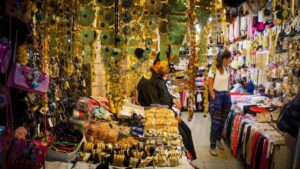
The Erbil Bazaar is a colorful marketplace that has been a hub of commerce and culture in Erbil for centuries. The Bazaar is a labyrinth of narrow alleys and streets, lined with shops and stalls selling everything from spices and textiles to jewelry and electronics. The Bazaar dates back to the Ottoman period, and is considered one of the largest and oldest bazaars in the Middle East. The Bazaar is a microcosm of Kurdish culture, where visitors can experience the sights, sounds, and smells of daily life in Erbil.
The Erbil Bazaar is not just a place to shop, but also a social and cultural hub for the local community. It is a place where people from all walks of life come to meet, eat, and socialize. The Bazaar is a vibrant and dynamic place, where visitors can experience the energy and diversity of Erbil’s Kurdish community. From the colorful spices and textiles to the mouth-watering food and lively street performances, the Erbil Bazaar is a sensory feast that should not be missed.
3. The Kurdish Textile Museum
The Kurdish Textile Museum is a unique and fascinating museum that showcases the rich history and culture of Kurdish textiles. The museum is located in the heart of Erbil, and houses a collection of over 2,000 textiles, including traditional clothing, carpets, and tapestries. The textiles on display are known for their intricate designs, vivid colors, and cultural significance.
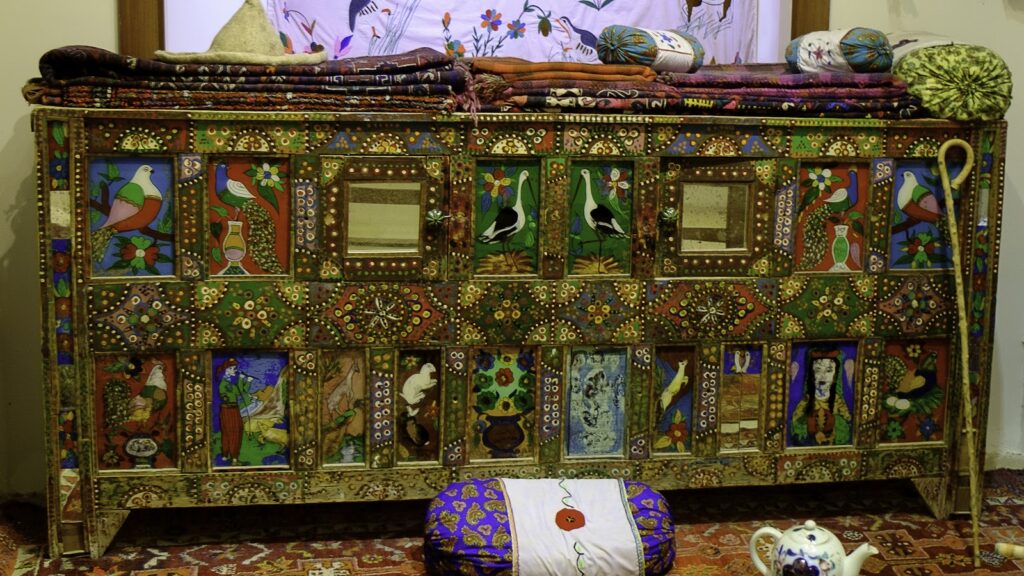
The museum is a celebration of Kurdish artistry and creativity, and provides visitors with a rare glimpse into the techniques and traditions of Kurdish weaving. The museum features exhibits on the history and symbolism of Kurdish textiles, as well as demonstrations of traditional weaving techniques. The museum is a must-visit for anyone interested in the arts and crafts of the Middle East, and provides a unique window into the cultural heritage of the Kurdish people.
In conclusion, the Citadel of Erbil, the Erbil Bazaar, and the Kurdish Textile Museum are just a few of the many amazing destinations in Erbil. Whether you are interested in history, culture, or just exploring new places, Erbil has something to offer everyone. From the stunning ancient landmarks to the markets and museums, Erbil is a city that is sure to captivate and inspire all who visit.
4. The Qaysari Bazaar
Tucked away in the heart of a historic district lies the Qaysari Bazaar, an enchanting maze of narrow alleyways and covered market stalls bursting with color and character. This traditional marketplace has been a hub of commerce for centuries, offering locals and tourists alike a glimpse into the vibrant culture and rich history of the region.
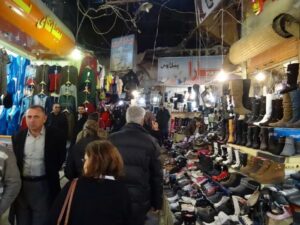
As you meander through the winding streets of the bazaar, the scents of exotic spices and fragrant teas waft through the air, mingling with the lively chatter of merchants and shoppers haggling over prices. You’ll find everything from handcrafted textiles and intricate jewelry to fresh produce and handmade pottery, all displayed with pride and precision by the skilled vendors who call this market home.
But the Qaysari Bazaar is more than just a place to shop. It’s a living, breathing testament to the resilience and spirit of the people who have made this region their home, surviving and thriving through countless wars, conflicts, and changes over the centuries. Whether you’re into history, a culture enthusiast, or simply looking for a unique shopping experience, the Qaysari Bazaar is a must-visit destination that will leave you spellbound.
5. The Sami Abdulrahman Park
Nestled in the heart of a bustling city lies a peaceful oasis, a haven of greenery and tranquility amidst the chaos of modern life. The Sami Abdulrahman Park is a stunning public park that spans over 100 acres, offering visitors a respite from the noise and crowds of the city.

As you stroll through the park’s winding pathways, you’ll be surrounded by lush trees, fragrant flowers, and a serene lake that reflects the beauty of the surrounding landscape. The park is home to a wide variety of flora and fauna, including rare birds and endangered species, making it a paradise for nature lovers and wildlife enthusiasts.
But the Sami Abdulrahman Park is more than just a pretty picture. It’s a vital part of the community, offering locals and visitors alike a place to gather, relax, and connect with nature. The park is home to a variety of cultural and recreational activities throughout the year, from music festivals and outdoor concerts to picnics and family-friendly events. Whether you’re looking for a quiet moment of solitude or a fun day out with friends and family, the Sami Abdulrahman Park is a destination that should not be missed.
6. The Jalil Khayat Mosque
Standing tall and proud in the heart of a bustling city is the Jalil Khayat Mosque, a magnificent work of art and architecture that is as beautiful as it is inspiring. This grand mosque is a testament to the deep spiritual and cultural roots of the community, a beacon of hope and faith that has stood the test of time.
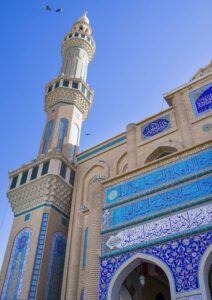
As you approach the mosque, you’ll be struck by its intricate geometric patterns, soaring arches, and stunning minarets that rise up towards the sky. The interior of the mosque is equally awe-inspiring, with a peaceful and serene atmosphere that invites visitors to reflect and connect with their spiritual side.
But the Jalil Khayat Mosque is more than just a religious site. It’s a cultural landmark, a place where locals and visitors alike can come together to celebrate the rich diversity and heritage of the region. The mosque hosts a variety of events and activities throughout the year, from religious festivals and cultural exhibitions to educational programs and community outreach initiatives. Whether you’re a devout worshipper or simply interested in learning more about the local culture, the Jalil Khayat Mosque is a destination that is sure to leave a lasting impression.
7. The Shanidar Cave
Nestled in the foothills of a stunning mountain range lies the Shanidar Cave, an ancient and awe-inspiring natural wonder that has captured the imagination of adventurers and scientists alike for centuries. This cave has been home to humans for over 60,000 years, making it one of the most important archaeological sites in the world.
As you descend into the depths of the cave, you’ll be transported back in time to an era when our ancestors lived and thrived in this harsh and unforgiving environment. The cave is home to a variety of unique and rare artifacts, including ancient tools, artwork, and even the remains of Neanderthal humans. The cave is a testament to
the resilience and ingenuity of the human spirit, and a reminder of our deep connection to the natural world.
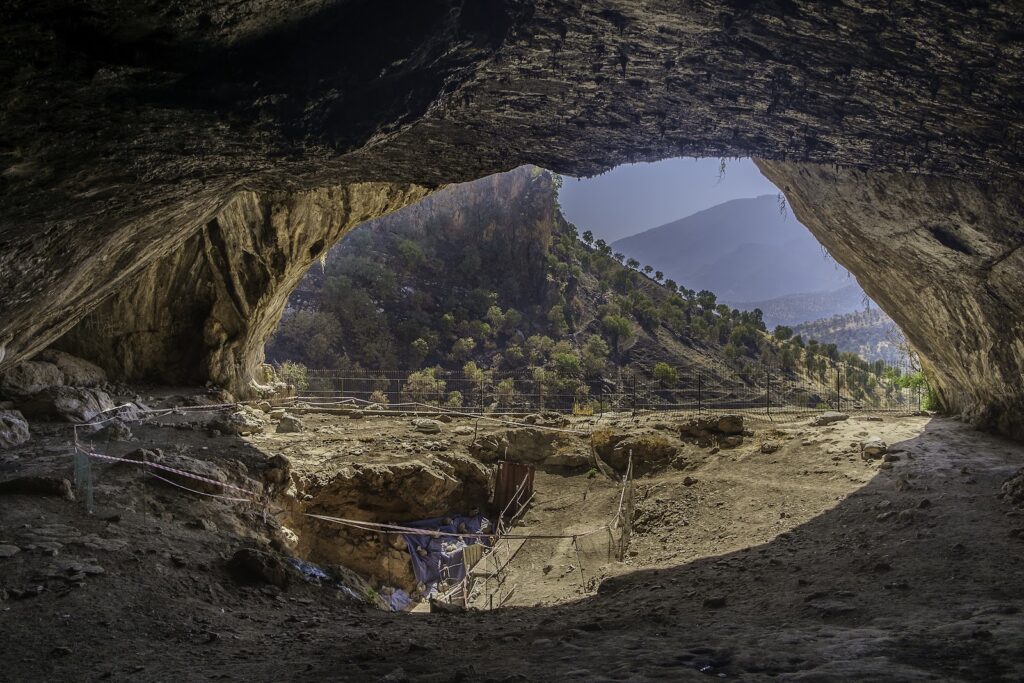
The Shanidar Cave is a living, breathing ecosystem that is home to a variety of flora and fauna, including rare species of plants and animals that can’t be found anywhere else in the world. Whether you’re an adventurer, a nature lover, or a history enthusiast, the Shanidar Cave is a destination that will leave you in awe.
8. The Mudhafaria Minaret
Rising up above the skyline of a colorful city is the Mudhafaria Minaret, a stunning work of art and architecture that is as beautiful as it is inspiring. This towering minaret has stood for centuries, a testament to the rich cultural and religious heritage of the region.
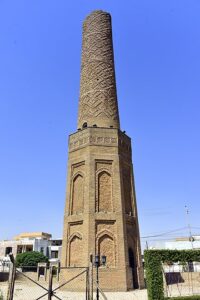
You’ll be struck by its intricate geometric patterns, soaring arches, and stunning mosaics that reflect the beauty and complexity of Islamic art and design. The minaret is a symbol of the deep spiritual and cultural roots of the community, a place where worshippers come together to pray and connect with their faith.
The Mudhafaria Minaret is an important cultural landmark, a place where locals and visitors alike can come together to celebrate the rich diversity and heritage of the region. Whether you’re a devout worshipper or simply interested in learning more about the local culture, the Mudhafaria Minaret is a destination that is sure to leave a lasting impression.
9. The Maziyan Waterfall
Hidden away in a remote and unspoiled corner of the countryside lies the Maziyan Waterfall, a natural wonder that is as breathtaking as it is peaceful. This stunning waterfall cascades down a series of rocky cliffs and pools, surrounded by lush vegetation and towering trees.
As you approach the waterfall, you’ll be struck by the powerful sound of rushing water and the cool mist that rises up from the pools below. The waterfall is a haven for nature lovers and adventure seekers alike, offering a variety of hiking trails and scenic overlooks that provide stunning views of the surrounding landscape.
It’s a vital part of the local ecosystem, supporting a variety of rare and endangered species of plants and animals that rely on the waterfall for their survival. Whether you’re looking for a quiet moment of solitude or an exciting outdoor adventure, the Maziyan Waterfall is a destination that should not be missed
What To Visit In Kirkuk, Iraq?
Kirkuk is a historic city located in northern Iraq, situated about 238 kilometers north of the country’s capital, Baghdad. The city lies on the banks of the Khasa River and is surrounded by lush greenery and towering mountains. The area has been inhabited since ancient times and has a rich and complex history that has shaped the region’s culture, economy, and people.
Kirkuk’s history dates back to the Neolithic period, and it has been home to many civilizations over the centuries, including the Akkadian Empire, the Assyrian Empire, and the Babylonians. In the 7th century, the Islamic Arab Empire conquered the region and brought Islam to Kirkuk. During the Ottoman era, the city became a significant center of commerce and trade, with its strategic location along the Silk Road.
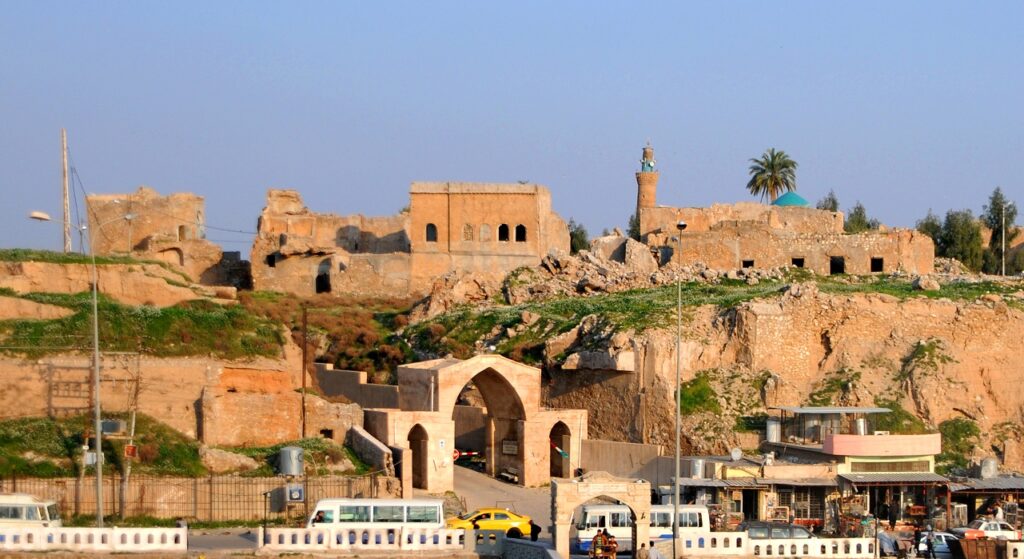
In the 20th century, Kirkuk played a crucial role in Iraq’s oil industry, with its vast oil reserves contributing significantly to the country’s economy. However, the city’s wealth also made it a target for power struggles, leading to several conflicts throughout the 20th century. The city was also heavily impacted by the Iran-Iraq War and the Gulf War, which left its infrastructure and economy in disrepair.
Despite its troubled past, Kirkuk remains a beautiful and culturally rich city that is full of history and potential for tourism. The city’s architecture reflects its diverse history, with buildings and landmarks from various periods and styles, including Ottoman, Islamic, and modern influences.
One of the most famous landmarks in Kirkuk is the Kirkuk Citadel, which dates back to the 10th century and is a testament to the city’s ancient roots. The citadel is made of mud brick and has been carefully restored in recent years, making it an impressive sight for visitors.
Another popular attraction in Kirkuk is the Qaysari Bazaar, which is a vibrant and bustling marketplace that has been in operation for centuries. The bazaar is known for its traditional crafts, including pottery, carpets, and textiles, and visitors can see artisans at work and purchase authentic souvenirs.
For nature lovers, Kirkuk has plenty to offer, with its lush parks and green spaces, including the Azadi Park and the Kirkuk Zoo. The city’s location also makes it an excellent base for exploring the surrounding mountains and natural landscapes.
In recent years, efforts have been made to promote tourism in Kirkuk, with the government investing in infrastructure and tourist facilities. The city has a growing number of hotels and restaurants, making it an ideal destination for travelers looking to experience Iraq’s rich history and culture.
Kirkuk is a city with a complex and fascinating history that has left its mark on the region’s architecture, culture, and people. Despite its troubled past, the city has enormous potential for tourism, with its unique blend of ancient and modern attractions and beautiful natural surroundings. Whether you are interested in history, culture, or nature, Kirkuk has something to offer everyone, and it is sure to leave a lasting impression on anyone who visits.
Here’s a list of the best places to visit when you travel to Kirkuk, Iraq.
1. Citadel of Kirkuk

The Citadel of Kirkuk is a must-see attraction in the city. Built in the 12th century, the citadel has been used as a fortress, a palace, and a prison throughout its long history. Today, it is a UNESCO World Heritage Site and houses a museum that showcases the region’s rich cultural heritage.
2. Qaysari Bazaar
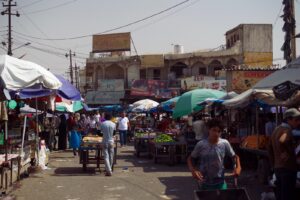
The Qaysari Bazaar is a lively market that has been in operation for centuries. It is the perfect place to experience the sights, sounds, and smells of Kirkuk. The bazaar is home to a variety of shops selling everything from spices and textiles to jewelry and souvenirs.
3. Kirkuk Museum
The Kirkuk Museum is a great place to learn about the region’s history and culture. The museum’s exhibits include artifacts from ancient civilizations, as well as items from more recent history. Highlights include the Isin-Larsa tablet, which dates back to 2000 BC, and the Akkadian cylinder seal, which dates back to 2300 BC.
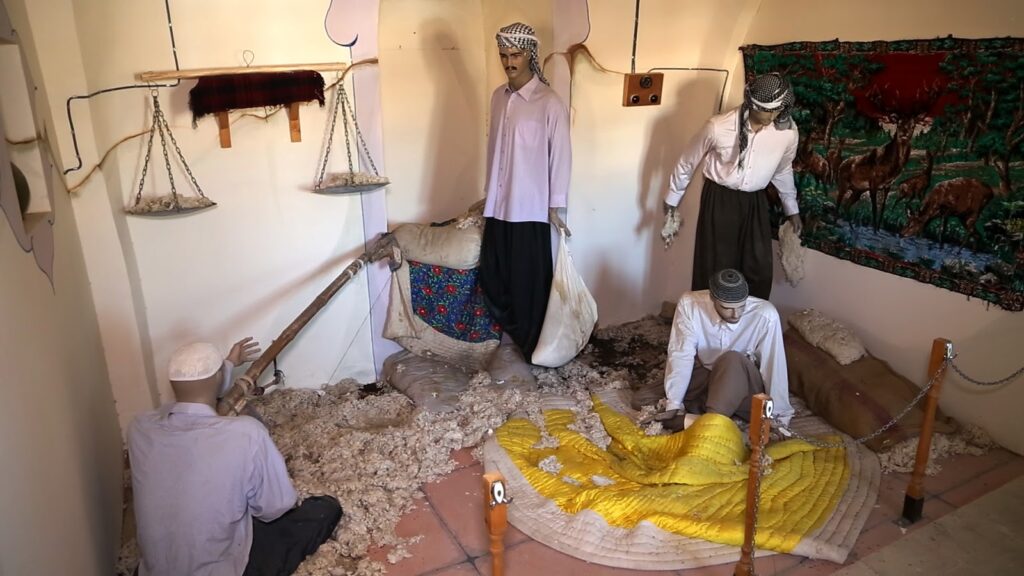
4. Kirkuk Lake
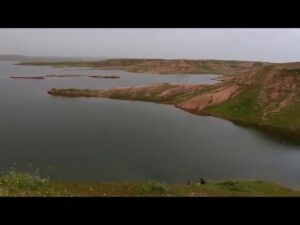
Kirkuk Lake is a beautiful natural attraction located just outside the city. The lake is surrounded by mountains and offers stunning views of the surrounding landscape. Visitors can enjoy a variety of activities here, including fishing, boating, and picnicking.
5. Bab Al-Saray

Bab Al-Saray is a historic gate that dates back to the Ottoman era. It is one of the few remaining gates of the city’s ancient walls and is a great spot for taking photos.
6. Kirkuk Citadel Park
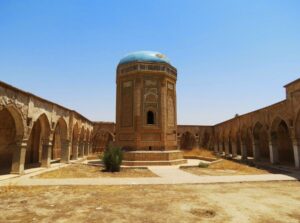
Kirkuk Citadel Park is a peaceful green space located at the base of the citadel. The park features a playground, walking paths, and plenty of benches for relaxing. It is a great place to take a break from the hustle and bustle of the city.
7. Naba Musa Mosque
Naba Musa Mosque is a beautiful mosque that is open to visitors. The mosque’s intricate architecture and decorative details make it a must-see attraction in Kirkuk.
8. Kirkuk Martyrs’ Monument
The Kirkuk Martyrs’ Monument is a somber memorial to the victims of the Iran-Iraq War. The monument features a large sculpture of a soldier and a wall of names commemorating those who lost their lives in the conflict. It is a powerful reminder of the region’s recent history.
The Most Beautiful Destinations In Sulaymaniyah
Sulaymaniyah is a stunning city located in the Kurdistan region of Iraq. It is one of the most historic and culturally rich cities in the Middle East, with a fascinating past and a vibrant present. The city is situated on a plateau in the northeast of Iraq and is surrounded by breathtaking mountain ranges, making it an ideal destination for nature lovers and adventure seekers.
Sulaymaniyah has a long and fascinating history that dates back to ancient times. The city was founded in the 18th century by a Kurdish prince named Sulayman Bey, who established it as the capital of his emirate. Over the centuries, Sulaymaniyah has been a center of trade and commerce, a battleground for numerous conflicts, and a hub of culture and art.

Today, Sulaymaniyah is a bustling city that offers visitors a unique blend of old-world charm and modern amenities. The city is home to numerous museums, galleries, and cultural centers, where visitors can explore the rich history and heritage of the region. The Sulaymaniyah Museum, for example, is a must-see attraction that showcases the history and culture of the Kurdish people, while the Slemani Gallery is a popular destination for art lovers, featuring works by local and international artists.
In addition to its cultural offerings, Sulaymaniyah is also renowned for its stunning natural beauty. The city is surrounded by towering mountains and lush green valleys, making it an ideal destination for hiking, trekking, and outdoor adventures. The Qaiwan Mountain Resort, located just outside the city, is a popular destination for tourists seeking a peaceful retreat in the midst of nature.
Sulaymaniyah is also home to a vibrant culinary scene, with a wide range of restaurants and cafes serving up delicious local and international cuisine. From traditional Kurdish dishes like lamb kebabs and pomegranate stew to international favorites like pizza and sushi, there is something for everyone in Sulaymaniyah.
One of the most beautiful aspects of Sulaymaniyah is its architecture. The city is home to numerous historic buildings and landmarks, many of which date back centuries. The Sulaymaniyah Grand Mosque, for example, is a stunning example of Islamic architecture, featuring intricate carvings and stunning mosaics. The city’s bazaars and markets are also a sight to behold, with colorful stalls selling everything from spices and textiles to handicrafts and jewelry.
Sulaymaniyah has become an increasingly popular tourist destination in recent years, attracting visitors from around the world who come to explore its rich history and culture, enjoy its natural beauty, and savor its delicious cuisine. The city’s tourism industry has also helped to spur economic growth and development, creating new job opportunities and contributing to the region’s overall prosperity.
Sulaymaniyah is a truly special place, with a rich history, stunning natural beauty, vibrant culture, and welcoming people. Whether you’re a history buff, an adventure seeker, a foodie, or simply looking for a peaceful retreat, Sulaymaniyah has something for everyone. So why not plan a visit today and experience the magic of this beautiful city for yourself? Here are the ten most beautiful places to visit when you travel to Sulaymaniyah.
1. Goyje Mountain
Goyje Mountain is a breathtaking natural wonder, located just outside of Sulaymaniyah. With its lush green valleys, flowing streams, and picturesque peaks, it’s an ideal destination for hikers and nature lovers.
2. Amnasuraka Museum
The Amnasuraka Museum is a must-see attraction for anyone interested in the history and culture of Kurdistan. The museum houses a vast collection of artifacts, manuscripts, and documents that date back to ancient times, offering visitors a glimpse into the rich heritage of the region.
3. Sharazoor Plain
The Sharazoor Plain is a vast expanse of grasslands that stretches across the foothills of the Zagros Mountains. It’s an ideal destination for picnics, hiking, and bird watching, with its stunning vistas and diverse wildlife.
4. Azmar Mountain
Azmar Mountain is a natural wonder that offers visitors a chance to explore the great outdoors. With its towering peaks, rolling hills, and sparkling streams, it’s an ideal destination for hiking, camping, and nature photography.
5. Slemani City Park
Slemani City Park is a popular destination for families, offering a range of activities and attractions for visitors of all ages. With its lush green lawns, playgrounds, and outdoor cafes, it’s an ideal place to relax and enjoy the beauty of the city.
6. Chavi Land
Chavi Land is a family-friendly amusement park that offers a range of thrilling rides and attractions. From roller coasters to water slides, there’s something for everyone at Chavi Land.
7. Geli Ali Beg Waterfall
Geli Ali Beg Waterfall is a stunning natural wonder, located in the foothills of the Zagros Mountains. With its crystal-clear pools, rushing streams, and cascading falls, it’s an ideal destination for nature lovers and hikers.
8. Sulaymaniyah Grand Mosque
The Sulaymaniyah Grand Mosque is a stunning architectural masterpiece, featuring intricate tile work, ornate domes, and soaring minarets. It’s a must-see attraction for anyone interested in the Islamic culture and history of the region.
9. Halabja Memorial Monument
The Halabja Memorial Monument is a powerful tribute to the victims of the Halabja chemical attack, which took place in 1988. The monument features a towering sculpture of a mother holding her child, symbolizing the tragic loss of life that occurred during the attack.
10. Sulaymaniyah Bazaar
The Sulaymaniyah Bazaar is a vibrant marketplace that offers visitors a chance to experience the sights, sounds, and smells of Kurdistan. With its colorful stalls, bustling crowds, and exotic wares, it’s an ideal place to shop for souvenirs, sample local cuisine, and soak up the atmosphere of the city.
The Mythical City Of Babylon
Babylon is an ancient city that was once the capital of the mighty Babylonian Empire. It is located in present-day Iraq, approximately 85 kilometers south of Baghdad, and is considered one of the most significant historical and archaeological sites in the world.

The history of Babylon dates back to the 23rd century BC when it was a small city-state ruled by King Hammurabi. However, it wasn’t until the reign of King Nebuchadnezzar II in the 6th century BC that Babylon became a major cultural, religious, and economic center in the ancient world. During this time, the city underwent a massive expansion program, with the construction of monumental structures such as the Hanging Gardens of Babylon, the Ishtar Gate, and the Temple of Marduk.
Babylon’s glory days came to an end in 539 BC when it was conquered by the Persian Empire under Cyrus the Great. Despite several attempts to revive the city, it gradually declined in importance and was eventually abandoned in the 2nd century AD.
Over the centuries, the ruins of Babylon were gradually buried under layers of silt and sand. It wasn’t until the 19th century that European archaeologists began to excavate the site, uncovering a wealth of ancient artifacts, buildings, and inscriptions.
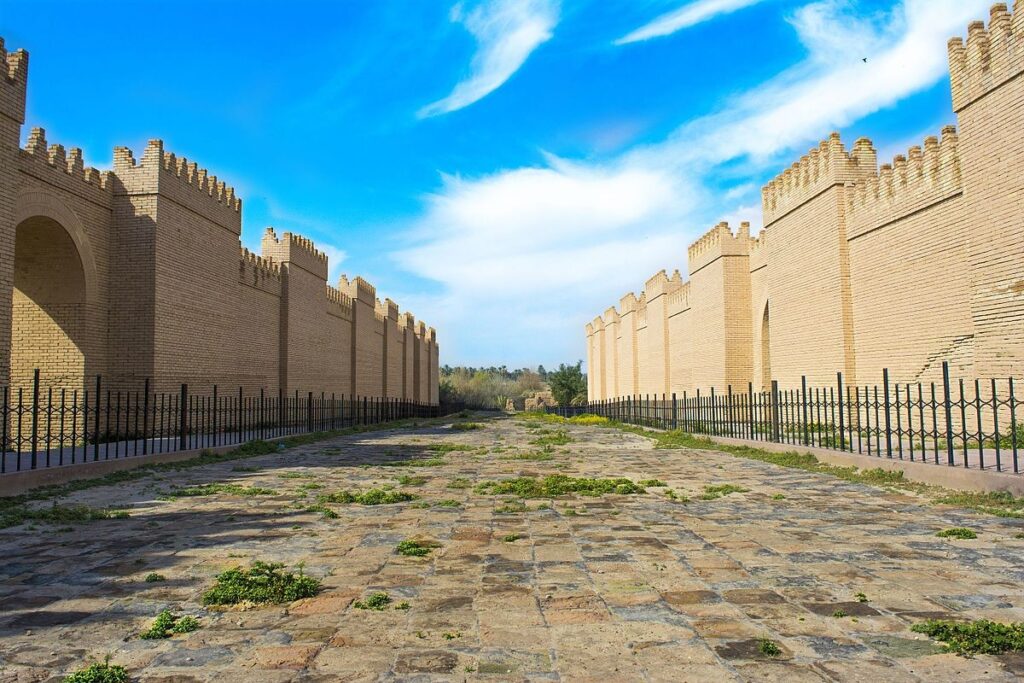
Today, the ruins of Babylon are a UNESCO World Heritage Site, attracting tourists, archaeologists, and history enthusiasts from all over the world. The site includes the remains of the Ishtar Gate, the Temple of Marduk, and the palace of King Nebuchadnezzar II, among other notable structures. Visitors can also see the famous Hanging Gardens of Babylon, which were one of the Seven Wonders of the Ancient World.
Although many of the structures at Babylon are in ruins, the site still provides a fascinating glimpse into the past. Visitors can explore the ancient streets, see the remnants of palaces and temples, and learn about the culture, religion, and daily life of the people who lived in Babylon over 2,500 years ago.
Moreover, a visit to Babylon is not only a chance to experience ancient history but also to witness the modern challenges that the country is facing. Despite its rich cultural heritage, Iraq has been plagued by war, conflict, and instability in recent years. Visiting Babylon can help promote tourism and cultural exchange, supporting local communities and preserving the country’s rich cultural legacy.
Babylon is a unique and fascinating destination that offers a window into the ancient world and the rich cultural heritage of Iraq. Its ruins, monuments, and artifacts are a testament to the power and influence of one of the most significant civilizations in history. Despite the challenges faced by the country, Babylon remains an important site of historical and cultural significance, and a visit is sure to be a memorable and enriching experience.

Iraq Travel Guide: FAQ
Welcome to Iraq, a country that’s steeped in history, culture, and natural beauty. Located in the heart of the Middle East, Iraq is known for its ancient cities, stunning landscapes, and warm hospitality. Despite its turbulent past, Iraq is a safe and welcoming destination for travelers who are seeking an authentic and memorable experience.
In this travel guide, we’ll provide you with all the information you need to plan your trip to Iraq, including visa requirements, safety tips, and recommendations for must-see destinations. So pack your bags and get ready to explore one of the most fascinating countries in the world!
FAQ About Traveling To Iraq
Q: Do I need a visa to enter Iraq?
A: Yes, most travelers require a visa to enter Iraq. You can apply for a visa at the Iraqi embassy or consulate in your home country.
Q: Is it safe to travel to Iraq?
A: While Iraq has experienced some security concerns in the past, the country has made significant progress in recent years in improving safety and security for both locals and tourists. However, it’s important to stay up-to-date on current events and follow local guidelines and advisories as some regions of the countries are still off-limits.
Q: What is the best time of year to visit Iraq?
A: The best time to visit Iraq is in the spring (March to May) or fall (September to November) when the weather is mild and pleasant.
Q: What are some must-see destinations in Iraq?
A: Some of the top destinations in Iraq include the ancient city of Babylon, the Ziggurat of Ur, the Erbil Citadel, the Ahwar Marshes, and the stunning Kurdistan mountains.
Q: What is the currency used in Iraq?
A: The currency used in Iraq is the Iraqi Dinar (IQD).
Q: Can I use credit cards in Iraq?
A: Credit cards are not widely accepted in Iraq, so it’s important to carry cash with you.
Q: Is it safe to drink tap water in Iraq?
A: It’s generally not recommended to drink tap water in Iraq. Instead, drink bottled water or boiled water.
Q: What is the official language spoken in Iraq?
A: The official language of Iraq is Arabic, but Kurdish is also widely spoken in the north.
Q: What is the time zone in Iraq?
A: Iraq is in the Eastern European Time Zone (UTC+3).
Q: What is the voltage in Iraq?
A: The voltage in Iraq is 220V, 50Hz AC.
Q: What is the dress code for women in Iraq?
A: Women should dress modestly in Iraq, covering their arms and legs, and wearing a headscarf when visiting religious sites.
Q: What is the public transportation like in Iraq?
A: Public transportation in Iraq is limited, but taxis and private cars are widely available.
Q: Can I use my mobile phone in Iraq?
A: Yes, international roaming is available in Iraq, but it’s important to check with your mobile service provider for rates and coverage.
Q: What is the tipping etiquette in Iraq?
A: Tipping is not expected in Iraq, but rounding up the bill is appreciated.
Q: Are there any cultural customs I should be aware of when visiting Iraq?
A: It’s important to respect local customs and traditions when visiting Iraq, such as removing your shoes before entering a home or mosque, and not eating or drinking in public during Ramadan.
Q: Is it safe to drive in Iraq?
A: Driving in Iraq can be challenging due to the country’s security situation and poor road conditions. It’s recommended to hire a local driver or take a taxi rather than driving yourself.
Q: Can I bring alcohol into Iraq?
A: No, it’s illegal to bring alcohol into Iraq.
Q: Are there any cultural customs I should be aware of when visiting Iraq?
A: Yes, it’s important to respect the local customs and traditions, including dress codes and religious practices.
Q: What is the best way to get around Iraq?
A: The best way to get around Iraq is by hiring a local driver or taking a taxi, as public transportation can be unreliable and unsafe.
Q: Can I take photos in Iraq?
A: It’s recommended to ask for permission before taking photos of people or religious sites in Iraq.
Q: Are there any restrictions on what I can bring into Iraq?
A: Yes, there are restrictions on what you can bring into Iraq, including firearms, drugs, and pornography.
Q: What should I do in case of an emergency while in Iraq?
A: In case of an emergency, dial 112 for the police or 115 for an ambulance in Iraq. It’s also recommended to have the contact information for your embassy or consulate on hand.
Q: Are there any specific health risks in Iraq that I should be aware of?
A: There is a risk of contracting infectious diseases, such as cholera and hepatitis A and B, in Iraq. It’s recommended to get vaccinated and take necessary precautions to avoid getting sick.
Q: Do I need any specific vaccinations before traveling to Iraq?
A: Yes, it’s recommended to get vaccinated against hepatitis A and B, typhoid, polio, and tetanus before traveling to Iraq.
Q: What medical facilities are available in Iraq?
A: Medical facilities in Iraq may be limited, especially outside of major cities. It’s recommended to have comprehensive travel insurance that includes medical evacuation in case of an emergency.
FAQ About Visa Policy For Iraq:
Q: Who can apply for a visa on arrival in Iraq?
A: Citizens of certain countries are eligible for a visa on arrival in Iraq, including Bahrain, Kuwait, Oman, Qatar, Saudi Arabia, and the United Arab Emirates.
Q: What are the requirements for a visa on arrival in Iraq?
A: To apply for a visa on arrival, you’ll need a valid passport with at least six months remaining, a return ticket, and proof of accommodation. You’ll also need to pay the visa fee in cash.
Q: How long is the visa on arrival for Iraq be valid for?
A: The visa on arrival is valid for 15 days and can be extended for an additional 15 days.
Q: Can I apply for a visa on arrival if I’m not a citizen of the eligible countries?
A: No, if you’re not a citizen of the eligible countries, you’ll need to apply for a visa at the Iraqi embassy or consulate in your home country before your trip.
Q: How long does it take to get a visa from the Iraqi embassy or consulate?
A: The processing time for a visa from the Iraqi embassy or consulate varies depending on the country and the type of visa you’re applying for. It’s important to apply well in advance of your travel dates to allow for sufficient processing time.
Q: What documents do I need to apply for a visa from the Iraqi embassy or consulate?
A: The specific documents required for a visa application vary depending on the country and the type of visa you’re applying for, but typically include a valid passport, a completed visa application form, a passport-sized photo, and proof of travel plans and accommodations.
Q: How much does a visa from the Iraqi embassy or consulate cost?
A: The cost of a visa from the Iraqi embassy or consulate varies depending on the country and the type of visa you’re applying for. It’s important to check with the embassy or consulate for current fees.
Q: Is it possible to apply for a visa online for Iraq?
A: Yes, it’s possible to apply for an e-visa online through the Iraqi government’s visa portal. This is only available for certain types of visas, such as tourism and business visas.
Q: How long does it take to get an e-visa for Iraq?
A: The processing time for an e-visa varies depending on the type of visa and the volume of applications. It’s important to apply well in advance of your travel dates to allow for sufficient processing time.
Q: What documents do I need to apply for an e-visa for Iraq?
A: The specific documents required for an e-visa application vary depending on the type of visa you’re applying for, but typically include a valid passport, a passport-sized photo, and proof of travel plans and accommodations.
Q: How much does an e-visa for Iraq cost?
A: The cost of an e-visa varies depending on the type of visa and the duration of stay. It’s important to check with the Iraqi government’s visa portal for current fees.
Q: Can I extend my visa while I’m in Iraq?
A: Yes, it’s possible to extend your visa while you’re in Iraq by visiting the Iraqi Immigration and Passport Office. It’s important to apply for an extension well in advance of the expiration of your visa.
Q: Can I enter Iraq with a work visa?
A: Yes, it’s possible to enter Iraq with a work visa, but you’ll need to provide additional documentation, such as a letter from your employer and a work permit.
Q: Is it possible to enter Iraq without a visa?
A: No, it’s not possible to enter Iraq without a valid visa or visa on arrival.
Q: Can I enter Iraq if my passport is expiring soon?
A: It’s recommended to have at least six months.
Iraqi Cuisine: Everything You Need To Know!
Iraqi cuisine is rich and diverse, with a long history and a blend of influences from neighboring countries such as Iran, Turkey, and Syria, as well as the ancient Mesopotamian civilization that thrived in the region thousands of years ago. Iraqi cuisine features a variety of flavors, spices, and cooking techniques, and has something to offer for every palate.
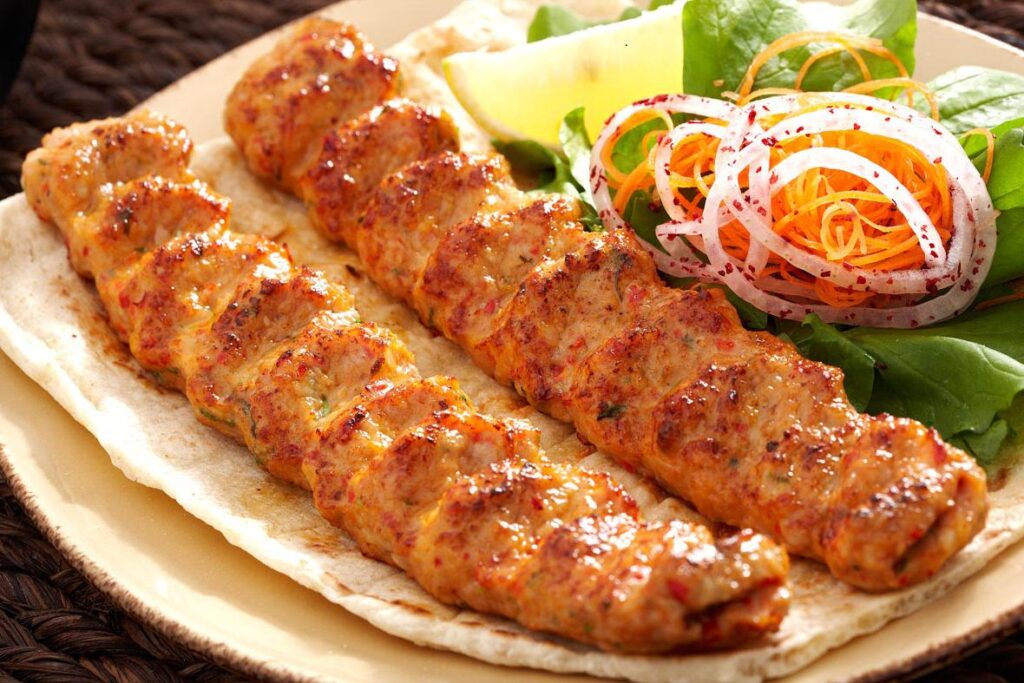
Iraqi Cuisine
One of the most famous dishes in Iraqi cuisine is the national dish, called Masgouf. This dish is made by grilling a large freshwater fish known as shatt al-arab, which is marinated in a special blend of spices and then slow-grilled on a wooden spit until it’s crispy on the outside and juicy on the inside. Masgouf is often served with a side of flatbread and a spicy tomato and onion salad.
Another popular dish is the stuffed vegetable dish called dolma. Dolma can be made with a variety of vegetables such as grape leaves, zucchini, eggplant, and bell peppers, and is typically stuffed with a mixture of rice, meat, and spices. The stuffed vegetables are then cooked in a flavorful tomato and onion sauce, and served as a main course or side dish.
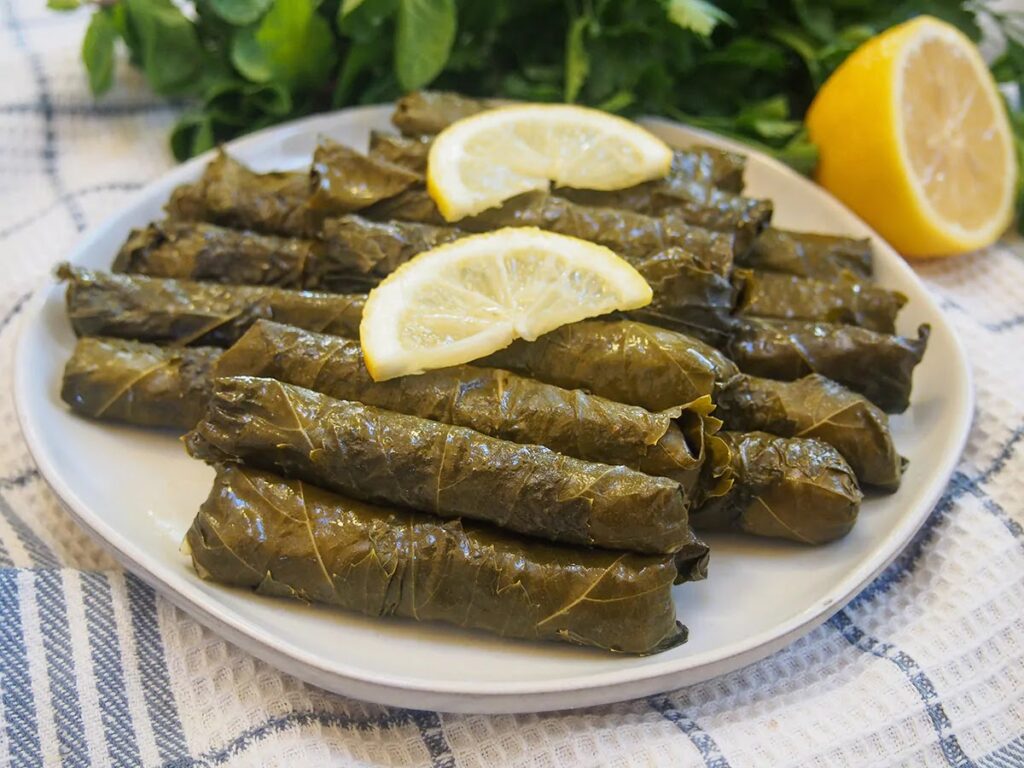
Biryani is another popular dish in Iraq, which is a type of rice dish that is cooked with a variety of spices and typically served with chicken, lamb, or beef. The rice is often flavored with saffron and other aromatic spices such as cinnamon and cardamom, and is usually garnished with nuts and dried fruits.
Tepsi Baytinijan is an eggplant dish that is often served as a main course. The dish features layers of thinly sliced eggplant that are topped with a flavorful tomato and meat sauce, and then baked in the oven until the eggplant is tender and the sauce is bubbly. The dish is often garnished with fresh herbs such as parsley or cilantro, and is usually served with rice or bread.
Bamia is a delicious okra stew that is often made with lamb or beef. The dish features tender okra that is cooked with onions, garlic, tomatoes, and a blend of spices such as cumin, coriander, and paprika. The meat is usually browned first and then added to the stew, and the dish is simmered until the flavors meld together. Bamia is usually served with rice or bread.
Kubbet Mosul is a type of kibbeh that is unique to the city of Mosul in northern Iraq. The dish features a shell of bulgur wheat that is stuffed with a mixture of ground meat, onions, and spices such as cinnamon and allspice. The kibbeh is then fried until it’s crispy on the outside and tender on the inside, and is usually served with a side of yogurt or a salad.
Another popular dish is Tashreeb, which is a traditional Iraqi stew made with lamb or chicken, vegetables, and chunks of bread that soak up the flavorful broth. The dish is typically served in a large communal dish, with everyone using pieces of bread to scoop up the stew.
Iraqi cuisine also features a variety of vegetarian dishes, such as fasolia, a stew made with kidney beans and tomatoes, and kubba, a type of dumpling filled with spiced ground meat, or vegetables such as spinach or pumpkin.
Iraqi desserts are also worth trying, such as the famous sweet pastry known as baklava, which is made with layers of phyllo pastry and sweetened nuts. Other popular desserts include qatayef, a sweet dumpling filled with nuts and syrup, and halva, a sweet confection made from sesame seeds and sugar.
Iraqi cuisine also features a variety of street foods, such as falafel, a deep-fried patty made from chickpeas, fava beans, or a combination of both, and served in a pita bread with vegetables and sauces. Another popular street food is samosa, a deep-fried pastry filled with spiced potatoes, meat, or vegetables.
In recent years, Iraqi cuisine has also seen a rise in popularity outside of Iraq, with many restaurants and food trucks around the world offering traditional Iraqi dishes. Iraqi cuisine is truly a treasure trove of flavors and textures, and is definitely worth exploring for anyone who loves food.
Popular Beverages In Iraq
Beverages are an important part of the culinary culture of Iraq. Iraqi people enjoy a variety of hot and cold drinks that are often served with meals or as a refreshing treat on a hot day.
Tea is one of the most popular beverages in Iraq, and it’s typically served hot and sweetened with sugar. Iraqi tea is usually made with black tea leaves and is brewed with a blend of spices such as cardamom, cinnamon, and cloves, giving it a warm and comforting flavor.
Another popular hot beverage in Iraq is qishr, a type of coffee made from the husks of coffee beans. The husks are boiled with water and spices such as cinnamon and ginger, and then sweetened with sugar. Qishr has a unique flavor that’s slightly tart and fruity, and it’s often served in small glasses with dates or other sweet treats.
When it comes to cold drinks, one of the most popular in Iraq is sharbat, a sweet and refreshing fruit juice made from fresh fruits such as pomegranate, apricot, or tamarind. Sharbat is often served with ice and garnished with fresh herbs such as mint or basil.
Ayran is another popular beverage in Iraq, particularly during the hot summer months. Ayran is a traditional yogurt-based drink that’s similar to a lassi. It’s made by mixing yogurt with water and salt, and then whisking the mixture until it’s frothy. Ayran is tangy and refreshing, and it’s often served with grilled meats or other savory dishes.
Iraq is also known for its date juice, which is made from the sap of date palms. The juice is extracted by making a small incision in the tree trunk, and then collecting the sap in a container. The juice is sweet and slightly caramel-like in flavor, and it’s often sold by street vendors in small cups.
In addition to these traditional beverages, Iraq also has a thriving coffee culture, with many coffee shops serving a variety of espresso-based drinks and other coffee specialties. Whether you prefer hot or cold, sweet or tangy, there’s a beverage to suit every taste in Iraq.
Alcohol In Iraq
In Iraq, alcohol consumption is strictly prohibited for Muslims due to the country’s Islamic law. As a result, there is a very limited market for alcoholic beverages in Iraq, and it’s difficult to find places that sell or serve alcohol.
There are a few places in Iraq that cater to foreigners, such as hotels and restaurants, where alcohol may be available for purchase. However, these establishments often require a special permit to serve alcohol and may charge a premium price for it.
Ofcourse alcohol is consumed locally and hidden from the law. One of the most popular is arak, a type of anise-flavored liquor that’s commonly consumed in Iraq and other Middle Eastern countries. Arak is made from distilled grapes or dates and is typically served with water, which causes it to turn cloudy and milky in appearance.
Another traditional alcoholic beverage in Iraq is date wine, which is made by fermenting fresh dates with water and yeast. Date wine is usually sweet and has a rich, fruity flavor that’s similar to sherry or port.
Iraq: Everything You Need To Know
Introduction
The Republic of Iraq is a country in the Middle East. Iraq borders Kuwait, Saudi Arabia, Jordan, Syria, Turkey, Iran and the Persian Gulf and includes most of Mesopotamia, located between the Euphrates and Tigris, where the earliest advanced civilizations of the Near East emerged, as well as parts of the adjacent desert and mountain regions. He is counted among the Mashrek states. The north of the country is formed by the autonomous region of Kurdistan, which has its own parliament and armed forces (Peshmerga).
With around 41 million inhabitants (as of 2020), Iraq is one of the five largest countries in the Arab world. Its capital and largest city is the metropolis Baghdad, other cities with over a million inhabitants are Basra, Mosul, Erbil, Sulaymaniyah, Najaf, Kirkuk and Karbala. Rapid urbanization took place in the country as a result of the refugee movements in the 20th and 21st centuries. Iraq is the world’s fourth most resourceful country, and its economy is mainly based on oil exports and, to a lesser extent, on agriculture.
Today’s Iraq was created in 1920 from the three Ottoman provinces of Baghdad, Mosul and Basra. The Kingdom of Iraq existed from 1921 to 1958. In 1958 the king was overthrown by a military coup and the republic was proclaimed. From 1979 to 2003 the country was ruled by Saddam Hussein and the country waged wars against the neighboring states of Iran and Kuwait. A multinational invasion force (“coalition of the willing”) led by the United States overthrew Saddam Hussein’s regime in 2003 without establishing stable structures for the post-war era.
After the declared end of the war, during the occupation of Iraq from 2003 to 2011, there were conditions similar to civil war, thousands of terrorist attacks, acts of war and violent crime, both by various Iraqi groups against each other and against the Western occupying forces. They claimed an unknown number of lives and injuries, especially among Iraqi civilians. From December 2013 there was a war between Iraq and the Islamists of ISIS, who conquered parts of the national territory. In December 2017, the Iraqi government announced that Iraqi forces had taken full control of the Syrian-Iraqi border and the war against ISIS was over.
The country has also been considered unstable since the end of the fighting, with nationwide protests starting in October 2019.
Geography
Iraq belongs to the Orient. The countries of North Africa and Southwest Asia are usually counted as part of the Oriental culture. They are mainly located in the subtropical dry belt of the “Old World”.
In the north-east there is an approximately 3000 m high mountain range from the foothills of the Taurus Mountains and Zagros. This chain is part of the Alpidian mountain system, which extends from the Balkan Mountains eastward into Turkey, northern Iraq and Iran, and then on to Afghanistan. The highest mountain in Iraq is Cheekha Dar at 3611 m.
Iraq borders Iran, Kuwait, Saudi Arabia, Jordan, Syria and Turkey. With the exception of the border with Iran, which formed the eastern border of the Ottoman Empire until 1918, Iraq’s border was determined by the colonial powers. The neutral zone between Saudi Arabia and Iraq was divided between both countries in 1975–1983. In addition, Iraq has a 58.3 km long coastline. The north of the country is formed by the Autonomous Region of Kurdistan, which has established a de facto border within the country.
Climate Of Iraq
The north of Iraq, up to about the geographical latitude of Baghdad, lies in the so-called westerly wind zone of moderate latitudes in winter and under the influence of high pressure in summer with temperatures between −6 °C in winter and 51 °C in midsummer (annual mean 22 ° C). The area south of Baghdad, on the other hand, belongs to the subtropical high-pressure belt all year round. The summers are rainless throughout the country and, with the exception of the mountainous regions, are quite warm with average temperatures around 33 to 34 °C. Occasionally strong, year-round winds from the northwest mean that the cities of Baghdad and Basra, for example, are hit by dust storms on around 20 and 15 days a year, respectively.
Temperatures range from 50°C in summer to around zero in January. Frost is possible, especially in mountainous areas. Rain falls about 10 to 18 cm a year, the main rainy months are December to April. The areas bordering the gulf are slightly wetter.
Rivers And Lakes In Iraq
Iraq is crossed by two major rivers, the Euphrates and the Tigris. This was reflected in the geographical designation Mesopotamia, which translated means “(land) between the two rivers”. The Euphrates and Tigris come from the north-west from Syria and Turkey respectively and cross the country to the south-east. The Tigris and Euphrates meet at al-Qurna in southern Iraq. There they form the 193-kilometer-long Schatt al-Arab/Arvandrud, which flows into the Persian Gulf. The Euphrates and Tigris have always been the country’s lifelines, as they provide water for much of Iraq’s agriculture and population. In the south-east of the country, the Faw Peninsula juts out into the Persian Gulf between Iran and Kuwait, making it Iraq’s only access to the sea.
West of Baghdad there are three sinks into which water from the Euphrates and Tigris can be diverted during floods: Lake Tharthar, Lake al-Habbaniyah and Lake Razzaza.
The swamp areas in southern Iraq, the so-called Ahwar, were systematically drained during the first Gulf War in the 1980s. With international help, the Iraqi government has been trying to irrigate these areas again since 2003.
Flora And Fauna Of Iraq
Since there are different precipitation conditions in Iraq, there are also different types of vegetation. In northern Iraq there is shrub vegetation and isolated forest stands. On the banks of the Euphrates and Tigris there are date palms and reed belts. The south, on the other hand, is only sparsely overgrown. Government projects to turn the desert areas into fertile soil were abandoned in the 1980s.
Various bird species such as vultures, buzzards, ravens and owls are native to Iraq, as well as mammals such as caracal, hyena, jackal, gazelle and antelope in Iraq. There is also a great abundance of fish on the Tigris, Euphrates and Schatt al-Arab. Up until the early 19th century, there were lions and ostriches in Iraq.
Population
In 1900 there were 2 million Iraqis. In 2010, the country had a population of 30.4 million. In 2019, the population has grown to approximately 40 million inhabitants. The Iraqi population is relatively young, with about 38% of the population being under the age of 20 and only 5% of the population being over the age of 65. About two-thirds of the population live in cities. Baghdad is by far the largest city in the country with 7.5 million inhabitants.
About 75-80% of the population living in Iraq today are Arabs, 15-20% are Kurds and 5% are Turkomans, about 600,000 Assyrians/Arameans (about 1.4 million around 2003), about 10,000 Armenians (before the fighting 35,000 ) or members of other ethnic groups. Furthermore, 20,000 to 50,000 Marsh Arabs are said to live in the southeast. Turkoman sources estimate the proportion of their own ethnic group to be around 10%
Arabs live in the center and south of the country. Most of them, about 60% of the total population, are followers of Shiism, a branch of Islam considered to be followers of the Imam Ali. The Shiite population of Iraq mainly lives in the south of the country, where the holy cities of the Shiites are: Karbala and Najaf. In addition, since the fall of the dictatorship led by Saddam Hussein, large groups of Shiites have also lived in Baghdad, largely in the Sadr City district (formerly Saddam City). The Swamp Arabs live in the area of Shatt al-Arab.
Most of the Sunni Arabs live in the so-called Sunni triangle, who make up about 20% of the population.
The Kurdish population of Iraq lives in the autonomous North of Iraq, which is also referred to as the Iraqi Kurdistan. The Kurds have a certain degree of autonomy, or self-government. The Kurds have their own language, Kurdish, and a more or less separate culture. About 5 million Kurds live in Iraqi-Kurdistan, with its capital in Arbil. They also hoist their own flag (albeit with the Iraqi flag next to it). Christians, Arabs and Turkomans also live in the Kurdish region. However, due to the Second Gulf War and Islamist terror, the number of Christians has fallen sharply in recent years due to a large emigration wave of this group of Iraqis.
Iraqi Turkomans live mainly in Kirkuk and to a lesser extent also in Baghdad and Erbil.
Religion In Iraq
About 97% of the population is Muslim. Over 60% are Shia and between 32 and 37% Sunni; the vast majority of Muslim Kurds are Sunni. At around 3%, Christians, Yazidis and other religions form a minority compared to around 25% 100 years ago. Almost 2 million Christians have fled in recent years. The Christians belong predominantly to the Oriental Christian communities: Chaldean Catholic Church, Assyrian Church of the East, Ancient Church of the East, Armenian Apostolic Church, Roman Catholic Church, Syriac Catholic Church, Syrian Orthodox Church of Antioch, Assyrian Evangelical church and others.
By 1948 there were still 150,000 Jews living in Iraq. Due to flight and expulsion in the 1940s as a result of the founding of the state of Israel, the number of Jews living in Iraq fell sharply and is currently estimated at less than 10 people. There are also Yazidis, Shabak and a few thousand Mandaeans. Recently there are growing Zoroastrian communities in the Kurdish part of Iraq, especially in Sulaymaniyah.
Under Saddam Hussein’s regime, the religious freedom of the various population groups was relatively high; the government of the dictator included e.g. For example, the Christian Assyrian/Aramean Tariq Aziz or, for a short time, the Kurdish general Mustafa Aziz Mahmoud appeared as ministers. However, since the war began in March 2003, an estimated half of Iraq’s Christians have left the country.
Refugees And Displaced Persons
Already at the time of Saddam Hussein, many Iraqis were leaving the country. By the end of 2002, around 400,000 refugees were already registered worldwide. Due to the unstable situation in the country, another 1.8 million people have left Iraq since 2003. At the height of the violence in 2006 and 2007, up to 3,000 people crossed the borders with Syria, Iran and Jordan every day. There are also over 1.6 million internally displaced persons.
Biggest Cities In Iraq
The capital, Baghdad, is the geographical, political and cultural center of the country and, with 5.7 million inhabitants, is by far the largest urban agglomeration. Baghdad (Persian = gift of God) was founded in 762 by the Abbasid Caliph al-Mansur as the new capital of the Islamic Empire and in 1920 it was declared the capital of the newly founded state of Iraq. The city was expanded particularly during the economic boom of the 1970s. The city was hardly affected during the First Gulf War, but Baghdad was repeatedly the target of air raids in the Second and Third Gulf Wars. Baghdad is home to 3 of the country’s 6 universities and Iraq’s largest international airport.
In the north, Mosul is in second place with about 2.9 million inhabitants. It is the center of Eastern Christian and Assyrian culture in Iraq. Mosul had been an important economic center since the 8th century, and it was not until 1926 that the entire province of Nineveh was annexed to Iraq under international law.
With around 2 million inhabitants, the port city of Basra on the Persian Gulf is the third largest city in the country and the center of the Shiite south. Basra was founded by Caliph Umar ibn al-Chattab in 636 as an Arab military base and trading post and was conquered by the Ottomans in the 16th century. In 1914 British troops marched into the city. During the First Gulf War, the city was badly affected due to its exposed location and economic importance. Basra has the country’s largest transhipment port, through which large parts of the oil produced are exported, as well as the university founded in 1964 and an international airport.
Erbil is the capital of the Kurdistan Autonomous Region and, estimated to be 7000 years old, one of the oldest inhabited cities in the world. With around 1.8 million inhabitants, it is the largest Kurdish city in northern Iraq and the fourth largest city in the country. The city was only slightly damaged in the first two Gulf Wars. Erbil has an international airport.
Sulaymaniyah (Kurdish: Silêmanî) with 1.6 million inhabitants is the fifth largest city in the country. The city has an international airport, a university and is considered the cultural and educational center of Kurdistan.
Traffic In Iraq
The Iraqi road network covers 45,550 km, of which 38,400 are paved. Sections of interurban roads and roads in urban centers (where there is no public transport apart from private bus lines/shared taxis) have multiple lanes, otherwise even major interurban roads have two lanes. Exceptions are the motorways currently under construction and some of which have been completed in the Kurdish north, as well as the Basra-Baghdad-Jordan road, which has long stretches similar to a motorway. The number of registered cars is currently exploding, mainly due to the sharp rise in income and the absence of import duties, which is causing problems in the Arab metropolitan areas in particular, since the precarious security situation means that there is not enough investment in the expansion of the road network. As a result, there are many fatal accidents on the road.
Rail Transport In Iraq
The Iraqi rail network consists of three main lines converging in Baghdad and covers 2339 km. A large part of the rail network, which is in a catastrophic condition (of the Baghdad-Erbil route, for example, often only the route can be seen, the sleepers have been processed into firewood and the rails have been sold) is currently out of service, in fact only the Baghdad-Basra line in operation. However, the train is only used by low-income people, since the reliability is so low that arrival times are not even given. A journey of more than one day to the southern Iraqi metropolis, about 550 km away, is not unusual. However, the new Iraqi government is investing heavily in reconstruction, and it is hoped that regular rail operations will resume in the near future.
The Mosul-Gaziantep route was opened in mid-February 2010. The 18-hour journey leads through Syria and takes place once a week. However, operations were discontinued after a short time.
Airports In Iraq
There are over 100 airports and airstrips in Iraq, the country also has six international airports (Baghdad, Erbil, Basra, Mosul, Najaf and Sulaymaniyah), and Karbala Airport is currently under construction. Another airport in Tikrit is being planned. The largest airline is the state-owned Iraqi Airways.
Fluvial Transport In Iraq
Inland shipping, which was once important, is possible on 1015 km of canals and rivers, but today it only plays a subordinate role. The lower reaches of the Shatt al-Arab river connects the port city of Basra to the Persian Gulf and provides Iraq with a navigable connection to the Indian Ocean and worldwide seafaring.
Electricity In Iraq
In the years after 2003, the country’s electricity production could not keep up with the increasing demand, which is why there are still frequent power cuts. In the summer of 2012, with a consumption of 15,000 megawatts, only 7200 megawatts could be produced. The supply was therefore an average of 8-9 hours. Most Iraqis are therefore still dependent on emergency generators. The poor supply situation led to protests in Nasiriyah and Basra, in which one person was killed. As a result, the Iraqi Electricity Minister resigned on June 22, 2010.
Education In Iraq
At 79.7%, the level of literacy among the population is far below the world average. 85.7% of all men can read and write, among women it is only 73.7%. The situation has deteriorated sharply in the last 30 years – at the end of the 1980s, the proportion of illiterates was only 10 to 12%.
The pre-school (in Iraq mostly state-run, but in recent years more and more fee-based private pre-schools have been founded) can be attended in the age group between four and five years. Compulsory schooling for nine years has been in force in Iraq since 1970, with the state taking over school and university education. State-recognized private schools were only approved in the early 1990s.
Primary school education lasts six years, with the first four grades being considered the lower level and grades 5 and 6 being the intermediate level. English is taught from the 5th grade. Primary school is followed by secondary school for a further three years. Secondary school is completed after a standardized final exam and the acquisition of the secondary school leaving certificate. Attending middle school is necessary to obtain the Abitur; this again three-year type of school concludes with a central Abitur examination in six school subjects (Arabic, English, mathematics, physics, chemistry and biology) and entitles you to study.
The country’s three largest universities (Baghdad University, al-Mustansir Iyya University and the Baghdad Technical University, also known as al-Hikma) are represented in the capital Baghdad. Other universities are located in Basra (Basra University), Mosul (Mosul University), Erbil (Salahaddin University, University of Kurdistan Hawler), Sulaimaniyah (University of Sulaimani) and Dohuk (University of Duhok).
Culture In Iraq
Iraq can be categorized into five geographic cultures: the Kurdish and Turkmen cultures with their centers in Erbil and Sulaymaniyah, the Sunni culture with its center around Baghdad and the Shia culture with its center in Basra, the culture of the sedentary Arabs, the Assyrian culture Culture present in several northern cities and the culture of the nomadic Marsh Arabs living in the swamps between Baghdad and Basra.
Movie Industry In Iraq
Films had been shown in Baghdad since 1909, most of them aimed at British audiences. A film industry only began to develop in the 1940s under the rule of King Faisal II, when French and British film companies settled in Baghdad. In 1955, the film Haidar Al-Omar’s Fitna wa Hassan, an adaptation of the Romeo and Juliet story, was released in cinemas and the film was also registered abroad. After the 1958 coup, the Cinema and Theater General Organization was formed, coordinating and planning future films in the interest of the state. This is how mainly documentaries were shot. After 1979, the Iraqi film industry faced its greatest crisis due to resource shortages caused by the Iraqi-Iranian War. Nevertheless, in 1980 the 6 hour epic about the life of Saddam Hussein was completed. The film industry suffered another blow after the Kuwait War, when an embargo was imposed on the country.
Since the US invasion of the country in 2003, the industry has been slowly trying to regenerate and there are isolated film projects such as Kilomètre zéro. There are also numerous foreign films that have Iraq as their theme, such as Retour à Babylone by Iraqi director Abbas Fahdel or Valley of the Wolves – Iraq.
Theatre In Iraq
From the 1880s, theater companies traveled from Europe to Iraq to play in schools and community halls, primarily for British audiences. In the 20th century, Iraqi writers began writing plays. The big theaters are the Rasheed, the Mansour and the Volkstheater. Plays by Iraqi, Indian and Turkish authors are performed, as are the great dramas of world literature.
Music In Iraq
The oud (short-necked lute) and the rabab (stringed instrument) dominate Iraqi music. Well-known musicians on these instruments include Munir Bashir (1928-1997), Ahmed Mukhtar (* 1967) and Nasir Schamma (* 1963). The country’s most successful pop singer is Kaẓim al-Saher (* 1961), who has sold more than 30 million records in his career so far. Also known are the singers Shatha Hassoun – who took part and won in the fourth season of the most well-known Arabic music casting show “Star Academy” – and Dalli Hadad, as well as the singer Majid Al Muhandis.
Sports In Iraq
The country’s most popular sport is soccer. The national football league is very popular. Important football clubs are al-Zawraa, al-Talaba, al-Shorta, al-Quwa al-Jawiya (all from Baghdad), al-Minaa (Basra) and Erbil SC. The country’s largest football stadium is the al-Shaab Stadium in Baghdad, built in 1966 with a capacity of 66,000 spectators. A sports complex with a main stadium for 65,000 spectators and another stadium for 10,000 spectators was completed in Basra in 2013.
The Iraqi national team has won several regional titles. Her greatest successes were qualifying for the 1986 World Cup in Mexico and winning the Asian Cup in 2007. Another success was fourth place at the 2004 Olympic Games. The Iraqi Football Association is called al-Ittihad al-ʿiraqi li-kurat al -qadam, English Iraq Football Association, IFA.
Other sports such as weightlifting, martial arts, basketball and swimming are also popular. At the 1960 Summer Olympics in Rome, weightlifter Abdu l-Wahid Aziz won the bronze medal in the lightweight division, the country’s only Olympic medal to date.
Cuisine Of Iraq
Iraqi cuisine is the national cuisine of Iraq. However, it is not homogeneous, but consists of two different regional cuisines in the north and south of the country. Wheat and stone fruit are grown in the relatively humid north (ancient Assyria), rice and dates in the dry south (ancient Babylonia). The Kurds, who make up most of the north, share northern cuisine.
Northern Iraqi cuisine largely corresponds to that of neighboring Syria, while southern Iraqi cuisine is more independent and is mainly based on rice, fish and dates. Cereals generally play an important role as a staple food, often combined with meat. Commonly eaten are various porridges with meat, bread with meat, and a dish of grain and meat called kubba. In spring, when it is in bloom, people often eat “yaprax” (pronounced yaprach), boiled vine leaves stuffed with rice, as this is when the vine leaves are particularly good for cooking. The grain porridge known throughout the region, Harissa, is widespread. Popular in the Mosul area is kashki, a porridge with meat flavored with dried lime and cumin, colored with tomato juice or turmeric. It is eaten at the usual family picnics on certain occasions near the tomb of Qadib al-Ban, who is venerated as a saint.
Dishes made from broth and meat mixed with bread are called tharid or taschrib in Arabic. In Baghdad, tharid involves crumbled bread into the broth, while tashrib is eaten for breakfast and consists of whole pieces of bread soaked in broth and then topped with meat. In Mosul, there is a more refined variant called tashgiba, where other ingredients such as lentils, noodles and pomegranate are added.
Kibbeh is a Middle Eastern grain and meat dish called kubba in Iraq. The ingredients are crushed, mixed together and formed into a kind of dumplings. In Mosul there is a different variant, which is a flat patty filled with meat, almonds, raisins and spices and is either baked or boiled in hot water. In the south, rice replaces the bulgur that is common in the north, and fat from the fat-tailed sheep is sometimes used instead of meat.
An Iraqi specialty is a bread in which chopped fried meat is added to the dough before baking, and spices are added. Depending on the dialect, it is referred to as uruq or ghug. There are also fermented wheat dishes. For tarchina, bulgur and yoghurt are mixed and dried. Another is Kaschk, made from boiled and leavened bulgur.
While bulgur is considered a simple cuisine food, rice has a much higher status in Iraq. A folk tale from Mosul says that in paradise you eat apricots with rice, but in hell you eat bulgur with tomatoes.
In Iraq, meat cooked on a skewer is not called a kebab, but a tikka. Here kabab are minced meat skewers, which are called chelo kabab in Persian and are prepared similarly in different countries. The preferred type of meat is lamb or beef. Fish also plays an important role in the kitchen. The fish dish Samak masquf is sometimes referred to as the national dish. It is made from barbel grilled on sticks over an open fire and finished cooking on the ashes. Some dishes have been adopted from Persian cuisine, such as fisinjan, wild fowl cooked with walnuts and pomegranates, while others are originally from Turkish cuisine, such as the sweet pastry baklava.
History Of Iraq
The history of Iraq covers the developments on the territory of the Republic of Iraq from prehistory to the present. Iraq was formed in 1920/21 from the three Ottoman provinces of Baghdad, Mosul and Basra. Iraq’s roots go back to the early advanced civilizations that existed in the 4th millennium BC. arose, back.
Since the 2003 Iraq war that ended the Saddam Hussein era, Iraq has been under military occupation by troops from a US-led international coalition. In 2009 the occupying forces left the cities and in 2011 they withdrew completely.
Ancient Mesopotamia
Iraq lies on the territory of ancient Mesopotamia (Ben al Naharain or Aram-Naharaim). There emerged from the 4th millennium BC. BC some of the earliest civilizations of mankind (Sumer, Akkad, Babylonia, Mittani, Assyria, Media), which is why the region is now seen by many as the cradle of civilization.
Ancient Mesopotamia fell in 539 BC. in the subjugation of Babylonia to the aspiring Persian Empire under Cyrus. Under the Achaemenids, Mesopotamia was temporarily divided into the two satrapies of Syria and Assyria; after the conquest by Alexander the Great after the Battle of Gaugamela in 331 BC. Both satrapies were merged into a new satrapy of Mesopotamia. After the Battle of Gaza in 312 B.C. Mesopotamia came under the control of the Seleucid Empire and was largely spared from further hostilities for almost two centuries. Not least, the foundations of Hellenistic cities flourished during this period (e.g. Apameia, Dura Europos, Edessa, Seleucia).
After the death of the Seleucid king Antiochus Sidetes in 129 BC. Mesopotamia finally fell to the Parthians, who had previously conquered Iran. Ctesiphon became the Parthian capital, and Hatra also acquired special importance. Parts of Mesopotamia were conquered between 83 and 69 BC. BC to Armenia, but were returned to the Parthians in the course of the Roman-Parthian unification after the battle of Carrhae. In the period that followed, the Euphrates stabilized as the border between the Roman and Parthian spheres of influence. Attempts by the Roman Emperor Trajan to annex Mesopotamia between 114 and 117 AD failed, but after Lucius Verus’ Parthian War from 162 to 165, larger parts of Mesopotamia remained in the Roman sphere of influence. In 195 Mesopotamia fell back to the Parthians except for the strategically important city of Nisibis, but was reconquered and fortified by Emperor Septimius Severus in 197.
The change from decentralized feudal Parthian rule to the more centralized Sassanid Empire initially did not bring about any fundamental changes. In the second half of the 3rd century, Mesopotamia fell into the maelstrom of the 3rd century imperial crisis and was under alternating Roman and Sasanian control. Throughout Late Antiquity, Mesopotamia was the deployment and battlefield of these two ancient great powers (see also Roman-Persian Wars), with the Arab tribe of the Lakhmids taking on an important part in securing the borders of Persia. In 297/298, the Roman Emperor Diocletian succeeded in restoring the old ownership structure. From 337, the Sassanid Great King Shapur II began to reconquer large parts of Mesopotamia. Emperor Julian’s failed campaign in Persia eventually led to the loss of almost all of Mesopotamia, and in particular Nisibis, to Persia in 363. Despite various attempts by both sides to move the border, it remained essentially unchanged until finally Mesopotamia and Syria were conquered by the Arabs in the course of the Islamic expansion between 633 and 640.
Arab-Islamic Rule
After the Battle of Kadesia in 636, the Arab Muslims seized the area. In 636, Caliph Umar founded Basra as an army camp. Iraq became an important cultural center of the spreading Islam. It first assumed the role of a political center for the Muslims when ʿAli ibn Abi Tālib moved his capital to Kufa after his elevation to the fourth caliph. After ʿAli’s assassination by a Kharijite in 661, the Umayyad Muawiya I annexed Iraq. From 665 the region was ruled by the governors Ziyād ibn Abī Sufyān and his son ʿUbaidallāh ibn Ziyād, who acted with a heavy hand against the Kharijites and the followers of ʿAli. ‘Ali’s son Hussein, who rebelled against the Umayyad caliphs Yazid I in 680, fell in battle at Karbala. From 694 to 714, the governor al-Hajjaj ibn Yusuf, known for his cruelty, ruled over Iraq. He decided in 702 to replace Persian with Arabic as the official language.
Baghdad was founded by Al-Mansur in 762 as the capital of the Abbasid Caliphate and soon developed into the most important city in the Islamic world. The period that followed is also referred to as the heyday of Islam, in which science and the arts in particular developed to a significantly higher level than in Europe, for example.
From 1055 the Seljuk leader Tughrul Beg conquered the country, in 1258 the Mongolian king Hülegü, founder of the Ilchane dynasty. Aside from the massive devastation in the cities, agriculture, the backbone of the economy, was also destroyed. The heavy fighting between the Mongols and the Mamluks, who were advancing to defend themselves, caused extensive damage to the complex irrigation system in Mesopotamia. The human losses had an equally strong effect here: the oral knowledge about the use and maintenance of the irrigation systems was lost. As a result, the province fell into disrepair because without an irrigation system, Mesopotamian agriculture could no longer develop its full potential. In 1401 Baghdad was devastated by Timur, in 1534 the country fell to the Ottoman Empire.
Iraq as part of the Ottoman Empire
Iraq was important to the Ottoman Empire primarily as a link to the Persian Gulf and as a defensive barrier against Iran (Persia); the Ottomans, on the other hand, were hardly interested in economic development. In the first few centuries in particular, their administration was largely limited to collecting taxes and the (forced) recruitment of soldiers. Iraq was a comparatively insignificant province of the Ottoman Empire, governed by officials (in part, Baghdad, Mosul, and Basra were effectively self-governing).
The Shia population was barred from administrative and military posts under the Sunni Ottomans. However, the Shia clergy ran their own religious schools and collected taxes from their followers.
There were administrative reforms in the early 19th century, but the first major changes came with Midhat Pasha (governor of Baghdad between 1869 and 1872). The first hospitals were built, the first newspapers appeared, and factories began to operate. But his reign was too short to give Iraq a long-term upswing. The first evidence of British interest in Iraq also came at this time. In 1860, the British Lynch Company acquired the monopoly for shipping on the Tigris. Iraq remained an insignificant sideshow until the First World War, but its geostrategic position at the crossroads between Europe, British India, Central Asia, the Caucasus and South Arabia was to make it an object of global political interest from World War I onwards.
British rule and kingdom
During World War I (on November 6, 1914, the day after war was declared on the Ottoman Empire), British troops and Arab insurgents invaded together and occupied Baghdad in 1917. The actual immediate target was only the region around Basra, because the Royal Navy was dependent on oil supplies from neighboring Iran. In 1920, Great Britain detached the provinces of Vilayet Baghdad, Vilayet Mosul and Vilayet Basra from the former Ottoman Empire and merged them into today’s Iraq. The province of Mosul was initially not included in the planning because it was in the French sphere of influence; however, following Russia’s default on the Sykes-Picot Agreement and due to strategic considerations, it was also incorporated, promising Turkey and France each 20% of the expected profits from oil production in that region.
Gertrude Bell, as an adviser to Colonial Secretary Winston Churchill, was instrumental in defining today’s borders. The League of Nations sanctioned this measure and gave Great Britain the mandate over Iraq. This is how the British Mandate of Mesopotamia was established. Promised by Britain of a sovereign Greater Arabia should the Arabs rise up against the Ottoman Empire, they did not accept British Mandate status and began an uprising against the British Crown in 1920. But the uprising also had a social background. To get the land under their control, the British did what they did on their Indian north-west border: they made local authorities, to whom they gave a number of privileges (e.g. tax exemption) and to whom the formerly communal land was also given, so that many farmers became impoverished. According to British estimates, 8,450 Iraqis and 1,654 British soldiers died in the three-month revolt. The high cost of blood and the cost of putting down the rebellion (altogether six times the total cost of the British military campaign in the Middle East) frightened the British government. To lower the cost of the British presence while discouraging Arab rebellion, the British government installed an Arab king.
On August 23, 1921, Faisal, son of Sherif Hussein of Mecca, was proclaimed king. The Kingdom of Iraq was accepted into the League of Nations on October 3, 1932. Even after the founding of the state, there were no uniform measures or weights and no uniform currency; Indian, Iranian and Turkish money were used in parallel according to the different orientations of the provinces. The main oil activities in the country were combined in the Iraq Petroleum Company, which emerged from the Turkish Petroleum Company in 1929, which paid only small concession fees and was wholly owned by foreign companies.
The Anglo-Iraqi Treaty of June 1930 secured numerous rights for the British and granted them military bases. When the Second World War broke out, the Iraqi government under Nuri as-Said broke off diplomatic relations with Germany and adopted a pro-British stance on foreign policy that had no support in army circles and broad sections of the population. On April 1, 1941, anti-British politicians and officers staged a coup d’état to end the government’s pro-British policies. The army brought Rashid Ali al-Gailani to power, who proclaimed Iraq’s neutrality and demanded the withdrawal of all British soldiers. Military clashes between British and Iraqi troops began on May 2, 1941, lasted a month and ended in Iraqi defeat. During this fighting, the Iraqi government sent a request for help to Germany, which brought only minor military support (Sonderstab F). In October 1941 Nuri as-Said took over the government again. The contractually secured political, economic and military influence of Great Britain as a former mandatory power in Iraq was permanently restored up until the Baghdad Pact in the mid-1950s. On January 16, 1943, Iraq declared war on the fascist Axis powers.
Prime Minister Salih Jabr’s attempt to renew the 1930 Anglo-Iraqi treaty led to severe anti-British riots in January 1948, which emanated from the impoverished population of Baghdad’s suburbs, students and the Communist Party and were bloodily suppressed. Salih Jabr had to revoke his signature on the treaty and go into exile in England.
On February 14, 1958, in response to the formation of the United Arab Republic, the two declared kingdoms of Iraq and Jordan unified into a British-backed Arab Federation. Under General Abdel Karim Qasim, the so-called “Free Officers” banded together to shake off British control. On July 14, 1958, with the help of the people, they overthrew the pro-British monarchy (Faisal II. 1935–1958). The king was assassinated and his body dragged through the streets of Baghdad.
The beginning of the republic
On July 15, the federation with Jordan was dissolved and the Republic of Iraq was proclaimed. Hundreds of thousands of Iraqis took to the streets to celebrate ath-Thawra (the revolution). With the proclamation of the republic, new political conditions were created. The monarchy was abolished and Iraq withdrew from the CENTO (Baghdad) pact made with Turkey, Pakistan and Iran. The last British soldiers left the country on March 24, 1959.
Domestically, land reform was implemented and Iraq left the British sterling currency system. The foreign oil companies were nationalized and economic and political relations with the socialist countries were initiated. A decree made it possible for political parties and professional organizations to be formed. Freedom of the press was introduced. A historic step, however, was Article 3 of the provisional constitution: “Arabs and Kurds are partners in Iraq”. The Kurds were explicitly recognized for the first time. However, the democratic processes lasted only a short time. Newspapers were soon banned. The development of the new Iraqi Republic worked against the fundamental interests of the West. The British and the US exerted external pressure. Qasim’s plan to annex Kuwait was thwarted in 1961, first by British troops and then by an Inter-Arab Security Force.
Domestically, pressure was exerted by right-wing, pan-Arabist parties and nationalists. This included the Baath Party. The then small Iraqi Ba’ath Party, with the help of conspirators in the Iraqi army, staged a coup against Qasim on February 8, 1963. Qasim was shot. Weakened by internal factional fighting, the Baath Party was overthrown in a military coup on November 18, 1963 by President Abd as-Sallam Arif. Under his brother Abd ar-Rahman, Iraq broke off diplomatic relations with the United States in 1967. After a second coup on July 17, 1968, the Ba’ath Party regained power; Ahmad Hasan al-Bakr became President and Chairman of the Revolutionary Command Council (RCR) (and remained so until his resignation on July 16, 1979), Saddam Hussein became Vice-President and Deputy Chairman of the RCR.
In the 1960s, Najaf and Karbala, the two holy cities of Iraq, developed into centers of Shiite revolutionary movements that later spread to Lebanon and Iran. Among the Shia scholars who developed political-activist theories in Najaf during this period were Ruhollah Khomeini, Muhammad Baqir al-Sadr, Muhammad Hussein Fadlallah, Mahmoud Hashemi Shahrudi and Muhammad Baqir al-Hakim.
In the spring of 1969, fighting broke out again between the government troops and the Kurds, who had been fighting the central government since 1961. Saddam Hussein and the Kurdish leader Molla Mustafa Barzani signed a peace treaty in March 1970 that guaranteed the Kurds political autonomy. However, fighting continued until April 1975, when Iraq signed the Algiers Agreement with neighboring Iran to reorganize the Shatt al-Arab border, and Iran then ended its aid to the Kurds, leading to the Kurds’ surrender.
On June 1, 1972, the foreign oil companies were nationalized.
The Saddam Hussein Era
When the Ba’ath Party was in power, mass executions and arbitrary arrests ensued, particularly of communist and other left-wing intellectuals. Especially after Saddam Hussein came to power after al-Bakr’s resignation on July 16, 1979, there were massive violations of human rights, to which many Ba’athists also fell victim. The union project with Syria, which had only been agreed in January 1979, was immediately put on hold.
After months of clashes with Iran, on September 22, 1980, Hussein ordered the Iraqi army to attack the neighboring country with a total of nine out of twelve divisions. The front stretched over a length of 600 km. After initial successes, the Iraqi army had to retreat further and further from 1982 and finally wage war in its own country from 1984. This First Gulf War lasted until 1988 and cost an estimated 250,000 Iraqis their lives. During this war, the state also repeatedly used chemical warfare agents both against the Iranians and against its own population. The economic damage was also considerable: in 1979 Iraq still had cash reserves worth 35 billion US dollars, after the end of the war the country was heavily indebted with foreign debts of more than 80 billion US dollars. Iraq was supported in this war by the USA and other western countries.
After a failed assassination attempt on Saddam Hussein on July 17, 1982, 600 residents of the small town of Dujail were arrested and 148 of them executed. In 1988, the regime launched the so-called Anfal operation, in which it is estimated that up to 180,000 Iraqi Kurds were murdered. The most publicized case of this campaign was the poison gas attack on Helepçe on March 18, 1988. With this event, relations between Iraq and the United Nations began to deteriorate, fueled by further Iraqi politics.
On August 2, 1990, the Iraqi army invaded Kuwait and occupied the country. Only through the intervention of international troops led by the United States was the country liberated in February 1991 during the Second Gulf War. US President George Bush called on the Iraqi people to rise up against Saddam Hussein.
When Kurds and Shiites did indeed start a rebellion against the government, the Americans did not intervene in the fighting, allowing Saddam to put down the uprising. An estimated 100,000 Iraqis lost their lives, and the marshes in southern Iraq were almost completely destroyed. As a result of the occupation of Kuwait, the United Nations imposed sanctions on the country, which led to international isolation and the mismanagement of permitted trade goods to the impoverishment of large sections of the population. This embargo was maintained until 2003. The consequences of the embargo were dramatic: 500,000 to 1,500,000 children under the age of 14 died by 2005, some of them from diseases that were almost unknown in Iraq before 1990: leukemia (probably caused by contaminated sand and tiny particles from DU ammunition or destroyed military equipment) , malnutrition, vitamin deficiencies, typhus, cholera and local diseases.
The high mortality rate results from the ongoing embargo and the almost complete destruction of drinking water and sewage supply/disposal, destruction of hospitals, pharmaceutical industry, etc. in the Gulf Wars in 1990 and 2003. The UN diplomat and humanitarian coordinator in Iraq, Denis Halliday and Hans-Christof von Sponeck had resigned in protest against the embargo. Halliday called the embargo genocide. To mitigate the effects of the embargo, the UN introduced an oil-for-food program in 1995 (Res. 986), which ended in January 2003.
On November 8, 2002, after prolonged pressure from the USA, the UN Security Council passed the 19th Iraq Resolution 1441 with “serious consequences” that were not defined in more detail. The resolution was accepted by Iraq and weapons inspector Blix was allowed into the country. In 2002, the Blix-led commission began searching Iraq for weapons of mass destruction, but found none.
The Iraq war began on March 20, 2003 with air raids on the capital Baghdad. The aim of the coalition of the willing, led by the United States and Great Britain, supported by small units from Australia, Italy, Spain, Poland and militarily irrelevant allies (Denmark, Ukraine, Bulgaria, Honduras, El Salvador, South Korea, Japan, Hungary), was to to overthrow Saddam Hussein and to phase out alleged weapons of mass destruction. On April 9, 2003, the capital Baghdad was taken, symbolically for this was the demolition of a statue of the dictator. In May 2003, US President Bush declared the end of major hostilities and Iraq was divided into occupation zones. Weapons of mass destruction were not found. On March 5, 2004, Hans Blix accused the United States and Great Britain of having no legal basis for their military action against Iraq.
The number of victims of the invasion is highly controversial in terms of how it was counted, accountability, and the inclusion of victims of criminal offenses. According to the private initiative Iraq body count, at least 62,000 civilian victims of the military intervention can be verified. A study by the science magazine The Lancet even assumes up to 100,000 civilian victims. According to the US, around 1,000 civilians were killed by Allied fire, as well as around 7,000 resistance fighters and terrorists. According to estimates by other observers, up to 10,000 Iraqis died in the US attack. A further 20,000 deaths are mainly attributed to terrorist attacks by various groups in addition to the regular resistance. According to a study published in October 2006, more than 650,000 people have been killed since the March 2003 invasion by foreign troops, which is 2.5% of Iraq’s total population.
As a result of war debris, the number of cancer cases is increasing, especially in the southern provinces. According to the Basra Medical College, at least 45 percent of all deaths in the southern provinces are due to cancer. In the provinces of Basra and Missan, the rate of leukemia in children has increased by 22 percent compared to 2005, with some babies developing the disease as early as four weeks after birth. At least three crippled children, missing organs or limbs, are born in the southern provinces every day.
Since the official end of the Iraq war, significantly more US soldiers – 2,900 so far – have died in attacks by both resistance groups and Islamist terrorists than in the hostilities before; On average, two US soldiers die in ambush attacks every day, and the number of wounded is significantly higher. The attacks also claimed numerous lives among the civilian population. Representatives of the Iraqi government, which is largely supported by Shiites and Kurds, have also repeatedly been the target of attacks. It is estimated that between 25,000 and 30,000 Iraqis have died since May 2003 – the “end of major hostilities”. Some Iraqi sources even assume up to 60,000 victims. About 3,500 Iraqi security forces have been killed since 2003.
Al-Qaeda in Iraq appears to have pursued a strategy of provoking a civil war between Shiites and Sunnis in order to prevent Iraq from finding a state order. Death squads targeted Shiites in Iraq. Since 2003, the Jordanian Abu Musab al-Zarqawi has been regarded as the most important head of al-Qaeda in Iraq (killed by US units on June 7, 2006). The US accuses Iran and Syria of not doing anything to stop foreign fighters invading. The situation was increasingly seen as on the brink of civil war. Terrorist attacks and counter-attacks carried out by Sunnis and Shiites against each other claimed the lives of dozens of people almost every day. There were around 75-85 attacks per day in Iraq, at times even more than 120, but on other days “only” 50-60. However, some of the attacks were also carried out by Sunni or Shiite Islamists who do not come from Iraq.
On June 30, 2009, American combat troops left the cities and handed over bases and other facilities to the Iraqi army. In August 2010, the troops who had been transferred to their bases left the country, and the rest of the soldiers followed in 2011.
After the formation of a transitional council at the end of 2003, the administrative mandate previously exercised by the coalition transitional administration was transferred to an Iraqi representative transitional government on June 28, 2004. According to the agreement, the troops and logistics of the occupying powers, numbering around 150,000 soldiers, are to remain stationed in Iraq for another one to two years. Since then, Iraq has been in a state of transition politically: after this Third Gulf War, the previous power structures, in particular the Revolutionary Command Council, no longer exist, but the new relationships, at that time still between the Western occupation, the civilian administration and the Iraqi Governing Council, were not final established.
According to initial plans, former US general Jay Garner, who set up the Kurdish protection zone in 1991, was to chair an interim government in Iraq. A few weeks after its establishment, however, the strategy was changed: on May 6, 2003, US President George W. Bush named L. Paul Bremer III. to the civil administrator. In September 2003, Iraq is divided into four occupation zones: two American zones in the north, one Polish zone in the central south and one British zone in the far south of the country. Algerian UN special envoy Lakhdar Brahimi mediated between various parties for an Iraqi transitional government, which was formed on June 1, 2004, to take power on June 30. On January 30, 2005, Iraq held its first free elections in over 40 years.
On October 11, 2006, the Iraqi parliament passed a new federalism law that provides for the creation of so-called largely autonomous “super-provinces”. Critics of this law, primarily the Sunni minority, see it as a threat to Iraqi unity.
Iyad Allawi called Iraq a failed state. The country is heavily influenced by Iran and has a stagnant economy, high unemployment, high inflation, no functioning public sector and a still poor security situation.
The terrorists around the former leader Abu Musab az-Zarqawi, as an al-Qaida offshoot in Iraq (Qaidat al-Jihad fi Bilad ar-Rafidain) dominated by foreign Islamists, and the Ansar as-Sunna led by Abu Abdallah al-Hasan bin Mahmud, viewed Iraq as a battleground in the global war against the West. They are just two of many different groups.
Among the local militias, Sunni insurgents have so far made up the faction with the largest number of members. These include the “Army of Mohammed”, the “El Haq Army” and the “Islamic Army of Iraq”, together around 20,000 fighters. Above all, they oppose the US-led occupying forces and the political marginalization of the Sunnis. The Iraqi Sunni resistance is said to have recently increased its efforts to distance itself from the holy warriors who had traveled there – around 1,000 to 2,000 men. The reason for this is the bloodbaths inflicted on Iraqi civilians by the Zarqawi terrorists, as well as the self-portrayal of the al-Qaeda offshoot as the alleged political and ideological leader of the resistance.
In addition to Sunni resisters, there are also Shiite militias. The “Badr Brigades” have about 10,000 armed men, the “Mahdi Army” is estimated at several thousand men. The Badr Brigades are members of the ruling Sciri Revolutionary Council. The Mahdi Army is subordinate to the radical Shiite preacher Muqtada al-Sadr. Open violence erupted repeatedly between the two groups. The Revolutionary Council is striving for extensive Shia autonomy in the south, where the “Badr Brigades” are already the dominant military power in many regions. Sadr, on the other hand, wants a unitary Iraqi state; his “Mahdi Army” is cooperating with the Sunni resistance against the US-led occupying forces.
During the Ashura massacre on the occasion of the Ashura festival on March 2, 2004, there were 271 dead and 393 injured, most of whom were Shiite believers for whom Karbala is a place of pilgrimage. A three-day national mourning was ordered. On March 4, 2004, the United States accused the terrorist Abu Musab al-Zarqawi or the terrorist organization Ansar al Islam, which is close to al-Qaeda, as the masterminds behind the attacks.
On October 15, 2006, al-Qaeda proclaimed an Islamic state in Iraq that would encompass a total of six provinces. To help build the state, Muslims around the world were called upon to send “men and money” to Iraq. Al-Qaeda announced that only God’s law would apply in this state.
More than 34,000 civilians were killed in attacks in Iraq in 2006. According to the United Nations, another 36,000 people were injured. The violence reached a peak in November and December with 6,367 dead and 6,875 injured. The capital Baghdad is particularly affected by the clashes. There, most of the dead also showed signs of torture.
On April 12, 2007, an explosion rocked the parliament building in Baghdad’s heavily secured Green Zone. According to initial press reports, at least two members of parliament were killed. A few hours earlier, a key Tigris bridge in Baghdad had been destroyed in a suicide attack that also killed several people. A few days later, on April 18, 2007, five more attacks hit the Iraqi capital. The detonation of a car bomb near the market square in the Sadrija district killed 127 people. Overall, the attacks claimed over 230 lives.
On July 7, 2007, a suicide bomber set off a car bomb in the market of the small town of Amirli in Salah ad-Din province. The center was completely destroyed, at least 150 people were killed and more than 200 people were injured. Armili is predominantly inhabited by Shia Turkmen. Iraq’s Prime Minister Javad al-Maliki blamed Sunni extremists for the devastating attack.
On August 14, 2007, the Sinjar attack near Mosul is believed to have killed 500 people. The attacks were directed against Yazidis, a Kurdish religious minority living mainly in northern Iraq. Further explosions north of Baghdad also claimed human lives, making the attacks one of the most momentous since the Allied forces marched in.
US troops withdrew in 2011.
In January 2014, the Islamic State (IS) terrorist organization took control of the city of Fallujah. In the months that followed, the organization was able to gain further territory. In June it took control of Mosul. An international alliance was formed against the IS. After almost three years, Fallujah was liberated by Iraqi government forces. Began in October 2016 the Battle of Mosul, which lasted until January 2017.
In view of the proverbial collapse of the state, the media coined the political slogan of Iraqization.
On December 9, 2017, Prime Minister Haider al-Abadi declared IS defeated.
The US combat mission ended on December 31, 2021. However, military advisers remained in Iraq.



